Below is my translation of the book Medieval Russian Embroidery (Древнерусское шитьё), by Natalia Andreevna Majasova (1919-2005), an expert in this area of study. Over the many years of her career, she was instrumental in the research and transformation of several collections of medieval Russian embroidered works, first at the Zagorsk State Historical-Artistic Museum-Reserve (the Soviet-era museum built on the site of the Trinity-Sergiev Lavra, a famous monastery outside Moscow), and then later with the Museums of the Moscow Kremlin. This book, published in 1971, is a general overview, with over 50 full-color plates showing examples from the major embroidery centers of Moscow and Novgorod from the 15th-16th centuries, a couple of post-period items from the 17th century, and an in depth introductory article on the subject.
Medieval Russian Embroidery
A translation of Маясова, Н.А. Древнерусское шитьё. Москва, 1971. [Majasova, N.A. Drevnerusskoe shit’jo. Moscow, 1971]
Translation by John Beebe, known in the Society for Creative Anachronism as Master Ivan Matfeevich Rezansky, OL.
[Translator’s notes: I’ve done my best to convey both the meaning and style from the original. Comments in square brackets are my own. This document may contain specialized vocabulary related to embroidery, archeology, Eastern Orthodoxy, or Russian history; see this vocabulary list for assistance with some of these terms. This translation was done for my own personal education, and is provided here as a free resource for members of the Society for Creative Anachronism who may be interested in this topic but are unable to read Russian. I receive no compensation or income for this work. If you like this translation, please take a look at other translations I have made available on my blog.]
[I have added some helpful information in places, such as links to view images which are discussed but not actually shown in the book (where possible). These footnotes are labeled with my initials (jeb). The remaining footnotes are from the book. In the book, the footnote numbering starts afresh on each page. This doesn’t make sense in the below format which is not paginated, so the footnotes numbers here just increment across the entire work.]
[This translation is from a copy of the book I own in my personal library.]
From the Author
This album is an overview of one form of medieval Russian artistic embroidery – figurative or ecclesiastical embroidery – and does not address ornamental embroidery, which could support a specialized study all its own.
Here, I have captured the period of the greatest flourishing of the art of embroidery from the 14th to the 17th centuries, inclusive. I have selected for publication the most characteristic and significant works of art, allowing the reader to judge the particulars of the development of this artform. Many of these works have inscriptions with dates and the names of their patrons and sometimes of the master artisans, allowing us to date other monuments of medieval Russian art.
The works are organized in chronological order, independent of their intended use or the artistic center to which they are related, allowing us to cover the development of this artform as a whole. I must acknowledge my deep appreciation to V.I. Antonova and N.A. Demina for their assistance with preparing this book for publication.
Medieval Russian Embroidery
Works of ecclesiastical[1]The name “litsevoe” [literally “facial”] is assigned to this form of embroidery as a figurative art, due to its depiction of man, his face, and his surroundings, as opposed to ornamental embroidery.[2]jeb: Given that this term is almost exclusively used to discuss liturgical embroidery, I have interpreted this term as “ecclesiastical”. embroidery occupied an important place in the artistic and societal life of medieval Rus’. Their functions were highly varied. Large Aërs and podeai decorated altar screens and the walls of cathedrals; podeai were hung under icons in churches and home chapels, and were sometimes taken in the place of an icon on long journeys. Embroidered images decorated the curtains which closed off the Royal Gates, the veils which decorated altars and altar thrones, the palls on the tombs of the saints, and on the vestments worn by priests and deacons. Epitaphia, sudaria (veils), and gonfalons were used in crowded holiday ceremonies, and flags, embroidered icons and even entire embroidered iconostases accompanied soldiers on their distant campaigns.
Works of artistic embroidery were highly prized in Medieval Rus’. They were meticulously preserved in church and monastery sacristies, and in the houses of wealthy princes and boyars, and were passed down from generation to generation. But, many masterpieces of this art perished in times of fire, enemy invasion, and feudal strife, or decayed from frequent use. For example, in 1183, the chronicles mention that during a fire in the Cathedral of the Assumption in Vladimir, many “fabric items embroidered with gold and pearls, which would be hung on holidays in two rows from the golden gate to the Cathedral of Our Lady, and again in marvelous rows from the Cathedral of Our Lady to the Lord’s palace”[3]Polnoe sobranie russkikh letopisej [PSRL]. Vol 2, St Petersburg, 1843, p. 127 were destroyed by fire. Such tidings are encountered frequently.
The majority of works of ecclesiastic embroidery which have survived to our time have numerous gaps, rough wear, and later additions. In the 1920s, Soviet museums carried out a methodical scientific restoration of these remarkable monuments to medieval art.[4]This restoration was organized in the early 1920s by the State Central Art Restoration Workshops [GTsKhRM] and their branch at the Trinity-Sergiev Lavra; in 1927, these works were displayed for the first time at the 3rd Restoration Exposition. The principal artisan-restorers of fabric and embroidery were: N.P. Shabel’skaja, T.N. Aleksandrova-Dol’nik, Ju.S. Karpova, K.N. Sishova, M.N. Rozhdestvenskaja, E.S. Vidonova, and A.D. Beljakova (Merkulova). Today, the restorers of the GTsKhRM and artisans at the nation’s most significant museums carry on this work through the use of new methods.
Ecclesiastical embroidery is closely tied to icon painting and fresco. But, although it follows those artforms in subject matter, iconographic schemes, and choice of color, it at the same time has its own features and specificity.
First of all, this was a collective form of art. The cartoon for the embroidery was typically created by an icon painter – the lead iconographer [znamenschik]. This drawing, done in ink on fabric, can be seen, for example, on the large embroidered icons depicting the Archangel Michael and the Apostle Peter (illustration 20, illustration 21), or on the famous podea by Grand Princess Maria, wife of Simeon the Proud (illustration 5, illustration 6). Later, in the 17th century, the artisan frequently would first draw the design on paper, which then would be transferred onto the fabric. Many works have liturgical or donor inscriptions. In most cases, these were drawn out by a different artisan, the “word writer” [slovopisets]. During the 17th century, “herbalists” [travschiki] are also mentioned, who would draw the landscape [travy]. Typically, several artisans would participate on large embroideries, each working on the area in which she was most skillful. For example, the inscription on a 1654 podea with the image of Tsarevich Dmitrij attests that “the labor and care for this podea in pearlwork was done by the wife of Dmitrij Andreevich Stroganov, Anna Ivanovna, while work on the faces and robes and utensils was done by Sister Marfa, called the Great.”[5]Makarenko, N. Iskusstvo Drevnej Rusi. U Soli Vychegodskoj. Petrograd, 1918, p. 91.
Information about the artisans and icon painters is encountered very infrequently prior to the 17th century. But, whereas on many monuments of embroidery we find the names of the donor, this is still extremely important, as in most cases, this indicates the workshop from which the item originated. These workshops or “solaria”[6]These are so named as these were the brightest and cleanest rooms in the house, retained specifically for these workshops. existed in almost every princely and boyar household, in the houses of wealthy civil servants and tradesmen, and in nunneries. Several of these solaria retained a relatively large number of artisans. For example, we know that Prince Afanasia Vjazemskij in the 16th century retained 40 embroiderers.[7]Shlikhting, Al’bert. Skazanie. Leningrad, 1934, p. 33. In the royal solaria of the second half of the 17th century, the number of artisans and apprentices numbered as high as 80 individuals.[8]Zabelin, I.E. Domashnij byt russkogo naroda v XVI i XVII st. Tom II: Domashnij byt russkikh tarits v XVI i XVII st. Moscow, 1901, p. 399. The mistress of the house, herself typically a skilled artisan, would serve as the head of these workshops. The Swedish nobleman Petr Petrej, who served during the reigns of Boris Godunov and Vasilij Shujskij, writes about the wives of noble Russians: “In embroidery, they are experienced and skillful, such that they surpass many embroideresses in pearlwork and their work is exported to distant countries.”[9]“Moskovskie letopisi Konrada Busova i Petra Petreja.” Skazanija inostrannikh pisatelej o Rossii. St. Petersburg, 1851, p. 308.
About the fact that this form of Medieval Russian artwork was well-known beyond its own borders very early on, we have the inventory of the Ksilurgu Monastery on Mt. Athos which, as early as the 12th century, mentions epitrachelia and podeai of Russian make.[10]“Opis’ imuschestva obiteli Ksilurgu 6651 (1147) g.” Akty russkogo na svjatom Afone monastyrja sv. velikomuchenika i telitelja Pantelejmona.” Kiev, 1873(6), pp. 52-53. Also to Mt. Athos, to the Serbian Hilandar monastery, Ivan the Terrible and Tsaritsa Anastasija Romanovna sent in 1556 a katapetasm (a curtain for the Royal Gates) with a depiction of “The Presentation of the Tsaritsa” and saints along the border.[11]Stasov, V.V. “Zametki o drevnej russkoj katapetazme.” Izvestija Imperatorskogo russkogo arkheologicheskogo obschestva (IAO). Vol. IV, St. Petersburg, 1863, pp. 534-541. In the early 16th century, Tver’s bishop Nil sent the Byzantine Patriarch Pakhomius, amongst other gifts, two embroidered chasubles with depictions of the holidays, and an epitrachelion embroidered with saints.[12]Prodolzhenie Drevnej Rosijskoj Vivliofiki. Part IV, St. Petersburg, 1790, No. 178, p. 3. Medieval Russian embroidery enjoyed well-deserved fame. And, this fame was primarily due to the extreme skill of Russian women. The expressiveness and beauty of image depended on their art, and they filled the plain artist’s design with a vibrant world of multicolored silk.
Every woman in Medieval Rus’ was expected to be able to sew and embroider. Diligence at handiwork was considered to be a special virtue. It is no wonder that the famous work of the 16th century, the Domostroj, which contains the various rules of “worldly wisdom,” particularly emphasizes that “good wives do needlework.”[13]Domostroj Sil’vestrovskogo izvoda. St. Petersburg, 1902, cf. 64, 16, 20, 30, et.al. Embroidering liturgical podeai was considered to be pious work. It was considered a feat if a woman “spent all night without sleep in prayer and needlework, in spinning and handiwork.”[14]”Povest’ ob Ulijanii Osorinoj.” Russkaja povest’ XVII v. Moscow, 1954, pp. 40-41. With this closed lifestyle which a woman of Medieval Rus’ (especially in the upper classes) led, handiwork was almost the only area of creativity available to her. It was not by chance that foreigners arriving in Russia noted: “The best thing that women can do here is to sew well and embroidery excellently in silk and gold.”[15]Izvestie anglichanina, byvshego pri starskom dvore v 1557-1558 gg.” Chtenija v Obschestve istorii i drevnostej Rossijskikh pri Moskovskom universitete (ChOIDR), Book 3, Moscow, 1884, p. 25.
Close to nature and brought up in an everyday life where almost every object was a work of art, amongst marvelous frescoes and icons, women of Medieval Rus’ were able to reflect in their works the artistic tastes and high culture of their time, and to finely convey the diversity and reverberation of color that surrounded them in the real world.
The extraordinary diversity of color and tones that were noticed by medieval Russians attest to the subtlety of their perception. For example, for the color red, they used names like: worm-red, maroon, clove, raspberry, ore-yellow,[16]jeb: yellow with a reddish tinge, orange crimson, lingonberry, currant, vermilion, poppy, firey; for yellow – sand, yellow, saffron, straw, lemon, etc. And the quality and diversity of their embroidered work depended not only on the cartoon that was drawn for them by the icon painter, but also on their taste and skill, on the color of the fabric they selected for the ground, on their selection of multicolored silk threads and their combination with gold, pearls and precious stones, on their application of this or that particular stitch, creating different play of light and shadow.
Tyipcally the “facial” areas, that is, the face and other exposed parts of the body, were embroidered using flesh-colored or grey silk in stem stitch, in which the stitches lie tightly beside one another, or split stitch, where the needle pierces through the middle of the previous stitch, as if splitting it. In fine works (especially in the 15th century) faces were typically embroidered with stitches running either vertically or horizontally. In larger and monumental works, the artisans worked the stitches following the direction of the muscles, so called embroidery “in form,” in order to convey the dimension of the face and body. This method developed primarily in the in the middle of the 16th century, when they also began to emphasize the volume through the use of silks of various shades.
The “non-facial” areas – clothing, surrounding items, landscape, architecture – were embroidered either in multicolored silks, as was characteristic in the 15th century, or in silver and gilt[17]Starting in the 14th century, pure gold threads are rarely encountered. Instead, it was replayed by gilded silver. Such threads are typically called “gilt”. couched threads, especially starting in the mid 16th century. In “couched” embroidery, silver threads are laid over the fabric in parallel rows, and are tacked down onto the fabric using stitches of silk, creating various patterns. Often to give relief to gold threads, other threads, yarn, or thicker material was laid down under the gold. There existed “chased” [po chekannoe delo], “Persian brocade” [po altabasnomu] and “aksamite” [po aksamitnomu] embroidery which imitated chased metalwork or expensive imported fabrics. One of the most difficult methods, technologically speaking, was two-sided embroidery, in which gold and silk threads were passed through the ground fabric, such that both sides of the item received the same image. This method was used to embroidery flags and banners. Frequently, haloes, the contours of the figures, and other details were decorated with pearls. For this purpose, they would first couch down a braided cord [dvojnoj shnurok], over which they would then couch down the string of pearls.[18]About this technique, cf: Shabel’skaja, N.P. “Materialy i tekhnicheskie priemy v drevnerusskom shit’je.” Voprosy restavratsii. 1926(1), pp. 113-125; Kalinina, E.V. “Tekhnika drevnerusskogo shit’ja i nekotorye sposoby vypolnenija khudozhestvennykh zadach.” Russkoe iskusstvo XVII v. Leningrad, 1929, pp. 133-165.
Silk threads for embroidery were used either plain or twisted. Silk was primarily obtained from China or Persia. Gold and silver threads were foil wrapped around a silk core[19]jeb: gold or gilt silver was beaten into a foil, cut into thin strips, and then wrapped around a silk core. cf. modern so-called “Japan thread”, passing thread [volochenye] in the form of thin hair, or gimp [skannaja], where metal thread is intertwined with silk thread.
Gold and silver, as well as precious stones, were also imported. The pearls used were “Gurmish” [“gurmyshskij”] or “Kafim” [“kafimskij”] – imported from India or Persia through Azov or Kaffa[20]jeb: A city in Crimea on the Black Sea, today called Feodosia. These could be round and relatively expensive, or “irregular” and relatively cheaper. Small and medium sized pearls were obtained in many northern rivers.[21]Jakunina, L.I. Russkoe shit’jo zhemchugom. Moscow, 1955, pp. 144-148. Italian brocades were the preferred ground fabric for the majority of items of ecclesiastical embroidery – “Venetian,” predominantly “worm-colored” (red) or azure (light- to dark-blue), and also Western taffeta. In the majority of items, the central section which housed the main image would be of one color, and the border of another. The borders were decorated with images of saints, holidays, scenes from saints lives, or donor and liturgical inscriptions,[22]Due to the nature and size of this publication, liturgical inscriptions are not presented in this work, and name inscriptions are given only where necessary to qualify a depiction. or occasionally ornamentation.
The content of embroidered works was, to a large extent, dependent on its intended use. Veils, for example, typically depicted the saint for whose grave it was intended; epitaphia and Aërs often depicted the Entombment or Lamentation of Christ; sudaria or altar veils often depicted Our Lady of the Sign, the eucharistic lamb, the Crucifixion, or Christ in the Tomb; podeai would carry the image of the icon under which they would hang; etc. But, these canonical requirements only applied to the main image in the center, and not for all types of embroidered objects.
Many Aërs and podeai have survived to modern day featuring varied themes. The content of images on the borders, as a rule, was selected by the donor, and the selection of theme for the embroidery would depend directly on his wishes. This selection, it would appear, was never by chance, but rather was dictated by deep considerations, and not always only by moral or aesthetic nature.
Princes, boyars, the clergy, wealthy civil servants or merchants – these were the upper class of the feudal world who played an immediate, direct role in the social and political life of the country. Their mothers, wifes, sisters and daughters lived through the interests of the men of their households, and would often render a direct influence on the direction of historical events from their chambers. Having married for political reasons from one princedom to another, they were often caught between a rock and a hard place, torn between the duties of being a daughter or a wife, between their attachment to the land of their birth and their new duties. They expressed his entire complex world of sympathy and antipathy, personal passions, and social and political interests through the only way available to them – through embroidered works. These works, donated to churches and monasteries, alongside fresco and icons, spoke in a language of allegory and metaphor understood by medieval man about the questions that interested them.
Understanding the subject of an embroidered work, comparing it with the inscription and the identity of the donor based on concrete historical events, allows us to transfer that monument into the atmosphere of real life, to see the personal experiences and sympathies behind it, and the societal and political views of that living person.
Arising in Rus’ with the acceptance of Christianity, ecclesiastical embroidery formed here, just like icon painting, under the direct influence of Byzantium. But, it developed on soil that was already prepared. Numerous folk embroideries from the 18th-19th centuries which preserve symbolic representations of ancient pagan beliefs, attest to the development of the art of embroidery in Rus’ in the pre-Christian era. It would appear that these distant folk traditions played a significant role in the lush expansion that the art of Russian ecclesiastical embroidery achieved even in the early part of its evolution.
A lot of information about the import of embroidered works of Byzantine art to the cities of Rus’ has come to us through history. But, in the chronicles of the 10th-13th centuries, saints’ lives and other sources mention Russian embroidery as well. In the 11th century, Kiev’s Janchin Monastery had a school of embroidery and fabric, where the first nun from a Russian princely family, Prince Vsevolod’s daughter Janka, “having gathered the young women, taught them writing, and handicrafts, and singing, and sewing.”[23]Russkij biograficheskij slovar’. Vol. 2, St. Petersburg, 1900, p. 158. Anna, wife of Kiev’s Prince Rjurik Rostislavovich (died 1215), “herself engaged in labor and handicraft, embroidering in gold and silver.”[24]Zabelin, p. 545 Many works of embroidery are mentioned in relation to fires and enemy incursions.
In most cases, these mentions talk about embroidery “of gold and silver.” At the same time, various cities are mentioned. It appears that goldwork embroidery was not characteristic of any single artistic center, but was common in Kiev, Novgorod, Rostov, Vladimir, and other cities. This is attested by individual works of embroidery which have survived from the 12th-14th centuries: the epimanikia of Varlaam of Khutyn (died 1193) from Novgorod,[25]Svirin, A.N. Drevnerusskoe shit’jo. Moscow, 1963, pp. 25-27. fragments of embroidery from 12th-13th century Kiev with images of saints,[26]IV vystavka «Restavratsija i konservatsija proizvedenij iskusstva.» Katalog. Moscow, 1963, p. 51. a 12th-century podea in the Museum of History, believed to have come from Novgorod’s Jur’iev Monastery,[27]Svirin, pp. 24-25, illus. on p. 27 and others.
These examples of early goldwork embroidery also include a gonfalon, decorated on each side with an archangel wearing a loros, and holding a staff and mirror. The two images differ not only in the transposition of attributes from left to right as if in mirror image, but also in the contours of the design, in various ornamentation, in the folds of clothing, and in other details. The ground fabric for one item might be a black silk, and for another dark red.[28]Today (since the 18th century?), the ground for both images is a lingonberry-colored satin. The two halves have been separated. It appears that each side had its own design, possibly by different artists.

The better preserved archangel is the one that was embroidered on a black background [Illustration 1]. Most remarkable about his figure are his wide-spread, powerful wings. The bold curve at the shoulders emphasizes their sharply angular lines. Like a predatory bird, his feathers bristle and stretch down to the very ground. The archangel’s strong hand grasps the staff firmly, like a spear. These apparently emphasized features do not correspond to the seemingly fragile figure, with its somewhat large head, narrow shoulders and thin legs. But, the artist’s skill and even this very contrast manages to create a unique originality and charm which distinguish this true work of art.
The form of the wings, which gives the depiction of the archangel a state of tension, and the proportions of the figure speak to the 14th century. Here, echoes of the Palaeologan Renaissance are clearly felt. At the same time, the structure of the face with its sharp nose and round brows, the narrow shoulders, and the aristocratic refinement of the entire image call to mind works of the Rostov-Suzdal’ “school” of the 13th century.[29] See Rostovo-suzdal’skaja shkola zhivopisi.” Katalog. Moscow, 1967. These characteristics allow us to attribute the item to the first half of the 14th century, to monuments of the Rostov-Suzdal’ region, whose orbit included Moscow.[30]D. Ainalov calls this item a “banner” and attributes it to the Novgorod school of the 14th century. (Ainalov, D. Geschichte der russischen Monumentalkunst zur Zeit der Grossfürstentums Moskau, Berlin, und Leipzig. 1933, p. 117) His attribution is seconded by V.N. Lazarev and A.N. Svirin.
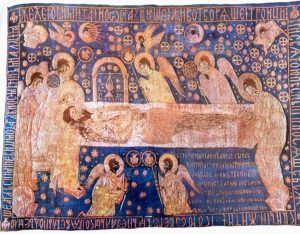
The so-called “Blue” epitaphios from the Trinity-Sergiev Lavra [Illustration 2] belongs to the same style of “goldwork embroidery.” Based on the paleography of the inscription, which contains 14th century elements, M.V. Schepkina dates this item to the very beginning of the 15th century.[31]This attribution was made in 1949 by request of the staff of the Zagorsk museum. This allows us to refer to this item as the earliest of the Russian epitaphia that have survived to modern times. Its composition depicts one of the earliest forms of the “Lamentation of Christ,” which appears to have been adopted directly from Byzantium. We also find the fountain motif, completely covered in stars and crosses inside circles, in earlier Byzantine examples.[32]For example, in an epitaphios from the time of Andronicus II Palaeologus (Byzantine emperor 1282-1328) from the Church of St. Kliment in Okhrid. See: Miljukov, P.N. «Khristianskie drevnosti zapadnoj Makedonii.» Izvestija Russkogo Arkheologicheskogo instituta v Konstantinopole, Vol 1, Issue 1. Sofia. pp 93-94, illus. 30.
Several examples of 15th century embroidery are similar to the “Blue” epitaphios in composition, general style and technological methods. These include the so-called “Euphemius” epitaphios donated in 1456, according to its inscription, by the Grand Prince Vasilij Vasil’evich to Archbishop Euphemius of Novgorod’s St. Sophia[33]Now located in the Novgorod Museum [2130]. See: Svirin, A.N., p. 39, and also two epitaphia in the Russian Museum.[34]One of these epitaphia was received from the Kirillo-Belozersk Monastery, now in the Russian Museum [281]; the other from the Arkhangelsk Medieval Repository, also now in the Russian Museum [280].
Among these works, the “Blue” epitaphios stands out for its emotional mood, particular to works of the 14th century. This feeling is created primarily by the asymmetry of its design, the center of which is drawn to the left, toward Christ’s head. The tension is also created by the fountain replete with stars, the dynamic poses of the angels which seem to gravitate in unison toward Christ, the restless silhouette of their hair, and His anguished face with its furrowed brow. The slender, narrow-shouldered and strongly elongated proportions of the figures stand out clearly against the blue background. The monotone of the gold embroidery is broken only by the red stitches which mark the contours and folds of the clothing and which underline the silhouette-like nature of the design.
The “Blue” epitaphios and similar works, and by analogy the the goldworked cuffs of Varlaam of Khutyn, are generally considered to be Novgorodian.[35]V.N. Lazarev. Iskusstvo Novgoroda. Moscow-Leningrad, 1947, p. 130; A.N. Svirin, pp. 34-36. The author of this work also has determined these to be Novgorodian. See: N.A. Majasova. «Khudozhestvennoe shit’jo.» Troitse-Sergieva Lavra. Khudozhestvennye pamjatniki. Moscow, 1968, pp. 117-118. But, evidence from the Chronicles and from extant works of goldwork embroidery from various Russian oblasts require us to reconsider this attribution. The lack of Novgorodisms in the inscription on the items listed above, a chronicle which mentions the donation of the “Euphemius” epitaphios by the princes of Moscow, the refinement of the design, the perfection of technique in the goldwork embroidery, and the opulence of the very material lead us to the opinion that the “Blue” epitaphios, just like the “Euphemius” epitaphios, originated from the workshop of the Grand Prince of Moscow. This theory is confirmed by a recently discovered epigonation from 1439, attributed to Princess Ul’janija, daughter-in-law of Vladimir the Bold.[36]cf. N.A. Majasova. «Pamjatniki moskovskogo zolotnogo shit’ja XV veka.» Drevnerusskoe iskusstvo. Khudozhestvennaja kul’tura Mosckvy i prilezhaschikh k nej knjazhestv XIV-XVI vv. Moscow, 1970, pp. 488-493.
Not as highly valued as gold embroidery, and more susceptible to destruction, items embroidered in silk have survived in lesser quantities. The earliest of these, dated to the end of the 14th century, attests to a great blossoming of silk embroidery at that time, which appears to have existed previously alongside goldwork embroidery, and which became widespread in the 15th century.
If goldwork excels in the silhouette-like style of its design and the flatness and monotonality of its rendering, embroidery with multicolored silks allowed the depiction of depth and to display subtle nuances of color transition, and to draw attention to what was most important. This embroidery is, to a larger degree than goldwork, tied to icon-painting and fresco, and it is not without reason that the French researcher G. Mille referred to it as “needle painting.”

Such works include the embroidered depiction of the All-Merciful Savior with the Forthcoming from the late 14th century [Illustrations 3, 4].[37]This item has been incorrectly called “The Supreme One on His Throne” (cf. V.N. Lazarev, p. 129; A.N. Svirin, p. 27). These same authors also attribute it to 14th century Novgorodian art. On the original ground, which has not survived, there were likely donor and liturgical inscriptions. Today, the work appears as a large square veil. The images of the Savior and those surrounding him are placed not in the center, but rather a little lower, while the evangelists are embroidered writing in the four distant corners. This placement of the figures and the general size of the veil lead us to think that the served as the front part of an altar cloth.[38]Cf. a throne cover, similar in composition, donated by the Godunovs to the Trinity-Sergiev monastery (illus. 53).
The Savior, in light blue and silver robes, solemnly sits on a semi-circular throne. His figure, which is sharply elongated in proportions, is several times larger than those of his followers. The divinity of the Savior is underlined by the seraphim and cherubim which shade him with their wings. The Holy Mother and John the Baptist’s heads are inclined toward Him in prayer, and their hands are outstretched. The row of followers is rounded out by fine, slender archangels in Roman-style robes [Illustration 4].
The color scheme is dominated by light blue, dark blue and yellow silk in combination with silver and gold. In the proportions of the figures, the form of the archangels’ wings, and in the unusually curved legs of the Savior’s throne and of the evangelists’ desks, and in the ratio of colors, we can feel the sophisticated taste and familiarity the artist had with the greatest works of Christian art.[39]A.N. Svirin finds an analogy to the archangels in this work in mosaics of the latter half of the 13th century in the Church of San Gregorio in Messina (cf. A.N. Svirin, p. 27). The inscriptions in Cyrillic letters convey with errors the Greek names: “IS XS Elemoön” (Jesus Christ the Savior), “prdmro” (Prodromos-the Forerunner).[40]A Byzantine cameo from the 11th century with a bust depiction of Christ with the Evangelists is preserved in the Hermitage, with a Greek inscription: “IC XC OELENMON”; on the reverse, also in Greek: “Christ Our Lord, he who trusts in you shall not be deceived” (cf. A.V. Bank, Vizantijskoe iskusstvo v sobranijakh Sovetskogo Sojuza. Moscow-Leningrad, 1966, no. 167-168). The title “Savior” rather than “the All-Mighty”, is suitable to the composition, which is presented as a small Deësis rank, in which “Christ appears not in the form of an apocalyptic Ruler of the World, that is, as a terrible judge, but instead as a kind Savior, called to save humanity”[41]V.N. Lazarev, p. 75. Churches were also dedicated in Rus’ to the All-Merciful Savior. For example, a chapel is dedicated to him in the Transfiguration Cathedral in the Moscow Kremlin. The chronicles mention it in relation to the burial there in 1396 of Stefan of Perm. PSRL, vol. XI. Moscow, 1965, p. 164. The Greek-sounding nature of the inscription and the composition, which is solemn and full of refined grace, suggest there was some similar Byzantine original. It is quite possible that this “All-Merciful Savior,” having no analogy in Novgorodian art and yet at the same time responding to its Grand Prince surroundings, was created in Moscow in the second half of the 14th century and was given to Novgorod as a royal gift.
It is worth noting that in this item, the Deësis composition is shown full-length; today, as in medieval Russian painting, especially applied art and ecclesiastic embroidery, half-length figures are seen since the early 15th century.[42]For example, a 12th century tiara from Kiev (cf. Istorija kul’tury Drevnej Rusi, Vol. 2. Moscow-Leningrad, 1951, p. 418), or the 12th century cuffs of Varlaam of Khutyn (cf. A.N. Svirin, p. 25).
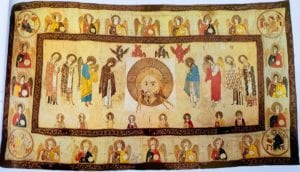
A Deësis composition with eight figures standing before the image of the Savior Not Made By Hands[43]jeb: Also known as the Image of Edessa, or Mandylion. was also embroidered in the late 14th century on an Aër which has a certain stylistic similarity to the “All-Merciful Savior.”[44]It is worth drawing our attention to the proportions of the figures of those standing before Christ, the elongated form of several of their heads, and on other details. The inscription on the Aër attests to its creation in 1389 by Grand Princess Marija Semyonovaja [Illustrations 5, 6]. This is the earliest of the dated works of Muscovite embroidery to have survived to our time. The donor of this Aër was the daughter of the Prince of Tver Akeksandr Mikhajlovich and the third wife of Grand Prince Simeon the Proud. Having been widowed at a young age, the Princess died of old age[45]Marija was married in 1346; Simeon died in 1353 during a plague epidemic. in 1399 having “taken the black” and the name Fetinija, and was buried in the Kremlin in Spassky Monastery, the main cathedral of which was painted and decorated at the direction of Simeon’s first wife. It is possible that Marija also donated her veil with the image of the Savior to this church. The inscription recalls her wordly name, based on which we can determine that the Aër was embroidered before she took orders and was created in the Grand Prince’s workshop.
The creator of this veil, the daughter of a prince who came out against the violence of the Khan’s legate and who was killed for it by the Horde, managed to express in her work the thoughts and senses felt by the people who had just survived the Battle of Kulikovo and the siege of Moscow by Tokhtamysh. The stern face of the Savior is reminiscent of the battle flags which often portrayed his likeness during that time.[46]The researcher of medieval Russian flags, L. Jakovlev, notes that the first example of this depiction of the Savior’s face on banners, and even the first use of the word znamen’ (rather than the more ancient word stjag) for “flag,” is found in a description of the preparations for the Battle of Kulikovo in “The Doings and Tales of the Massacre of Dmitrij Donskoj”: “… And the Grand Prince, arrayed with his Polish soldiers … went out to the high place, and saw the image of Christ depicted on the Christian banners, shining like the sun.” (Drevnosti possijskogo gosudarstva. Addendum to the third edition. Moscow, 1865, p. 17) Among those who pray to Him are the Muscovite metropolitans and the holy Russian warrior-princes Boris and Gleb. Among the half-length figures in the central section in the right corner, next to the images of Dmitrius of Thessaloniki and Prince Vladimir, are the labeled holy heroes of the Battle of Kulikovo, Dmitrij Donskoj and Vladimir Andreevich the Brave. Here too is embroidered the martyr Nicetus the Goth, the famous vanquisher of demons, which the Russians associated with the infidel and evil enslaving Tatars; and another champion against demons and heretics, the recognized defender of the Russian clans from foreign invaders, St. Nicholas.[47]Aside from these depictions, we also see embroidered here: the creator of the liturgy Gregory the Theologian, and, in an Orans pose with his hands raised in prayer, St. Alexius of Rome, whose Life was associated with the cult of the Savior Not Made By Hands. Contrary to the statement by the first researcher of this Aër, V. Trutovskij, about the image of the Savior being a supposedly later work (Khudozhestvennye sokrovischa Rossii. Vol 2. St. Petersburg, 1902, p. 125), detailed surveys have shown that the Savior was embroidered contemporaneously to the rest of the veil. Along the outer edge, there are the solemn figures of triumphant Heavenly warriors – angels and archangels – as protectors of the people in their battle with the forces of evil. Between these figures, fragments of an inscription are preserved, speaking of “glory in Heaven and on Earth.” This entire work, with its solemn composition, symbolic images and inscriptions, and festive color scheme, is permeated by the belief in the victory of light over the dark forces of evil.
In addition, this notable monument to the heroic epoch of the battle against the Tatar-Mongol yoke and the creation of Russian nationhood attests to the rich traditions which up to this time were held by the art of medieval Russian embroidery. The embroideresses were able to convey with great mastery the subtle, expressive face of the Savior, the light, graceful figures of those standing before Him, and the picturesque poses of the Evangelists. The strong, rhythmic form of the composition and its restraint are emphasized by the dark-violet stripes with their thin golden patterns and the precise alternating colors of the angels’ clothing around the edge. The color scheme around the edge is more saturated than in the center. Here, cinnabar and cornflower alternate with yellow and purplish-brown, rather than the pale yellow and white images in the center. These create a certain artistic expressiveness. This major scale of color underlines the work’s epic, solemn content.
The rise of national identity following the Battle of Kulikovo had a huge impact on the creative forces of the Russian folk. Medieval russian embroidery, as well as icon-painting, increasingly begins to deviate from the traditions of Byzantine art.
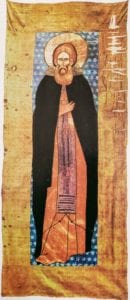
A veil with the image of Sergius of Radonezh [Illustrations 7 and 8], typically dated to 1422-1424, that is, immediately after the saint’s canonization, holds a special place among the monuments of this period. Amongst burial veils, most of which are stored in various museums in our country, this veil stands out for its individual interpretation of form and for its technique of embroidery, which was unusual for this time period.
Sergius’s large head is somewhat assymetrical, as if slightly turned to the left, while the face points forward. The hair, forming a sharp angle on the forehead, is parted, divided into strands which cross over his head. The face has high cheekbones, with a large forehead and sunken cheeks. Beneath his thick, almost straight eyebrows, are his close-set, narrowed eyes. The smart, insightful gaze of these peculiar eyes produces an indelible impression. The undeniable individuality of the interpretation of the face suggests the direct perception by the artist, a certain portrait-ness in form. It is evident that Sergius’s face had such characteristic, unique features that it was well-remembered by those who saw it. It is possible to suppose that he was also seen by the artist, who conveyed his likeness with rare artistic skill.[48]The 30 years separating the Sergius’s death (1392) and the creation of this veil do not preclude this possibility. Applying the split stitch which was typical for Russian embroidery, the artisan sculpted the form like a sculptor using large stitches, arranging them along the direction of the muscles, introducing darker threads in shaded areas, a technique which became more widespread in Russian embroidery later, in the 16th century. The artisan also created here singular highlights; on the forehead and cheeks, she placed stitches of red thread, and drew with red thread the lines of the nose and lips, and filled in the folds of the ears. Just as picturesquely, she depicted the beard and hair of the saint using silks of various tones – flesh-colored, grey and brown. Despite the techniques of silk embroidery which were rare for this time period, this veil should be attributed to the first quarter of the 15th century, when there were still those alive who would have remembered Sergius.
This is further supported by our very understanding of the image, and our attention to the inner essence of the subject, characteristic of the time of Andrej Rublev, Theophanes the Greek, and their “associates.” It is necessary to dwell on methods such as the red outline of Sergius’s nose, which call to mind the faces from the Deësis in the Cathedral of the Annunciation in the Moscow Kremlin. Moreover, the unique interpretation of Sergius’s head and face are very similar to the depiction of Abraham in the 1408 fresco “The Bosom of Abraham” in Vladimir’s Cathedral of the Assumption, considered to be the work of Daniil the Black.[49]I.E. Grabar’. «Andrej Rubljov.» Voprosy restavratsii. Iss. 1. Moscow, 1926, p 71, illustration on p. 35; V.N. Lazarev. Andrej Rubljov i ego shkola. Moscow, 1966, p. 103; et. al. Scholars have pointed to Daniil’s tendency toward “the expressiveness of literally portraitlike characteristics of the persons portrayed”[50]S.S. Chudrakov. «Andrej Rubljov i Daniil Chjornyj.» Sovetskaja arkheologija. 1966 (1), p. 100. From 1424-1427, the years to which we attribute the creation of this veil, Andrej Rublev and Daniil the Black, along with their school, painted the frescos and icons in the Trinity Cathedral, at the invitation of Nikon of Radonezh. This evidence allows us to suppose that perhaps it was Daniil, the oldest of the masters and artel of artists working in the monastery, who served as the lead icon-painter for this first veil in honor of Sergius’s tomb.[51]In the literature, we frequently find the idea that the lead icon painter may have been the nephew of Sergius, Fedor, the archimandrite of the Simonov monastery; or they suggest it was Archbishop Rostovskij, who according to legend painted a likeness of Sergius while the latter was still alive. No works by Fedor have survived against which we could compare this veil, and we have only descriptions from the 17th century («Skazanie o sv. ikonopistsakh» from the so-called «Klintsovskij podlinnik» – cf. F.I. Buslaev, Literatura russkikh ikonopisnykh podlinnikov, Vol II. St. Petersburg, 1910, p. 396). As a result, the aforementioned theory seems, in our opinion, much more likely. It is entirely likely that the donor of this veil was Prince Jurij Dmitrievich of Zvenigorod, Sergius’s godson, who donated the primary funds for the construction of Trinity cathedral and who lobbied in support of the saint’s canonization.[52]There is evidence that Prince Jurij’s wife embroidered the chasubles for Nikon of Radonezh and Savva of Storozhi (Archbishop Leonid. Zhizneopisanie pr. Savvy Storozhevskogo. Moscow, 1877, p. 12)

A small embroidered icon of St. Demetrius of Thessaloniki [Illustration 9] also belongs to this circle of Muscovite art, completed by artisans in the same vein. The saint is shown in 3/4 profile to the right in a pose of prayer. It would appear that this was part of a small iconostasis. Such embroidered iconostases, lighter and more convenient to transport than paintings on wood, were taken along on military campaigns and distant journeys. An embroidered iconstasis belonging to Tsar Feodor Ivanovich has survived,[53]The iconostasis is stored in the Russian Museum [314-322] (cf. E. Kutilova, «Vnov’ restavrirovannyj pamjatnik XVI v.» Soobschenija Gos. Russkogo muzeja. Iss. 1. Leningrad, 1941, p. 17; Ju.N. Dmitriev. «K istorii odnogo pamjatnika.» Soobschenija Gos. Russkogo muzeja. Iss. 4. Leningrad-Moscow, 1956, p. 5); it later became part of the “marching canvas church” of Aleksej Mikhajlovich.[54]A.I. Uspenskij. Zapisnye knigi i bumagi starinnykh dvortsovykh prikazov. Moscow, 1960, pp. 2, 15, 74-76. The icon of Demetrius of Thessaloniki is the earliest example known to us of this kind. Demetrius’s entire pose, including the slightly bowed head and upper portion of his torso, his outstretched arms, and his bent knees, create an expression of humble prayer. His form is treated very softly. His movement is graceful. The figure with its narrow shoulders seems a bit elongated in its upper half, creating a feeling of fragility and a certain refined grace. His clothing falls in soft folds, easily and loosely drawn in brown silk. The color scheme is based on a combination of whitish-flesh colored and yellow silk with blue spots, giving it a festive tone and a sense of light.
The figure’s overall silhouette, posed legs, and the arrangement of the folds of clothing recall the depiction on an icon of the same name from the Deësis row in the Trinity Cathedral in the Trinity-Sergiev Monastery.[55]cf. V.N. Lazarev. Andrej Rublev i ego shkola, illus. 178. It is entirely possible that the same artist, a close disciple of Andrej Rublev, was also the lead iconographer for this embroidered Demetrios.
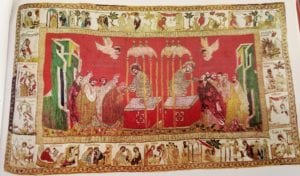
Among the outstanding works of medieval Russian embroidery are also the so-called “Suzdal'” [Illustrations 10, 11] and “Rjazan'” [Illustrations 24, 25] Aërs which depict in their centers the communion of the apostles with wine and bread, and on their edges, scenes from the Lives of Joachim, Anna and the Mother of God. The content and order of images on both Aërs are identical, which led their first scholar, V.N. Schepkina, to suppose that they were both based on an original work of south-Slavic origin: an embroidered Aër, several times larger, created for the well known Church of the Annunciation.[56]cf. V.N. Schepkin. «Pamjatnik zolotnogo shit’ja nachala XV v.» Drevnosti. Trudy IMAO. Vol. XV, issues 1-2. Moscow, 1894, pp. 35-68. The south-Slavic origin of the original work, according to V.N. Schepkin, can be seen in the inscription, and the name of the church from the last frame of the Life, which says “Annunciation” [«Blagoveschenie»].
The Suzdal’ Aër has an inscription which indicates that it was created for the Church of the Nativity of the Holy Mother in Suzdal’ by Konstantin’s Ogrofena “in the year 6900”. The last digit of the date remained unembroidered. A reference in the inscription to Metropolitan Fotius and Grand Prince Vasilij I clarify its date to 1410-1425; at the same time, Mitrofan, the bishop of Suzdal’ who is also mentioned here, is not mentioned anywhere after 1416. Considering the delay in Fotius’s activities as metropolitan, it makes sense to date this Aër to the years 1410-1413.
The name of the creator of this veil has so var remained unsolved. It is worth noting that she is here called by her husband’s name, “of Konstantin”, without a patronymic. It would seem that Konstantin was a well-known person in his time. And yet, in contrast to the inscription on the work above by Marija Semenova, which lacks the princely title, and only above the line is found the frequently seen and, it seems, almost-forgotten modest phrase “Servant of God”.[57] The name Konstantin was held by the son of Dmitrij Donskoj, who died childless in the Simonov monastery around 1440. But, his wife, who died in 1419, was named Anastasija. Whether or not he was subsequently married to another or who that second wife might have been is unknown. The names of the wives of other historical persons with this name are also unknown; for example, those of Prince Konstantin Vladimirovich of Rostov (died 1415) or Konstantin Dobrynskij. V.N. Schepkin’s supposition that Ogrofena was simply an artisan, and that the artist’s name is mentioned in the place of the donor, if they were not one and the same person, is not supported.
The Aër depicts the scenes of the Childlessness of Joachim and Anna and the birth of Mary, whose fate is followed through to the Annunciation, imbued with such sincerity of feeling that it is not possible to this as merely a blind copy of some prior work. It is entirely likely that this Aër was donated to the church, as was often done, as a prayer for childbirth. With the content following the apocryphal Protoevangelium of James,[58]I.Ja. Profir’ev. Apokrificheskie skazanija o novozavetnykh litsakh i sobytiakh. St. Petersburg, 1890, pp. 136-148. bringing us living pictures of the everyday life of the Jewish people, the artist and embroideress have given the work a purely Russian sincerity peculiar to Muscovite art of the first quarter of the 15th century. Particularly well executed are the scenes: “Joachim’s Exile in the Desert,” where Joakim, turning slightly, looks sadly at the weeping Anna; the scene where a servant coaxes Anna to stop her complaining and to put on a “bandage” (head band) and wedding robes; the “Conception”, where the artist emphasizes the spouses’ resurrected hope in their rush toward one another. But particularly solemn are the scenes of the “Caress” and “Arrival” of Mary. Here we see the delighted joy of the parents, their care for the baby, and the child’s first steps.
It is worth noting that the embroidery is carried out with relatively large stitches in split stitch, the lines of the faces are generalized, and upon closer inspection, as is often seen with works of this style of art, some figures and faces seem a bit primitive; but the embroideress has managed to convey superbly the overall design, roundness of line, grace of movement, tenderness, and a sincerity in the treatment of each separate figure, as well as of the entire composition. There is every reason to believe that the main icon-painter was a Muscovite and belonged to the artistic school of the marked genius Andrej Rublev. This is seen not only in the general orientation of his art, but also in the similarity of specific details in this Aër to other works by that school. For example, in terms of composition, the central section of the Aër is reminiscent of the Gate of the Assumption and of an icon in the Trinity iconostasis.[59]V.I. Lazarev. Andrej Rublev i ego schkola. illus. 152, 153, 154. Moreover, the style of the apostles and the general proportions of their figures is also very similar. Joachim and his characteristic head, with its slightly lowered brow, seems to have been based on a fresco in the Cathedral of the Assumption in Vladimir.[60]ibid., illus. 60, 90. There we may also find analogies for the architectural elements and for the trees, which resemble spreading palms.[61]ibid., illus. 116. Exquisite, balanced compositions, pictorial color schemes, lively and moving handling of subjects and images place this “Suzdal’ Aër” amongst the best of the works of Muscovite art of the first half of the 15th century.

The podea [pelena], or more correctly, veil [pokrovets],[62]This appellation is based on its size, similar to that of another embroidered “Trinity” from the Godunov workshop which is called a sudarium [sudar’] in the inventory of the Trinity-Sergiev Monastery from 1641 (pp. 96 and 96 obv.), but which in subsequent inventories was called a “veil [pokrovets] with the head of Sergej” (cf. archive of the Zagorsk Museum) depicting “The Trinity, with Holidays” [Illustration 12] was undoubtedly created under the artistic influence of Andrej Rublev. The artist strove to convey the same composition and general tone of Rublev’s work, and the same pensive grace of its figures. A certain similarity in the form of the angels, proportions of the figures, and crease of the clothing is noticeable. At the same time, this embroidered “Trinity” is not a direct copy of an icon. The angels are no longer sitting in a tight bunch, nearly touching one another. The distance between them has increased, and the table has grown longer, somewhat violating the roundness of the entire composition. Much attention has been given to the details of this podea. The chambers, hills, and the Oak of Mamre take up a large area here. On the table, instead of one chalice, there are three, along with a salt cellar and loaves of bread. The color scheme also diverges from that of Rublev. The color of clothing is packaged differently. Between the angels, remnants of a dark-green hill are visible. The ground for this podea was originally a dark-brown damask.[63]In the 18th century, the images were cut out along their edges and transferred onto a crimson velvet. During restoration in 1951, it was replaced with a rough blue crash. In comparison to an icon, the color scheme on this podea is of heavier and more saturated tones.
The images on the outer border of the work also have a certain compositional similarity to works created by Rublev and those working in his atelier. Parts of it mirror the icons in the Cathedral of the Annunciation in the Moscow Kremlin; other parts, the Trinity Cathedral. It would seem that these and other compositions were in common use amongst Muscovite artisans of the 15th century. We consider it possible to date the podea to the second half of that century, when similar variants of the Rublev “Trinity” were circulating throughout Muscovite art.[64]This author does not agree with the opinion of V.I. Antonova, who dated this work to the very beginning of the 15th century and believes that the artist who drew this icon was Andrej Rublev himself, who created here the first draft of his “Trinity” («O pervohachal’nom meste “Troitsy” Andreja Rubleva.» Gos. Tret’jakovskaja galereja. Materialy i issledovanija. Issue 1. Moscow, 1956, pp. 26-30.) See the icons depicting this variant of the “Trinity” in the Andrej Rublev Museum: one from Borodava near Kirillov from 1486 [item 54], one from Volokalamsk from the 1480s [item 21], and one from Uglich [item 106] one from Aleksandrov from the early 16th century, et.al. The artisan who embroidered this work has given particular attention to the central image, and with rare artistic skill has conveyed the artist’s subtle design. The images on the border are worked a bit more roughly, with faces and other details worked in a generalized manner.
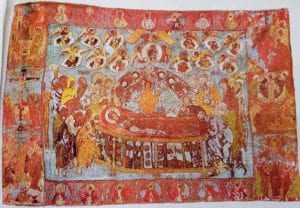
Another depiction of the “Trinity”, similar to the podea above and combined with the holidays in the same order but with different variations, attributed to the circle of Russian artists of the early 15th century, was embroidered onto a podea from the Our Lady of Vladimir Monastery [Illustration 13]. The center of this podea depicts the so-called “Cloudy Dormition.” The composition is oriented horizontally, and is very saturated in color. Around a long bed, the apostles and women stand in two large groups. The sky is full of angels which bear the Holy Mother and apostles aloft on clouds. This is reinforced by the saturation of color in this podea, which was originally dominated by violet-brown, cherry and raspberry tones.[65]This impression is broken by the gaps in the original ground fabric, a brown damask which was replaced with a light blue rough fabric during restoration. Stylistic details of the work, its iconographic similarity of its composition to Muscovite art, the proportions of the slender figures, and the soft expression of the faces all speak to its Moscow origin.
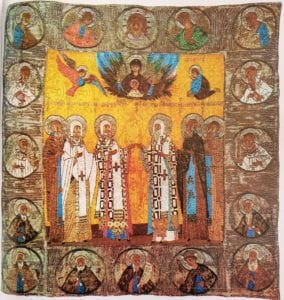
Two other podeai are similar to the “Dormition” podea above. On one of these [Illustration 14], the center depicts two groups of saints standing in prayer across from one another. Above them is embroidered “Our Lady of the Burning Bush” in a relatively uncommon variant, with “Our Lady of the Sign” shown in front of the burning bush. To the right is Moses, kneeling and removing his shoes; to the left is flying angel. The upper border depicts a Deësis composition with Our Savior Not Made By Hands in the center. It is notable for its lack of the Holy Mother and John the Baptist. Below are embroidered a number of saints and Russian clergymen, including Varlaam and the Prince Ioasaf.[66]jeb: According to the tale, Ioasaf or Jehosaphat was a Prince of India whom Varlaam convinced to become a Christian. This story was quite popular in medieval Russia, and can be found on many icons.
Another podea [Illustration 15] depicts Sergius of Radonezh and his student Mikhej’s vision of the Holy Mother and Sts. Peter and Paul. The composition portrays a relatively common variation of this subject, with Sergius on his knees.[67]N.A. Majasova. «Masterskaja khudozhestvennogo shit’ja knjazej Staritskikh.» Soobschenija Zagorskogo muzeja-zapovednika. Iss. 3. Zagorsk, 1960, p. 54. Sergius is shown at the very feet of the Holy Mother, who slightly bows forward, as if wanting to lift him up. A surprised Mikhej impetuously leads out of the cell window. These details give the scene life and a certain immediate warmth. The composition of the border almost completely duplicates that of the aforementioned podea, except amongst the half-length images, here we have the full-length figures of Sts. Nicholas and John Chrysostom, the latter of whom was likely the name day saint of Grand Prince Ivan III.

Both podeai are embroidered in multi-colored silk on a bright-yellow damask, and are very portrait-like. The figures have the thin, slightly elongated proportions that were common in Muscovite art of the last quarter of the 15th century. The Muscovite origin of these podeai is attested to by the very subject of Sergius of Radonezh and the selection of saints which were particularly honored at that time in Moscow. These include the Moscow Metropolitans Pjotr and Aleksej, Leontij of Rostov, Sergius of Radonezh, Varlaam of Khutyn, Savva Visherskij, and Dmitrij Prilutskij. The podeai were undoubtedly produced in the same workshop in the second half of the 15th century. The works’ style and character of design, the composition of the border scenes, the tracing of the inscription, the color scheme, and technical methods all attest to this. It is also likely that the “Dormition” podea also came from the same workshop. Although it has a completely different color scheme, it resembles the podeai listed above in its design of elongated figures, lifelike poses, and the tender facial expressions. Particularly similar are the half-length figures of the saints on the borders, the spaces between whom are filled with inscriptions which are carried out in almost identical calligraphy. It also should be mentioned that on all three podeai, the faces were worked in one and the same unstable silk, which in places has darked to a shade of brown.
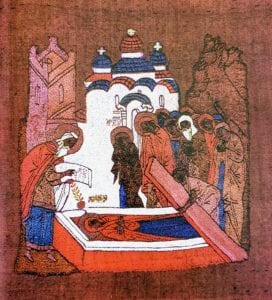
A different artistic direction is seen in a small podea with a composition of “The Burial of St. Anne” rarely seen in Rus’ [Illustration 16]. The artist strove for a particular concretization of details. The moment of the burial is extremely precise: a priest reads the last rites just as the tomb is covered with its lid. Instead of the stylized basiliciform or stepped buildings common to the majority of icons painted in the 15th century, a white-stoned, single-blocked temple with three domes rises behind the crowd. There is even a roof over the door, supported by curved brackets atop two pillars. Particularly expressive is the figure of the weeping Holy Mother, who is draped in a brown maphorion. She is a bit separated from the crowd and the other women follow a bit behind her. This serves to focus the viewer’s attention upon her. Her grief is underlined by the standing row of sorrowful figures with bowed heads. The artist and embroideress carried out this main element in colored accents: the red maphorion on Anna in the tomb and the dark silhouette of the Holy Mother against the surface of the white walls of the cathedral. The cathedral occupies such a significant place that it suggests it was inspired by a particular structure, possibly the newly built Moscow Cathedral of the Dormition (1479), which it resembles. It would seem that the podea was created in Moscow in the last quarter of the 15th century. As evidence for this dating, we have the well-known narrative and concretization of development and the shape of the temple, which is not found in earlier works.
There are also significant works from the Novgorod school extant from the 15th century. There is an array of works tied to the name of the Archbishop Euphemius II (1429-1458). Euphemius is historically famous for his construction of buildings. Under his leadership, many churches, the clock tower, the Palace of Facets, and the Archbishop’s Palace in Novgorod were constructed or renovated, and decorated with paintings or icons. He was the ktetor of the Vyazhitskij and Khutynskij Monasteries. Most likely, Euphemius also ordered works of embroidery from a workshop in one of the female monasteries under his ward. In 1439, Archbishop Euphemius “gilded the tomb of Prince Vladimir Jaroslavich … and ordered and presented a veil; and also likewise decorated his mother’s grave.”[68]Novgorodskie letopisi. St. Petersburg, 1879, p. 139. The museums of the Moscow Kremlin house the so-called “Puchezh” Epitaphios,[69]The Kremlin Museums, no. 18652 op. The name of the “Puchezh” Epitaphios comes from the town of Puchezh, in the Novgorod region, where it was discovered in 1930. It has been published many times (cf. Der Moskauer Kreml die Rüstkammer. B.A. Rybakov und Mitarbeiter. Prague, 1962, illus. 86, 87).[70]jeb: See my translation of an article about this work, along with photographs: The Puchezh Epitaphios of 1441 and Novgorodian Embroidery in the Time of Archbishop Euphemius II with an embroidered inscription: “In the year 6949 [1441] the creation of this veil: was ordered: by the venerable archbishop of Novgorod the Great, Lord Euphemius. Amen.” This work is of particular interest due to its picturesque style. In the clothing here, one color gradually transitions into another. The light blue fabric has dark blue tones in the folds, and lightens to white in highlighted areas. Light brown silk is combined with light yellow and dark brown; yellow, with dark and light green. The picturesque style is also seen in the “peacock eyes” in the angel’s wings, and in the floral-covered ornamentation of the benches. Very similar in both composition and artistic technique to the Puchezh Epitaphios is another epitaphios from the Khutynskij monastery, which quite likely was created by the same artist.[71]This item is now in the Novgorod museum [2132] (cf. A. Svirin. “Une broderie du XV siécle de Style pittoresque.” L’art byzantine chez les slaves. Paris, 1932, table X.2; A.N Svirin. Drevnerusskoe shit’jo, p. 38).
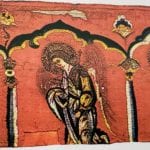
Euphemius’s atelier also produced the famous “Deësis Row” [Illustrations 17, 18][72]The “Row” was located in the Trinity-Sergiev Lavra and is listed in the earliest surviving inventory, from 1651. The fact that Euphemius II was well known as an opponent of Moscow, it would seem, should have precluded it from being donated to a monastery in the Moscow region. It is possible, however, that it was a reciprocal gift for the epitaphios of Grand Prince Vasilij II the Blind, the inscription of which specifically mentions its addressee – Archbishop Euphemius. It is also possible that the “Row” came to the monastery among other works of art captured from Novgorod by Ivan the Terrible. The “Row” has not survived in its entirety. The lower part of the figures is cut off, the border which, most likely, contained the donor inscription is missing.[73]jeb: The Deësis Row is a part of the iconostasis in an Orthodox Christian church. It is typically located immediately over the Royal Door through the iconostasis, with Christ sitting immediately over the door, flanked by the Virgin Mary and John the Baptist, often along with other saints or angels depicted in full-length. In this case, the Deësis Row was presumably part of a larger embroidered iconostasis. The ethereal figures of the “Row” are placed in graceful pictorial frames with lush flowers in the corners. In the center, the Savior is seated on His throne; on either side of him stand the Virgin Mary, John the Baptist, the archangels, and the apostles Peter and Paul. This canonical grouping is completed by the especially revered Archbishop Euthymius The Great and John the Theologian, who were his name day saints.[74]In their honor, Euphemius II built and decorated two churches: in 1439, the Church of St. John the Theologian in Vjazitskij Monastery, and in 1445, a chapel to Euthymius the Great in the entry hall of his palace.
That this “Row” should be attributed to Euphemius’s workshop is supported not only by its selection of saints, but also by the general pictorial style of this work, which is similar to that of the Puchezh Epitaphios. Here too, we see the same gradation of colors, the same subtle transitions from light to dark. Moreover, here this artistic technique has reached its greatest resonance. Fancy bell-shaped arches, resting atop pillars with unusual flower-shaped capitals, growing from them out of them on curved stems, and the lush and subtle flowers create a fabulous environment for the subtle, slender figures of the figures, clothed in robes which almost seem to be iridescent in the sun’s rays. A feeling of spring-time joy, glistening in all of the colors of the rainbow, emerges from this extraordinary work. The singular style of the Euphemius workshop, which researchers have called “pictorial”, did not receive any greater development in Russian embroidery. It is true that few works from the 15th century in this style[75]Two epitaphia in this “pictorial” style are stored in the Novgorod Museum [2131, 2097]. One one of them, amongst the images on the border, are embroidered the Novgorodian saints Nicetas the Goth and Jonah, who it would seem were the name day saints of the donor-martyrs Kondratij and Tat’jana. One more less skillfully-worked epitaphios is stored in the Russian Museum [195].have survived, but in the mid-16th century, several echoes of this pictorial style are seen in one of the epitaphia from the workshop of Princess Evfrosina Staritskaja, which incorporates the best traditions of the art of medieval Russian embroidery [Illustration 44].
D. Ainalov ties the appearance of this style in Novgorodian embroidery in the 15th century to Western European influences.[76]D. Ainalov. Geschichte der russischen monumentalkunst zur Zeit des Grossfürstentums Moskau. Berlin and Leipzig, 193, p. 117. Certainly there does exist in works of western medieval embroidery a light-and-dark style, a technique which was taken from portraiture. The Novgorodians’ familiarity with this art cannot be ruled out, as Novgorod had undertaken extensive trade relations with its neighboring states since ancient times, and Archbishop Euphemius had German artisans who worked alongside his Russian masters. But this acquaintance could only enrich the traditional methods of medieval Russian embroidery to a certain extent. Despite its great originality, Euphemius’s “Row” does not vary far from the general circle of Russian works of art. This is attested to not only by the accepted Russian iconography, but also the technique of embroidering in silk split stitches and in couched spun gold threads which was common to Russian embroideresses, in the form of the keeled arches which were widespread in 15th century Russian architecture, and even in the flowers, encountered in icons[77]The same sprigs with fringed leaves as on the last columns in the “Row” are also found on the mid-15th century Novgorodian icon “Daniil in the Lion’s Den” (Novgorodskij istoriko-arkhitekturnyj muzej-zapovednik. Leningrad, 1963, pp. 10, 30). Here too, the leaves have the same gradation of color from dark blue to light blue and white. The similarity between the “Row” and this icon can also be seen in how the clothing and various details of the figure of Daniel have been worked. It is possible that here we have two works from artists from the same school. and frescoes and which have ties to Russian folk art. The overall structure of this work is also accordant with that style.
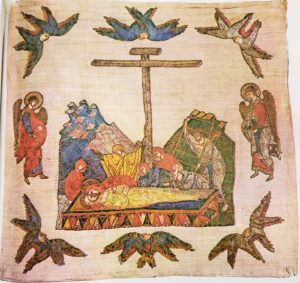
No works of Novgorodian embroidery dated to the second half of the 15th century have survived to modern day. But, it would appear that a small podea with a depiction of “The Entombment of Christ” [Illustration 19] belongs to that time. This work is especially pictorial. The action unfolds in front of a backdrop of hills, which to the left are light blue and to the right are green. The clothes of Christ’s mourners and of the angels are of bright local colors [«lokal’nye tsveta»]. The tomb is decorated with flower petals. The composition of the podea is reminiscent of an icon of the same subject, typically attributed to the Novgorod school of painting.[78]V.I. Antoneva, N.E. Mneva. Katalog drevnerusskoj zivopisi. Vol. 1. Moscow, 1963, Nos. 102 (illus. 73), 106 (illus. 76). Here we see the same cast of characters, the same pathetic pose of the Magdelene, Christ’s body swaddled like a mummy, and the same hills with their squarish summits sticking up. The detailing is also characteristic for Novgorod – the cross reminding us of recently completed events, the ladder which Nicodemus busily clears away. The realistic earthly character of the proceedings is emphasized by the body of the recently deceased being surrounded only by people, with the “heavenly forces” carried away to the edges of the composition. At the same time, the soaring seraphim and the archangels bowing in prayer denote the singularity of this event, and the connection of heaven of these earthly events.
It should be noted that not only the very composition of the podea has analogies to Novgorodian art. The silhouettes of the archangels, as well as the layout of the folds of their clothing are similar to icons of the Novgorod school from the Gostinopol’ Row, dated to 1475.[79]ibid., No. 101 (illus. 79).
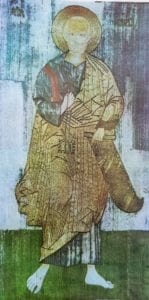

We can attribute, it would seem, to Novgorodian art of the late 15th-early 16th century two large embroidered depictions of the Archangel Michael [Illustration 20] and the apostle Peter [Illustration 21]. Their straight-faced, front-facing figures stand firmly upon the earth. They are relatively stout, with large haloes, large feet, and somewhat small hands. They are somewhat odd looking for the 15th century, in their poses and the expressions on their faces; their majesty and mild calm are more peculiar to the late 15th-early 16th century. At the same time, it is difficult to attribute them to Muscovite art of that time. Here we do not see the fine gradation [of color] intrinsic to Rublev and hits followers, nor the refined grace of Dionysius’s school. The figures’ staging and their weightiness are reminiscent of Novgorordian images of earlier times. The technique of the embroidery is typical of the 15th century, worked in stem stitch in colored silks and in gold with inconspicuous couching. The main coloring of the images are the dark blue silk base and green ground. On the image of St. Peter, this is enriched by the gold of his clothing and halo. On the image of Archangel Michael, a bright-red cloak is thrown over his golden armor. His wings are worked with an unusual volume, as if they were bent forward. This curve over the shoulders emphasizes his bold resilient lines, creating an internal volume filled with yellow silk. Instead of a sword sheath in his left hand, the Archangel holds an unrolled scroll, as does St. Peter. Thus too is the archangel shown on Dionysius’s frescoes to the left of the gate in the cathedral in Ferapontov Monastery.[80]Istorija russkogo iskusstva. Vol 3. Moscow, 1955, p. 500. The Archangel Michael, patron saint of military glory, unites here the function as both angel and watchdog. Both works are of relatively large size, and they have been generally accepted to consider them to be remnants of a Deësis row. But, the straight-faced, non-prayerful poses of the figures, the archangel’s warlike clothing, atypical for a Deësis, and the analogy to the frescoes in Ferapontov Monastery provide an opportunity to suggest that the original placement of these figures – the guardian angel and Peter, the guardian of the gates of Heaven – on the edges of the pillars guarding the western entrance into a church. The Aleksandr-Svirskij Monastery, from whence these icons came, was founded around 1494. In 1506, the Trinity Cathedral was built there, with a chapel dedicated to the apostles Peter and Paul. It would seem that we can also attribute the creation of these embroidered icons to that time.
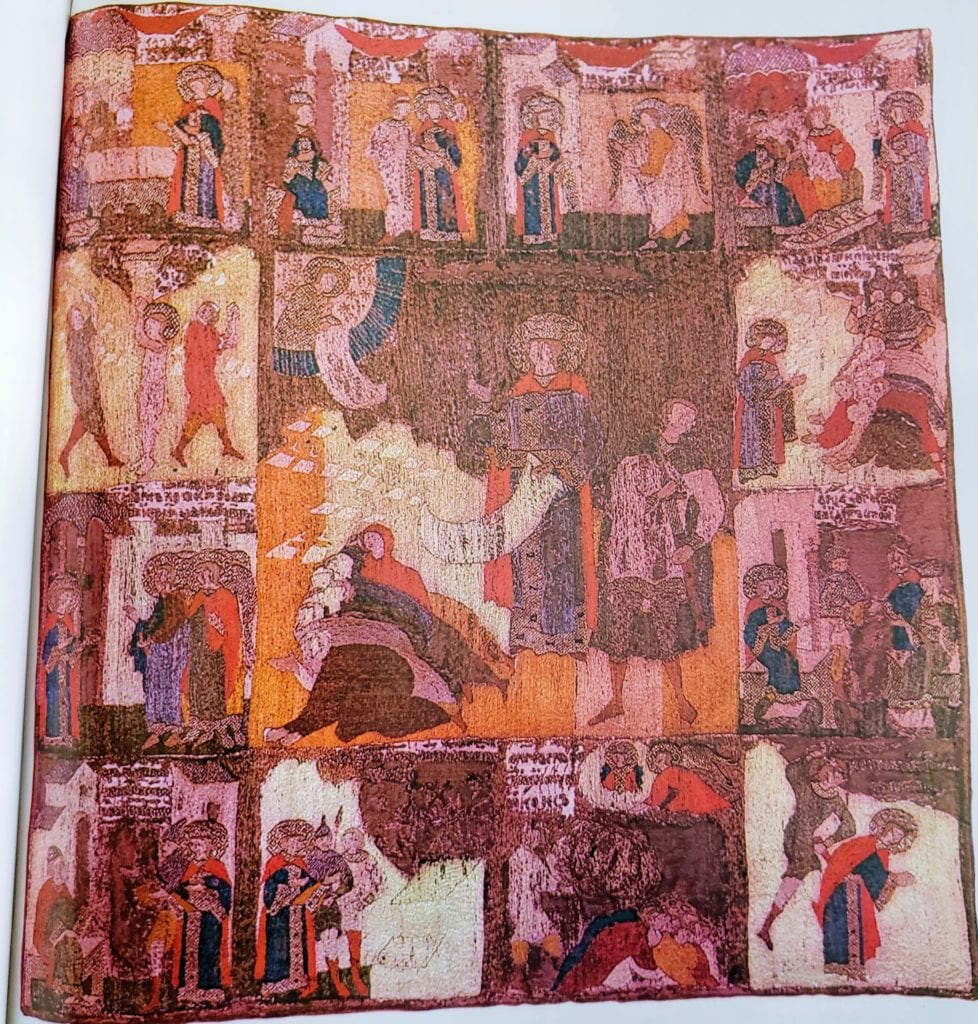
A podea from the late 15th-early 16th century embroidered in colored silk and depicting St. Catherine the Martyr with Scenes of her Life [Illustrations 22 and 23] is particularly picturesque. Prayers to Catherine were read at births and at “departures of the soul,”[81]For example, the dying Grand Prince Vasilij III appealed to her. (PSRL, Vol. VI, 1853, p. 273) but the design of this podea, based on its central inscription — “Catherine’s Prayer for the People” [«m[o]len[i]e styja ek[ate]riny o narode»] — goes beyond an individual prayer. This podea came from the Khutyn Monastery. It would appear that it was created in Novgorod. In the second half of the 15th century, Novgorod experienced a great shock – the loss of its independence. During the campaigns of the Prince of Moscow, the lands of Novgorod were “captured and burned, and the best people were beaten and struck down and devastated.”[82]Novgorodskie letopisi. St. Petersburg, 1879, p. 304.[83]jeb: By this time, Novgorod’s population had grown larger than it could support, and it became dependent on Vladimir to feed its people. The princes of Moscow used this dependence to gain control over its lands, and eventually Ivan III annexed the city to the Grand Duchy of Moscow in 1478, disbanding the Veche and seizing the Hanseatic League goods stored there. It is possible that this podea was created during these dark days for the people of Novgorod.
Full of dignity in her royal garb, Catherine prays together with the people,[84]In this subject, it is more common for the people to be placed facing toward Catherine, praying to her (V.I. Antonova, N.E. Mneva. Katalog drevnerusskoj zhivopisi. Vol. 2, No. 443.). A depiction of the people similar to that in our podea, with them praying together the Catherine, is seen in a Novgorod icon from the mid-16th century (ibid., No. 361). as if not noticing the young executioner who draws a long sword from its sheath with some effort. The podea has several crowd scenes. Here almost everywhere is the crowd present, as if to emphasize the intention of this work. The hills are drawn in the Novgorod style, with square tops; the details of the clothing are meticulously embroidered in multicolored silks selected with great taste. Particularly fine is the final scene [Illustration 23], where Catherine’s humble pose, ready to receive death, is juxtaposed against the energetic movement of the executioner, who holds his sword above her.

Illustration 24
Among the very small number of works of art to have survived to our time from the central Russian cities which were subjected to brutal ruin during the time of the invasion of the Tatars and of feudal strife during the times when they lost their independence, of particular value is the so-called “Rjazan'” Aër decorated with the Eucharist and scenes of the lives of Joachim, Anna and the Holy Mother [Illustrations 24, 25]. The Aër has an inscription about its creation in 1485 at the “conception” of Grand Princess Anna. The daughter of Moscow’s Grand Prince Vasilij Vasilievich the Blind, Anna was wed in 1464 to the Prince of Rjazan’ Vasilij, who had been raised in the Moscow court. After her husband’s death in 1483, she lived with her son Ivan in Pereslavl’-Rjazan’, and it was to the largest church of that city, the Cathedral of the Assumption, that she donated this work. It is likely that the selection of subject for this Aër, along the border of which is depicted the miraculous birth of a child to “desperate” parents, is tied to her son, Price of Rjazan’ Ivan Vasilievich, and his lack of children at that time.[85]This is attested by a conversation he had in 1496 with his younger brother, Feodor. (Sobranie gosudarstvennykh gramot i dogovorov [SGGD], Part 1. Moscow, 1813, No. 127, p. 32)
As has already been noted, V.N. Schepkin is of the opinion that the Rjazan’ Aër shares a proto-original with the Suzdal’ Aër by Ogrofena Konstantinova [Illustrations 10, 11]. They both have the same content and arrangement. And yet, this work is of a different time, and a different artisan created it. Although it repeats the general design of the Suzdal’ Aër, the artist here creates a different composition, embodying in it their own aesthetic ideals. He has positioned slightly differently the apostles who approach the throne, has shifted the ciboria, has turned them into a single building, has dropped the scene of the “Caress” of the child, has highlighted the “Bathing of the Child” into its own separate cell. Also, some of the scenes here are slightly different: “The Annunciation to Anne about Joachim’s Return,” “The Evangelism to Joachim,” “The Arrival” (the first steps) of the Blessed Virgin, the Prayer for the Rods, John the Evangelist, and others. The Rjazan’ artist also has a different rhythm for the construction of the composition, and different proportions for the figures. The apostles are depicted with large, stocky heads. They do not completely fit in the center of the work, and their feet reach down into the strip with the inscription. Around the border there are many figures standing vertically, and the crowns of the trees have acquired an elongated, pineapple-shaped form. Here, line and silhouette are less gently rounded and are a bit more sheer than on the Suzdal’ Aër, the faces of the apostles are more elongated, and their features are sharper. Embroidered following the direction of the design, they have slight shading in brown silk. The whites of their round eyes stand out sharply. On the clothing, the silk stitches are thicker than on the faces. Everything is embroidered in heavy split stitches. The folds and contours are outlined in gold. The trees have acquired a particular decoration, with trunks in gold, fruit in red and silver, and light green foliage. As is often seen, the center area is embroidered more meticulously than the border. It would appear that here, several artists worked under the direction of a local artist who was untouched by Muscovite art of the Dionysian period.
Works which came from the Moscow Kremlin workshops of Ivan III are extraordinarily diverse.

An interesting work from these workshops is a small podea depicting Our Lady of Smolensk with 13 half-length figures around the border [Illustration 26]. The upper part of the podea is embroidered with a Deësis with the Savior in the middle. Its canonical nature is completed by the apostles Peter and Paul on the sides borders. The following saints are also present: the Metropolitans Petr and Aleksej, who were protectors of the city of Moscow and of the Moscow royal house; the holy Russian princes Vladimir, Boris, and Gleb, whose presence emphasizes the donor’s royal descent; and finally, in the lower left corner, St. John Chrysostom. The special placement of the latter, the absence of other saints, and Boris’s placement next to him allow us to conclude that this podea should be attributed to the workshop of Princess Maria, daughter of Tver’ Prince Boris Aleksandrovich and first wife of Ivan III, who included here the name day saints of her husband and father, almost as her own unique signature. Judging by the top center image, the podea was intended for a church of the Savior, possibly the one in the Novospasskij Monastery founded in 1462 by Ivan III.
Another peculiarity of this podea is the image of Prince Vladimir, which was not in widespread use in Moscow up to the 16th century, and which is known to us in Muscovite art only on a 1389 podea by the wife of Simeon the Proud, who was also Tverian by birth [Illustrations 5, 6].[86]The cult of St. Vladimir arose in Novgorod shortly after 1240, and seems to have spread to Tver’ earlier than it finally reached Moscow. The podea of Our Lady of Smolensk is notable for its particular intimacy, the lyricism of its image, and its harmonious color scheme. The gentle, young face of the Mother of God, with its rounded high brows and its gently outlined nose presents a Slavic appearance. In her left hand, she holds a disproportionately small figure of the Christ child, with atypically dark-blue clothing. The mother’s cap and lower clothing are of the same color. The dark-blue and brown tones of the central section carry over into the border, where they are joined by tones of green, yellow and crimson. The artist who designed this podea existed chronologically between two large schools which left a mark in Russian art. Following the Rublev school and its lyrical interpretation of image, this podea does not have its characteristic casual grace. At the same time, we don’t yet see the magnificence and refined sophistication which we see in Muscovite art from the late 15th century. The figures on the podea are a bit shortened and heavy; the colors are lush and local. The embroidery of the faces on the border are carried out in stitches in a single direction, whereas the face of the Holy Virgin in the central section has been “sculpted” by the embroideress, by following the directions of the design, which allowed her to give it a rounded softness and a certain feminine charm.
The presence of Grand Prince Vasilij II’s name day saint on this podea suggests that it was embroidered after his death (1462). The latest date when it could have been completed would be the death of the Grand Princess (1467).
Several works which are atypical of medieval Russian embroidery emerge from the Moscow Grand Prince’s workshop at the end of the 15th century, associated with the arrival of “the foreigners.”
In 1473, Ivan III married the niece of the last Byzantine emperor, Sofia Palaeologus; ten years later, their Tverite son Ivan the Younger was wedded to Elena, nicknamed “Voloshanka”, the daughter of the powerful Moldavian noble Stefan the Great. In the 1590s, after the death of Ivan the Younger, there arose between the two princesses a rivalry over which of their sons would succeed to the throne. At first, Voloshanka’s party held the upper hand, as the guards supported the authorities headed by the Princes Patrikeev and Rjapolovskij. On the 4th of February 1498, Elena’s son Dmitrij was solemnly crowned in the Cathedral of the Assumption.
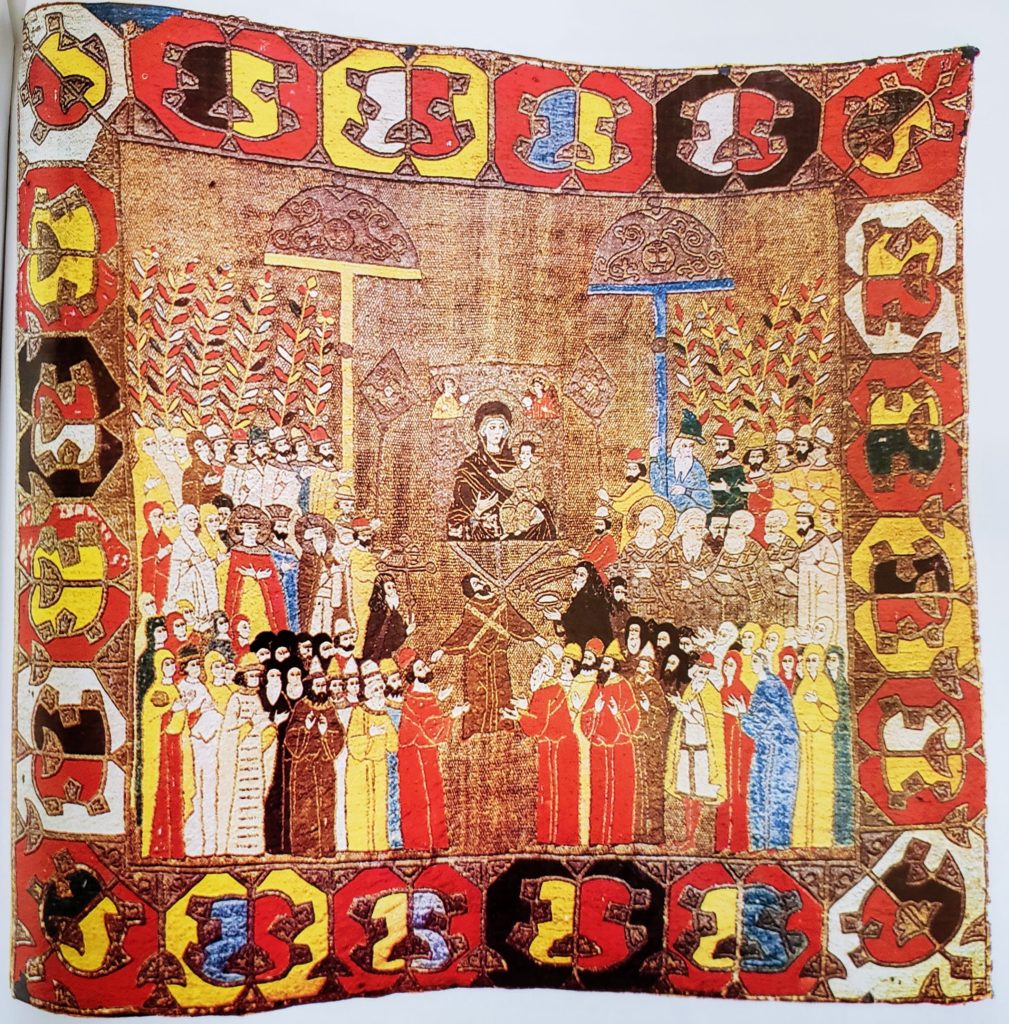
Tied to this event, Elena created a remarkable work of embroidery depicting the procession in the Kremlin on Palm Sunday, the 8th of April 1498 [Illustration 27].[87]Credit for the dating of this podea and the determination of the persons depicted upon it belongs to M.V. Schepkina. («Izobrazhenie russkikh istoricheskikh lits v shit’je XV v.» Trudy GIM, Issue 12, Moscow, 1954). The Grand Princely family stands amidst their people. The young Dmitrij is particularly highlighted by his their pose as a communicant and by his halo, mirroring those of the Grand Prince and the Metropolitan. The podea’s content is atypical for medieval Russian art. This is essentially a secular picture, depicting an actual event with historical personae.
The depictions on the podea are of fine, skillful artwork. Particularly fine are the figures in the front row, of slender, elongated proportions. Amidst the crowd, the Metropolitan and, following behind him, the bishops are shown in slightly larger size. All of the personages are depicted in lively, diverse movement. The artist and the embroideress were distinguished by their great desire and effort this moment of actual reality. Here we see, it would appear, the icon “The Holy Virgin Hodegetria” from the Kremlin’s Monastery of the Ascension, painted in 1482 by Dionysius on the board of an earlier icon destroyed by fire[88]An image of the Hodegetria icon by Dionysius can be seen in: V.I. Antonova, N.E. Mneva, Vol. 1, No. 274, Illus. 214.[89]jeb: A picture of this icon can be seen online at https://painting-planet.com/the-virgin-hodegetria-by-dionysius/. and particularly revered in Moscow. The deacon’s pose is perfectly conveyed, just as it was in particular borrowed from the Byzantine ritual.[90]Stefan of Novgorod, having been in Constantinople in 1348-1349, thus describes an icon of the Hodegetria revered there: “And one man stands in the secret place with his shoulders raised and he spreads his hands as if crucified, and he raises his eyes… and then another will replace him, and they sing a holy song with the deacon.” (M.N. Speranskij. Iz starinnoj novgorodskoj literatury XIV v. Leningrad, 1934, p. 54; the full description is given in M.V. Schepkina, p. 14). The singers standing in the front row in conical hats lift their hands as if listening to the song. Among the female figures wrapped up in maphoria, there are two young women in medieval Russian outfits. Just in front on the right, turning toward the women, stands a man in Frankish dress. This symmetrical and yet, at the same time, picturesque composition, the colorful outfits, the smart sun shades, the long thin willow twigs, and the bright pattern of the border all meld into a into a festive holiday chant proclaiming the victory by Dmitrij and his mother.[91]M.V. Schepkina includes in her work the oral tradition of the restorers, E. Brjagina and E. Chirikova, about the origin of a podea from Moscow’s Cathedral of the Dormition which is quite possible given that, aside from the image upon it which is tied to that cathedral, in medieval times (1327), a chapel was built there to Dmitrij Solunskij, name day saint of Elena Voloshanka’s son (this saint and his goodness are also depicted in the Kremlin’s Cathedral of the Archangel.)
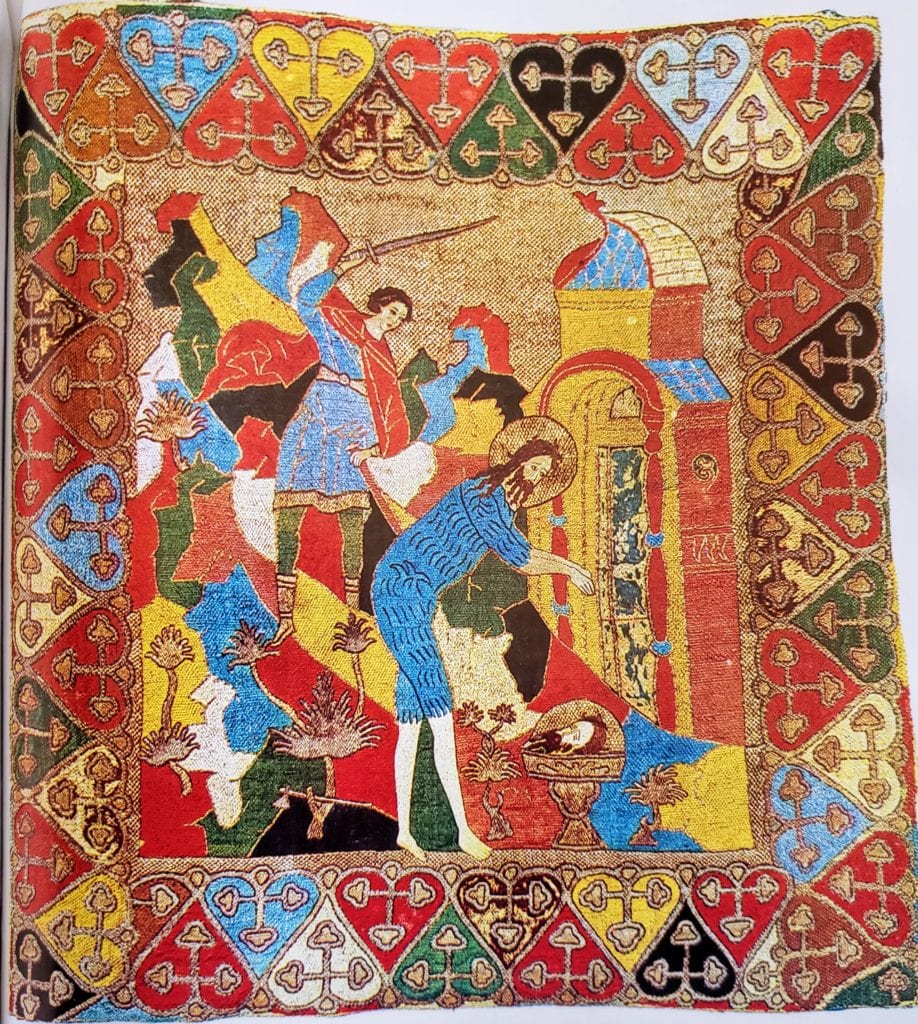
Another podea depicting “The Beheading of John the Baptist” [Illustration 28] is also associated to Elena Voloshanka. This is embroidered with the same sophisticated embroidery as the podea with the church procession. Here we see the same ground covered in gold thread, the bright color scheme of multicolored silk, and the same use of a large pattern to decorate the border. The selection of subject on this podea, it appears, is tied to the holiday in whose honor Elena’s husband, Ivan the Younger, was named. The design of this work is clear and precise. The figures are exquisitely elegant. There is even a certain mannerism in the post of the bowing St. John. His face, with its straight eyebrows, is shown with an expression of suffering, and yet the beautiful face of the young executioner is peaceful. His movement is serenely confident. Only the dangling end of his waistcoat emphasizes the swing of his arms which bring the sword down upon John, who is ready to accept death. An elegant, almost fancy shape is given to the architectural structure, with its thin columns and curved roof, which ends in a flower. The variegated hills, embroidered in multicolored silk of saturated tones, overlap with the thick ornamental border.
The traditions of Russian and south-Slavic arts found a kind of combination in the podeai of Elena Voloshanka. Their very content, and the non-canonical nature of the podea with the religious procession attest to the princess’s direct influence in their creation. The depiction of living persons, including the donors of churches, icons and podeai, was especially widespread in south-Slavic art.
Ornamental borders play a large role in the works by Princess Elena, something which is totally uncommon for Russian embroidery. Wide and embroidered with bright colored silks, they almost prevail over the images depicted. Their ornamentation and color scheme, it appears, also have south-Slavic origins. Most likely, podeai created in a non-Russian technique of alternating couching stitches [dvojnoj slozhnyj shov], were embroidered by an artisan who arrived with Elena, or perhaps by the princess herself. The subtle drawing of images and particular refinement of their proportions, however, links the artist of these podeai to the Muscovite artistic school of Dionysius. Creating these works which are so atypical for Russian embroidery, for example the podea with the procession, he at the same time remains in the mainstream of Muscovite art of the late 15th-early 16th century.
In 1499, Moscow’s relationship with Lithuania, which was supported by the Moldavian King Stefan, became complicated. The Prince of Moscow sought to win over the Russian boyars who were clearly not sympathizers with the supporters of Grand Princess Elena and were fleeing to Lithuania. This was followed by banishments and executions. In March of 1499, Ivan III proclaimed his son Vasilij Prince of Novgorod and Pskov, and in 1502, heir to the throne. Dmitrij and Elena were imprisoned, and would remain there until their deaths.[92]Elena died in 1505, Dmitrij in 1509.
The height of this struggle over the succession was the legend of the “miraculous conception and birth” of prince Vasilij.[93]V.V. Filatov believes this legend was started between 1490 and 1505, existed for some time as an oral palace tale, and was subsequently (by 1542) recorded by Metropolitan Ioasaf, the former leader of the Trinity-Sergiev Monastery. (V.V. Filatov. «Ikona s izobrazniem sjuzhetov iz istorii Russkogo gosudarstva.» Trudy Otdela drevnerusskoj literatury Instituta russkoj literatury Akademii nauk SSSR [TODRL]. Vol 22. Moscow/Leningrad, 1966, pp. 280-281) As the legend goes, the Grand Princess Sofia by 1479 had only given birth to daughters, but during a pilgrimage to the Trinity Monastery had a vision of Sergius of Radonezh, who “placed into her belly a male child.”[94]PSRL, Vol 12. Moscow, 1965, p. 191. At this same time, the doctrine of Moscow as the Third Rome was created, underlining the succession of Muscovite princely power from the Byzantine emperors. All of this would have confirmed the undoubted claim to the throne and divine right of the son of the “Princess from Constantinopolis.”
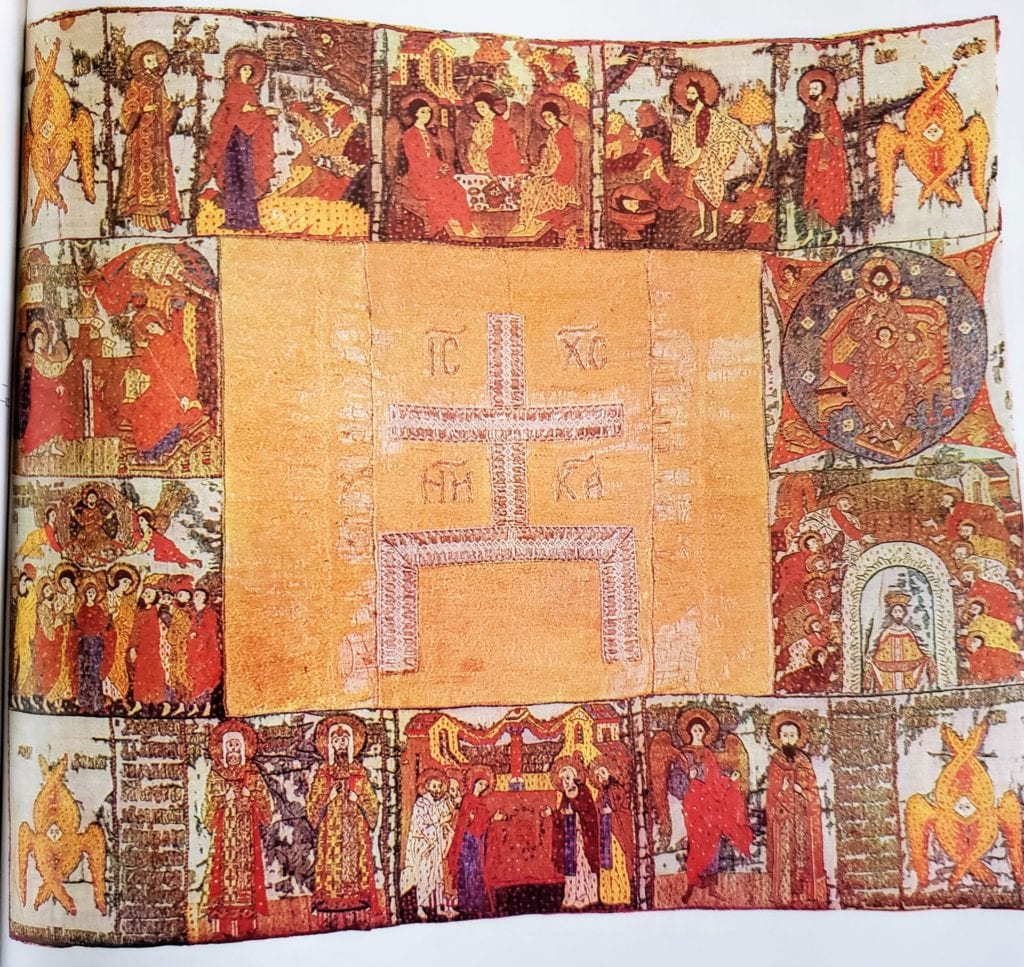
Illustration 29
It is not by chance that in 1499, Grand Princess Sofia donated to the Trinity-Sergiev Monastery a podea [Illustrations 29, 30, 31] which, as with the work by Princess Elena, marks her son’s triumph. But, whereas the Voloshanka podea speaks about it openly, with almost realistic means, Sofia’s composition stays within the bounds of accepted religious symbolism.
Around the border of the podea are embroidered various holidays and saints, some of them tied to their intended destination – the Trinity Monastery: “The Trinity,” “The Appearance of the Holy Virgin to Sergej,” “The Heavenly Father” [Otechestvo], and “The Descent of the Holy Spirit Upon the Apostles.”[95]”The Descent of the Holy Spirit upon the Apostles” is celebrated the day after the “The Trinity.” In honor of the Day of the Spirit, a church was built at the Trinity-Sergiev Monastery in 1476-1477. Here too we see depicted the patron saints of Moscow – Metropolitans Peter and Aleksej – and of the Byzantine royal house – John the Baptist. Our Lady of God is shown as a symbol of her role as patron saint of the Russian land, as are the name day saints of Ivan III – John Chrysostom and the apostle Timothy – and of his son Vasilij – Basil of Parium and the Archangel Gabriel.[96]In medieval Rus’, a child was often given two names, one after a saint based on the day of his birth, and a second choosingly, typically after one of the saints for any one of the eight days after the date of birth, but this could be extended. (N.N. Kharuzin. «K voprosu ob upotreblenii nekalendarnykh imen v dopedrovskoj Rusi.» Sbornik Istoriko-filologicheskogo obshestva pri Institute kn. Bezborodko v Nezhine. Vol 2, Issue 2. Nezhin, 1899.) The depictions of the “Annunciation” and the “Ascension” on the left border also appear to be tied to the dates of Vasilij’s life.[97]Vasilij was born the day after Annunciation, the 26th of March, in the Cathedral of the Archangel Gabriel. Vasilij’s veneration of the holiday of the Ascension is attested by his construction of churches dedicated to that holiday in the Ascension Monastery and in the village of Kolomensk.
The podea was embroidered by Russian needleworkers in stitches which would have been of common use. The designer was also Russian. This is evidenced by both the iconography, as well as the overall style of the work. And yet, the work has particular qualities in both the technique and iconography which can be ascribed to the forethought of “the Byzantine Grand Princess of Moscow,” as Sofia refers to herself in the inscription. Above all for Russian works of embroidery, where a female is almost always referred to by her husband’s name, this flamboyant title itself is atypical, as if to emphasize Sofia’s descendents’ rights to the Grand Princely throne. Also unseen elsewhere in Russian iconography is the particular variant of the composition of “The Descent of the Holy Spirit Upon the Apostles,” where the apostles are not seated upon benches and chatting, but instead are prostrated upon the ground in prayer. We should also note that the “tripartite divinity” in the typical form of the Old Testament Trinity has been replaced here by “The Heavenly Father,” a form which although seen in Novgorod works of the 12th-14th centuries,[98]For example, the icon “The Heavenly Father and Selected Saints” from the second half of the 14th century in the Tretyakovsky Gallery (V.I. Antonova, N.E. Mneva. Vol. 1, No. 25, p. 94, Illus. 46). This source also mentions the 12th century icon of the Annunciation from Antoniev Monastery in Novgorod (ibid., example 1 on page 94). was not widespread in Rus’. The depiction here on Sofia’s podea is earliest example of “The Heavenly Father” among extant works of Muscovite art.[99]L.S. Retkovskaja notes that “at this time, there was active implementation of this composition in all forms of art, in connection with the struggle, as in the 14th century, against newly raised heresies.” (L.S. Retkovskaja. Vselennaja v iskusstve Drevnej Rusi. Moscow, 1961, p. 13) See also: V.N. Lazarev. «Ob odnoj novgorodskoj ikone i eresi antitrinitariev.» Kul’tura Drevne Rusi. Moscow, 1966, which justifies the rise of this subject in Novgorod art of the late 14th century in connection with the Strigol’niki heresy. In Byzantium, this composition of “The Heavenly Father” was known starting in the 11th century. But what is particularly characteristic and makes this work by Sofia Palaeologus stand out from others are the multi-colored dots which are embroidered onto the clothing, architectural elements, grass and hills. This feature, as A.N. Svirin has pointed out, is found in several examples of Italian art, in particular in 16th century embroidery.[100]A.N Svirin, pp. 59-61. It is worth noting, however, that on two examples of Italian embroidery from the 16th century stored in the Hermitage, decorated with scenes from the Old Testament and the 12 months of the year, this technique has a different artistic significance. Here the background is almost completely covered, on one in red and the other green silk. The images remained unembroidered, and them, white linen is embroidered with dots of the ground fabric color. (A.S. Verkhovskaja. Zapadnoevropejskaja vyshivka XII-XIX vekov v Ermitazhe. Leningrad, 1961, illus. 31-34.) The Russian embroideresses have copied this technique in their own way, exposing it to the overall color scheme of the piece.[101]Similar multicolored dots also decorate several other works, undoubtedly from the same workshop. These are two veils [360, 370] and a cuff [371] from the Zagorsk Museum, a veil with the “Crucifixion” in Vladimir, and fragments of embroidery with images of saints in the Russian Museum [26].
The design on the Sofia Palaeologus podea is less clear and the figures do not have the same refined grace as on the works by Voloshanka. It also was embroidered by less skilled needleworkers. The stitches are laid in a single direction, the faces and round eyes are sewn simply, and the drawing of the hands and feet is a bit crude; but, the podea captivates by its atypicality and the tone of its color pallette.
The artistic culture of the Grand Duchy of Moscow at the end of the 15th and beginning of the 16th centuries was quite multifaceted. The most prominent expressions of taste of that epoch were Dionysius and the artists of his school, who exerted great influence on the direction of Russian art as a whole.

Quite similar to works created by Dionysius is a suspended podea from the beginning of the 16th century depicting a bust-length St. Nicholas [Illustration 32]. This podea appears to have originated in one of the first class Moscow ateliers. The talented embroideress has particularly finely conveyed the artist’s inspired design. Perhaps the most popular saint in Rus’, Nicholas is seen in an unending multitude of works, not only in icons, frescoes, and embroidery, but also in wood and clay sculpture and other forms of art. He is easily identified by his large round forehead and his small curly beard. Aside from the steady observance of this iconographic type, every depiction of Nicholas has its own, sometimes barely perceptible originality.
The image on our podea has been given an expression of great spiritual purity and severity. This is the “power of faith” which needs to be observed, as is often mentioned in hymns to the saint. In his face, every stroke is expressive. His enormous forehead symbolizes his great mind, and the thin arcs of his eyebrows are like winged thoughts. His stern eyes are also graceful in form, but the large hands, firmly raised in benediction, complete the impression of the harmony of the outward appearance and inner peace of the man depicted here, of his great spiritual self-discipline. The color scheme of this work is also quite subtle. Tones of dark blue and cranberry prevail, in combination with gold and silver. The figure of Nicholas emerges from the boundaries of the inner section, to emphasize even more the meaning of this image.
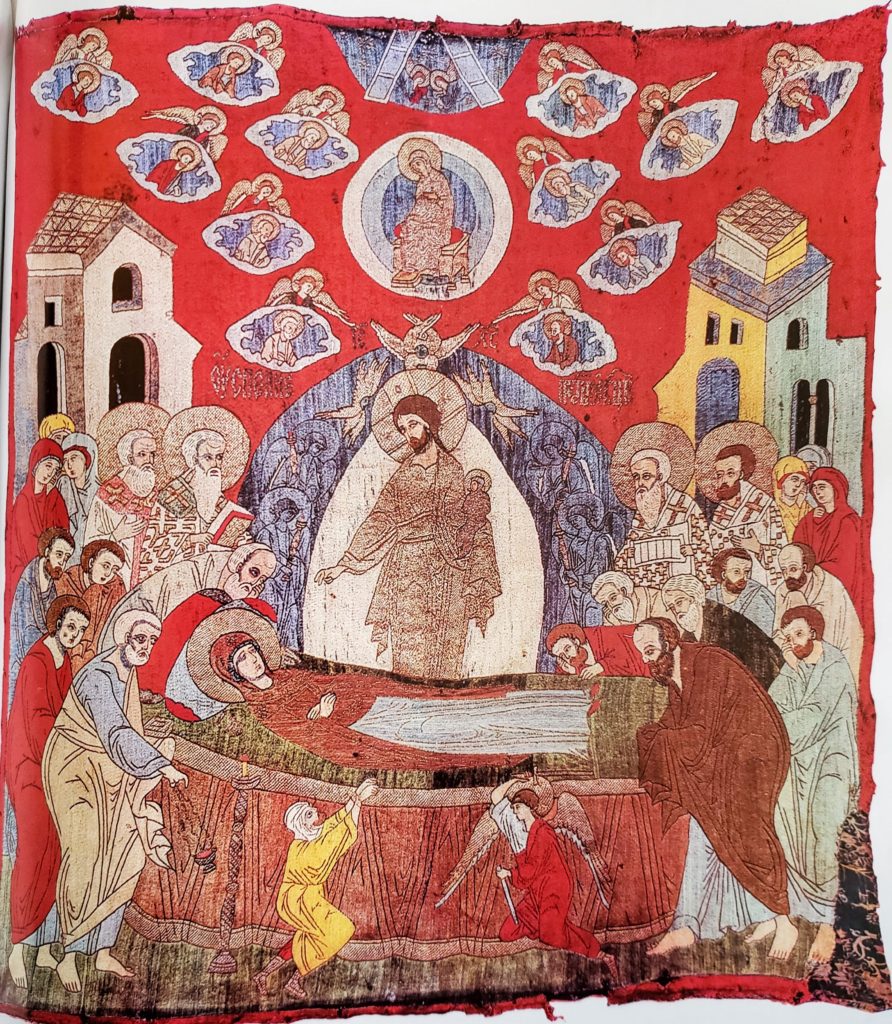
The Rjazan’ Museum contains an excellent podea from the early 16th century depicting the “Cloudy Dormition” [Illustration 33]. This podea was embroidered by a skilled craftswoman, who managed to convey the artist’s design without roughening it, using fine, accurate stitches. Particular attention should be paid to the apostle Paul, who stands at the foot of the Holy Mother’s bed. His hawk-nosed face with its large forehead is shown in profile, which rarely comes off well in embroidery. Here, his lines are flawless. Every person on the podea has his own individual characteristics. In their expressions and in the figures’ poses, she has conveyed a deep sorrow. This is also seen in the face of Christ. Having stretched his hand out in prayer to the deceased and bent his forehead, he looks at the saints, and their eyes are turned toward him, as if understanding the significance of these events. Look and gesture are given great attention here. Turning, the crying women look at one another, and the apostles woefully clasp their cheeks. The small figures in front of the bed are expressive; with a rushing movement, an angel with a sword held over his head, and Avfonia, who falls powerlessly to her knees as she attempts to overturn the Holy Virgin’s bed. The podea is extremely pictorial. Its ground fabric has been embroidered in a raspberry silk. The bed is picked out in a green color. In the clothing and architecture, the cranberry and green tones combine with light blue, yellow and white. The theme of the “Cloudy Dormition” became quite widespread in Moscow art of the 15th and 16th centuries. Aside from several differences in details of the composition and realization of the image, here we see the one and the same variant of the subject as seen in a Kirillo-Belozersk icon attributed to Andrej Rublev and his students.[102]V.I. Antonova, N.E. Mneva. No. 228, illus 186. See also the icons attributed to Dionysius in the Cathedral of the Assumption in the Moscow Kremlin, and in the Andrej Rublev Museum (from the town of Dmitrovo). The Rjazan’ podea resembles works from the Moscow school. It is possible that it was embroidered in Moscow, and arrived in Rjazan’ as a donation.
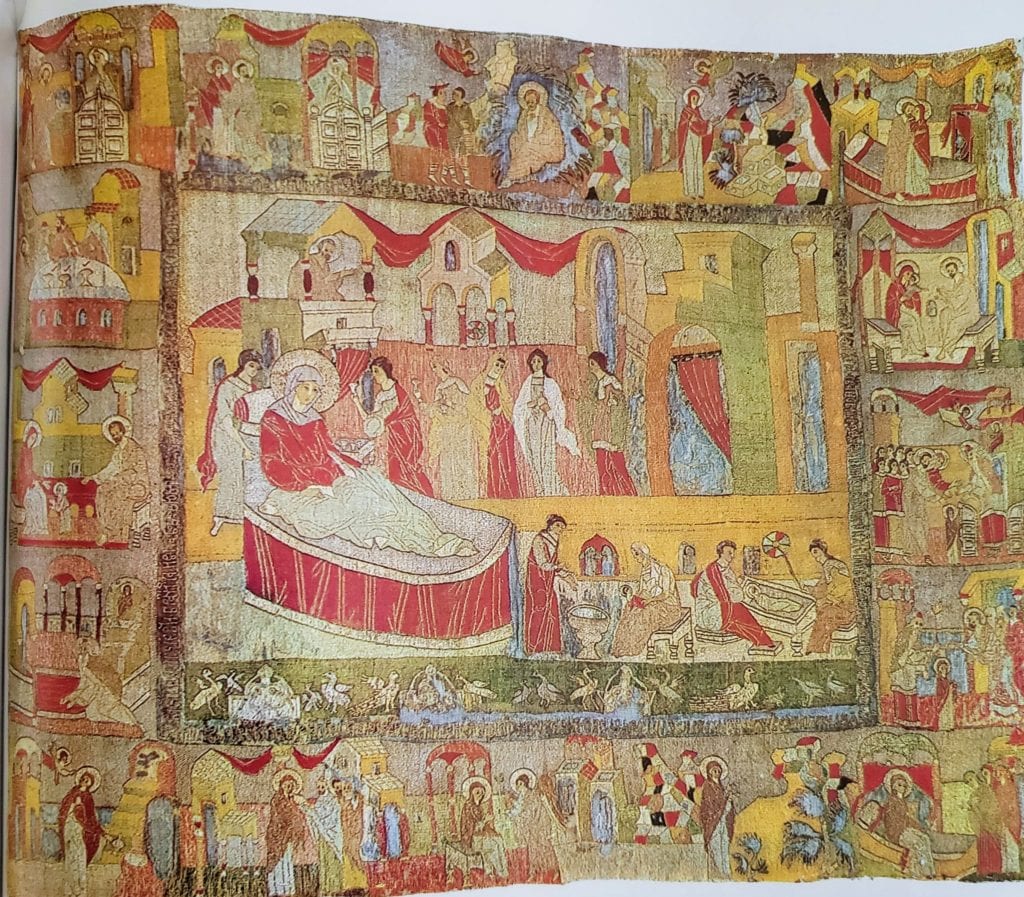
Illustration 34
Another remarkable example of embroidery is a podea depicting “The Birth of the Holy Mother” from the Cathedral of the Resurrection in the town of Volokolamsk [Illustrations 34, 35, 36]. The podea contains an inscription with a date (1510) and a rarely encountered designation that it was “embroidered by the true-believer Princess Anna.” Princess Anna was the second wife of Volotskij Prince Fjodor Borisovich,[103]There is a hypothesis that she came from the line of Princes Shujskij and that she was buried with the monastic name of Aleksandra in Suzdal’s Pokrovskij Monastery. (T.V. Nikolaeva. «O nekotorykh volokolamskikh drevnostjakh.» Drevnerusskoe iskusstvo. Khudozhestvennaja kul’tura Moskvy i reilezhaschikh k nej knjazhestv. XVI-XV v. Moscow, 1970, p. 374.) who was infamous for his domineering and arrogant manner. He had a well-known lawsuit against the Iosifo-Volotskij Monastery, which was forced to seek protection from the Prince of Moscow.[104]PSRL, Vol. 20, St. Petersburg, 1910, p. 381. And, it is not by chance that the inscription on the podea emphasizes the Grand Princely origin of that impoverished but proud prince. The twice-married Fjodor Borisovich had no children from either his first or second wife.[105]Fjodor Borisovich died childless in 1513, due to which his land was annexed by Moscow. It would appear that these circumstances led to the choice of subject of this podea, and the particular attention and touching nature with which it was worked.
The image perfectly distinguishes the image of Anna with her gentle, pensive face, sitting in a tired pose on the bed, which a servant adjusts. Her figure is shown close-up. Her women rush toward her, full of concern. Especially fine are the figures of the two in the center – a graceful girl with a white shawl draped over her shoulders, and a woman with a veil who turns toward her. The images on the border are also extremely well worked. Here, as in the center, there are many household details, complex architectural backgrounds, and a variety of feelings are finely depicted. Several scenes deserve special attention: “The Evangelism to Joachim,” who sits in a pose of woeful thought; “The Caress,” which portrays a lively moment taken directly from the life of the young child; and “The Annunciation at the Well,” with its startled and frightened Mary. A quivering sense of life is felt in the depiction of the birds on the border below the center section: geese and goslings drinking near the fountain joyfully flap their wings, while peacocks with gorgeous tails saunter amongst them. The symbolic depiction of the “Weeping of Anna,” which is rarely seen in icons or podeai which depict “The Birth of the Holy Mother” or “The Annunciation,” receives here an especially lively, singular interpretation. The podea is quite richly colored. Gold and silver are combined with a deep crimson and delicate shades of green, yellow, and light blue silk.
The elegant, elongated proportions of the figures, the lively movement, and expressive composition all speak to the talent of the artists and needleworkers. Scholars have repeatedly drawn attention to the stylistic and compositional similarity of the image of the birth on the podea to works by the school of Dionysius, in particular a fresco above the portal to the cathedral in Ferapontov Monastery. It would not be a surprise if Dionysius or one of his closest students, having famously painted the cathedrals in Volokolamsk and having created a series of icons there, would also have created the design for a podea for the Volotskij princess. This is especially true, given that Fjodor Borisovich was a connoisseur of works of art and was famously an admirer of the work of Andrej Rublev and Dionisius.[106]Iosif Volotskij complained to the grand prince that Prince Fjodor “will notice an icon or a book of masterful illumination, and will ask to take it” (Poslanija Iosifa Volotskogo. Moscow-Leningrad, 1959, p. 211); in the “Life of Iosif,” it also recounts that in order to win over the prince, he “sent him icons by Rublev and paintings by Dionisius. (Bish. Savva Krutitskij. Zhitie prep. Iosifa Volokolamskogo. Moscow, 1880, p. 40). There is an established theory that the lead artist of this podea was Dionysius’s son Feodosij, who was closely associated with the Iosifo-Volotskij Monastery. The inscription on the podea attests that it was “sewn” by Princess Anna herself. The same phrase about her embroidery also appears on two podeai with images of “Praise to the Holy Mother” and “Christ with the Apostles.”[107]Both podeai were likewise donated in 1510 to the Cathedral of the Resurrection in Volokolamsk. In 1927, there were presented at a restoration expo (III restavratsionnaja vystavka TsGRM, Moscow, 1927, p. 29, No. 51 and 52), but then all trace of them was lost. In 1959, the podea of the “Praise to the Holy Mother” was discovered by us in the Moscow Regional Museum in Istra, from whence it was transferred to the Zagorsk Museum. The Regional Museum in Istra also has the second podea, “Christ with the Apostles” or “The Apostles Bound by a Union of Love.” This author has a photograph from the photo library of the State Historical Museum, on which it is possible to read fragments of the inscription. See also: T.V. Nikolaeva. O nekotorykh volokolamskikh drevnostjakh. But despite this evidence, the embroidery technique on the podea of the Resurrection is quite distinguished from the embroider on the other two podeai. Alternating couching stitches [dvojnoj slozhnij shov] is used here in the silk needlework, and the background of both the center and the border are almost completely covered in gold thread couched in a checkerboard style. Similar techniques, while rarely seen in Russian embroidery, are seen in the works by Elena Voloshanka. The unusually picturesquely worked hills in the border of the Resurrection podea are also reminiscent of Voloshanka’s podea depicting the “Beheading of John the Baptist.” Undoubtedly other needleworkers would have embroidered on this large podea alongside Princess Anna, among them some of south-Slavic origin.[108]It is worth noting here as well other characteristics which recall the art of the South Slavs. The architectural forms in the center section of the podea with the “Resurrection” are similar to a fresco in Ferapontov Monastery, and also are very similar to a painting from 1407-1413 from a church in the Serbian monastery in Kalenic (Svetozar Radojgic. Kalenic. Belgrad, 1964, illustrations 4 and 22). The prince’s appelation of “master” [gospodar’] also saw usage in Russia before Ivan III and Vasilij III, and also has south Slavic (Moldovlachian) origins.
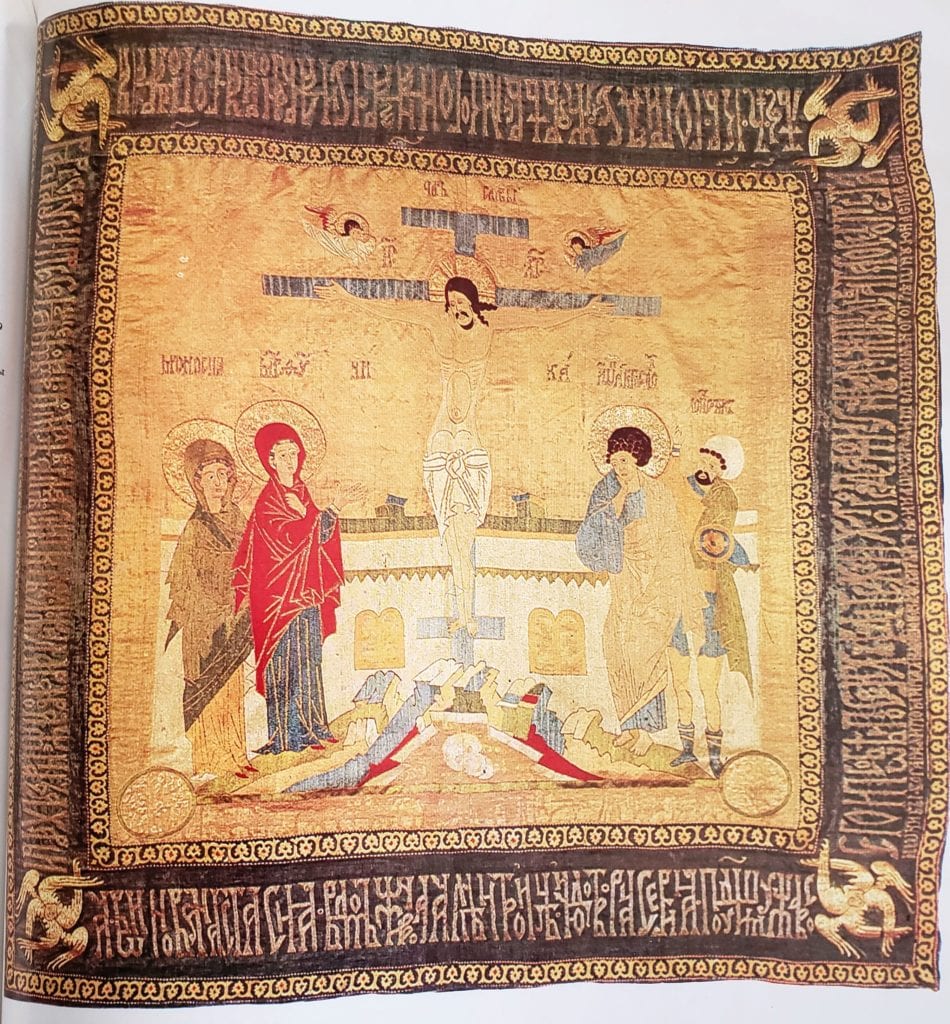
Features of South Slavic art can also be found at this time in other works of medieval Russian embroidery. In this regard, an altar cloth depicting “The Crucifixion” [Illustration 37] is interesting for its unique inscription with the name of the lead artists, the Grand Prince’s artisans Andrej Myvedon and Anika Grigor’eva Kuveka. The donor inscription on the border of the veil states that it was donated in 1514 to the Trinity-Sergiev Monastery by Nastas’ja, wife of Ivan Zakharovich Ovinov. They were well-known Novgorod boyars and supporters of Moscow, and after Novgorod’s union with Moscow in 1478, entered service to the Grand Prince. It would appear that Ivan Zakharovich’s family moved to Moscow, and that Nastas’ja’s workshop was located there.
The composition of the “Crucifixion” on the veil is one of the variants used in the works of the 14th-15th centuries. It is a bit stretched out horizontally. The observers are pushed out to the very ends of Mt. Golgotha. Their legs and bodies are not quite in the same plane, and it almost seems as if they are about to fall backwards. Their feet barely touch the earth, but this seems to impart the noted lightness to these slightly shortened, large-headed figures. The centurion Longinus stands particularly light and loosely. His slim legs in blue shoes and his hand raised upward are finely drawn. In his other hand, he holds a round shield of an unusually small size. Atop his dark, curly hair, instead of a helm there is a white round turban. Christ has a sharply twisted body and disproportionately short legs. His elongated face is framed by a small moon-shaped beard under his chin. Eyelashes are sewn onto his half-closed eyes. This emphasis on details is generally characteristic for this composition. The whites of eyes of those standing before Him stand out. The veil was embroidered onto rose-colored (faded) satin. Aside from the cranberry color, here we also see silks of delicate tones – light blue, light green, flesh-colored, grey – which give the work its own subtle color palette.
The image in the center area is enclosed in a smart border. It is framed by two bands of azure satin with a floral pattern, with a donor inscription worked out in silver thread in beautiful ligature, perceived as ornamentation.
The originality of this work is without doubt. The drawing of the image, the non-Russian types for the faces of Christ and Longinus, the latter’s turban, the use of ornamentation on the borders, atypical for Russian embroidery, and the south-Slavic tracery of the ligatures, as well as their use of the word “master” [gospodar’], all allow us to guess at the south-Slavic origin of Myvedon and Kuveki, the lead artists of this veil who, atypically for Russians, placed their own names upon it.[109]We should note that this is the earliest and only documentary evidence pre-17th century of an head artist of a Russian embroidered item. Written sources also mention the name of Posnik Dmitriev, son of Rostovets, who in 1584 designed a veil for the tomb of Ivan the Terrible; this veil does not have any “ecclesiastical” embroidery. “Worldly” graves were decorated with veils decorated with the Cross of Golgotha. They were also decorated with crosses made of beads, typically with pearls. (I.E. Zabelin, p. 723). About Posnik Dmitrieva, see: V.I. Antonova. «Moskovskij ikonnik Posnik Dermin.» Kul’tura i iskusstvo Drevnej Rusi. Sbornik v chest’ M.K. Kargera. Leningrad, 1967, pp. 144-152.
Several works from the workshop of Nastas’ja Ovinovaja[110]The Historical Museum houses a podea with a depiction of Nikita of Novgorod and Metropolitan Petr [2659 rb]; in the Museums of the Moscow Kremlin, there is a podea depicting “Archbishop Ioann of Novgorod;” in Novgorod, there are two halves of flags, with one depicting St. George the Victorious [1973], and on the other Nicholas, St. John the Theologian, and Euphemius of Novgorod. [1990] are known. Their iconography does not contain the marked traits that would associate them with south-Slavic art, except one: they are all embroidered on the border with the same ornamentation as on our veil. It is possible to believe that they were designed by different masters; but that the ornamentation so pleased the buyer, that it became the unique signature of his workshop. In 1512, Nastas’ja Ovinova donated to the Trinity Monastery an Aër, the inscription of which indicated that it was embrodiered by she herself.[111]The Aër itself has not survived. Its inscription is given here: Archbishop Leonid. Nadpisi Troitse-Sergievoj lavry. St. Petersburg, 1881, p. 32, No. 82. Without a doubt, Nastas’ja or another Russian needleworker embroidered this veil. The technique of its embroidery is typical for Russian needleworking of that time.

The characteristic features introduced by these two foreigners – Elena Voloshanka and Sofia Palaeologus – to Muscovite embroidery did not enjoy any particularly long-lived use. In the early 16th century, the traditions of Muscovite embroidery from earlier periods further evolved. At the same time, Sofia Palaeologus’s Trinity podea (Illustration 29) clearly influenced the general composition and choice of subjects on a podea donated in 1525 to the Trinity monastery by Grand Prince Vasilij III and his wife Solomonia (Illustration 38, 39). Although it keeps pretty much all of the same scenes as the earlier podea, Solomonia has placed them in a different order, and added new ones which reinforce the main theme of her work – a prayer for childbirth. In the center of the bottom border, she has placed her own patroness, St. Solomonia with her seven sons and their teacher Eleozar. She has placed “The Vision of the Holy Virgin to St. Sergius” in the center section on either side of the Cross of Golgotha, which of course was also on Sofia’s earlier podea. As on the former item, scenes are placed along the border, revealing the reason for this donation: “The Annunciation,” “The Nativity of Christ,” and “The Conception” and “Birth” of both the Holy Mother and of John the Baptist. This particular selection of scenes, the frenzied poses of Sergej in the center and of Metropolitan Peter on the border, those praying to the Holy Mother, and the donor inscription all attest to the Grand Princess’s ardent desire to have a son. Having been barren for her 20 year marriage, Solomonia was threatened with being placed into a nunnery. After a long period of hesitation, in 1526, Vasilij imprisoned her in Suzdal’s Pokrovskij Monastery. The podea, accomplished on the eve of this terrible event for Solomonia, is the most significant work of her atelier, from which emerged quite a few different works of embroidery.
The podea is embroidered in silk of various colors and decorated with pearls. The figures, which have slightly elongated proportions, are drawn with flowing lines. The artist undoubtedly belonged to the Moscow school. Several of his compositions, for example “The Nativity of John the Baptist,” have similarities to works by the school of Dionysius.

Undoubtedly, a podea depicting St. Cyril of Belozersk with scenes from his life on the border [Illustration 40] also came from the workshop of Grand Princess Solomonia. This podea has been beautifully preserved. The figure of St. Cyril in the middle section is of slightly elongated proportions. His face, with its characteristically sharp nose and its pensive expression, has a resemblance to an image of this saint on a veil which was donated in 1514 by Solomonia and Vasilij to the Kirillo-Belozerskij Monastery.[112]This veil is stored in the Russian Museum [306].[113]jeb: An image of this podea can be seen online at https://kirillbelozersky.ru/icons/licevoi-pokrov-prepodobnyi-kirill-belozerskii-1514-g Here too we see the same transition from one scene to another, without the usual separation into frames, as on the Trinity podea [Illustration 29]. The faces here with their round eyes and and small straight eyebrows, and the technique of embroidery with simple stitches and little use of goldwork, are similar to the previous work. The composition of the border draws attention to itself. A large number of them are associated with the “miracles” by St. Cyril, including the miracle of curing the four princes of Belev from their infertility. This face, combined with the overall style, support our hypothesis about the podea’s origin.
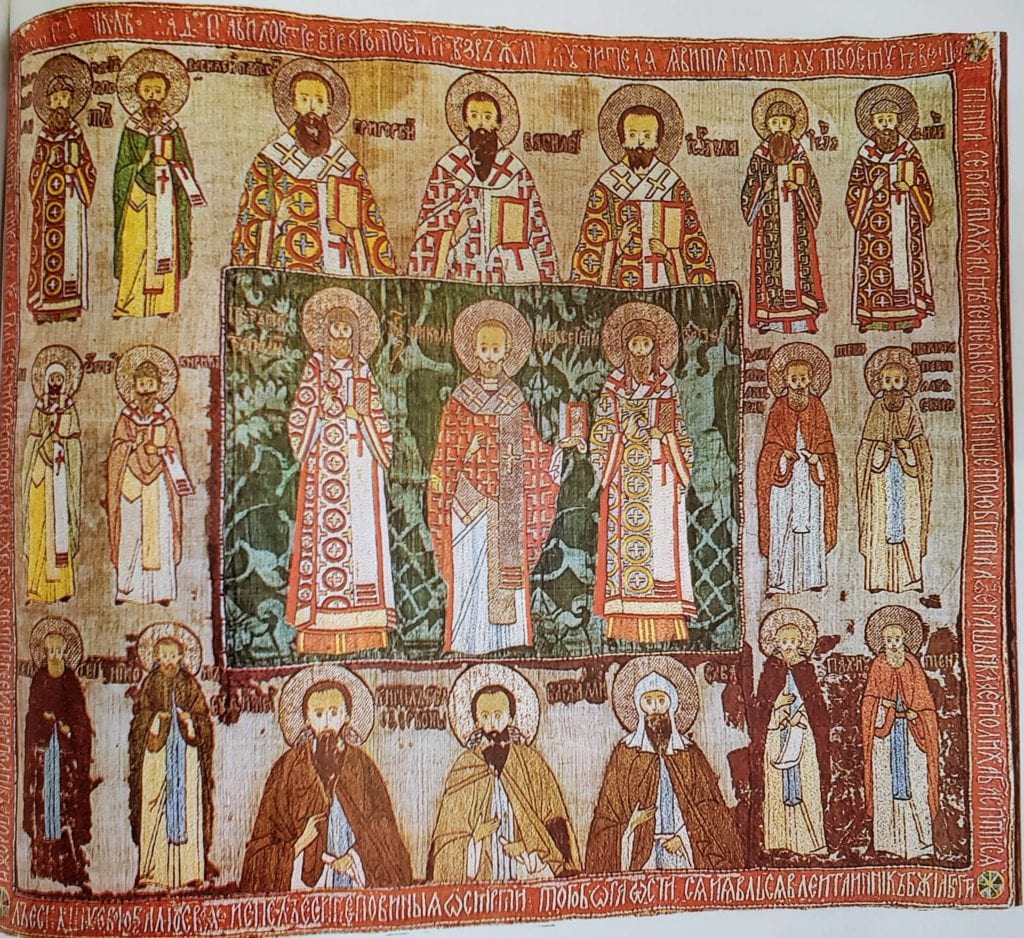
A sort of who’s who of saints revered by Moscow in the first half of the 16th century is found on a podea in the Historical Museum [Illustration 41]. Aside from 3 Greek bishops, who were creators of the liturgy and are given an honorific spot on the upper border, and St. Nicholas, who was particularly respected in Rus’, here we find embroidered two more Greek saints paired with Russian saints: Basil of Parium, in honor of Grand Prince Vasilij III, and Cyril of Alexandria, the name day saint of St. Cyril of Belozersk, who is depicted in the center of the lower border. It is likely that this podea was also donated to the Kirillo-Belozersk Monastery. The very selection of saints speaks to its Moscow origins. Among other saints venerated in Moscow, here we see embroidered 5 metropolitans of Moscow, and among them, the very-rarely seen images of Feognost and Filipp, who were not officially canonized.
Despite the somewhat dry composition of the selected saints facing firmly forward, the podea creates a joyful feeling thanks to its exquisite embroidery in silks which were selected with great taste. Though the faces are embroidered in split stitch in a single direction without shading to create volume, each saint has his own individual characteristics. This is achieved not only through strict abidance to the canonical depiction of each figure, but also through the variation of their robes, embroidered in multicolored silks with the occasional use of gold threads. The venerable ones’ robes are of different colors and shades: brown, cherry, dark green, and grey. The saints robes are even brighter and diverse. The elongated proportions of the figures, the gentle expressions of their faces, and the technical style make this podea similar to other works of the first few decades of the 16th century. Also, the depiction here of St. Basil of Parium and St. Pafnutij of Borovsk, whose veneration was established around 1531, allow us to hypothesize that this work was created between 1531 and 1533. It is likely that this was created by the Grand Prince’s workshop. St. Nicholas appears as the central figure in the middle area of the podea. The prayerful inscription around the border is also devoted to him.
The Greek Saint Nicholas of Myra, a fierce foe of heretics, became one of the most popular saints in Russia, and here became patron saint of the poor and the innocent and defender against all misfortune, such as drowning, wounds, demons, and foreign invasions. This meaning that St. Nicholas had for the Russian people is attested by the numerous churches and works of art dedicated to him. He came to be depicted in the Orans pose holding the Gospel (“St. Nicholas of Zarajsk” [«Nikola Zarajskij»]), or holding a sword and a miniature city of Mozhajsk (“St. Nicholas of Mozhajsk [«Nikola Mozhajskij»].[114]V.I. Antonova. «Moskovskaja ikona nachala XIV. v. iz Kieva i “Povest’ o Hikole Zarajskom”.» TODRL. Vol. 8. Moscow-Leningrad, 1957, pp. 375-392. The depiction of St. Nicholas of Mozhajsk is known starting in the 14th century. The appearance of this iconography is tied to the ancient tradition that he appeared as a vision in this form during an invasion of Mozhajsk by enemies.

The depiction of St. Nicholas of Mozhajsk became especially widespread in Moscow in the 16th century. In this time, it also appears in embroidery. A splendid podea depicting St. Nicholas of Mozhajsk is preserved in the Museums of the Moscow Kremlin [Illustration 42]. It stands out for its precise, clear design, its attractive inscription around the border, and its high level of technical execution. Without breaking Nicholas’s solemn pose, the artist avoided the static character common to similar works. He placed one of the saint’s legs slightly forward, creating a sense of active movement. Nicholas’s face, with its round, peaceful eyes and fine details, appears bright and kind. In terms of technique, it is embroidered in silk split stitches, with moderate use of goldwork and shading of the face, leading us to date this podea to the first half of the 16th century. The humanistic interpretation of the image, the confident freedom of pose, the fluidity of the outlines of the figure all place this podea amongst the most excellent examples of Muscovite art.
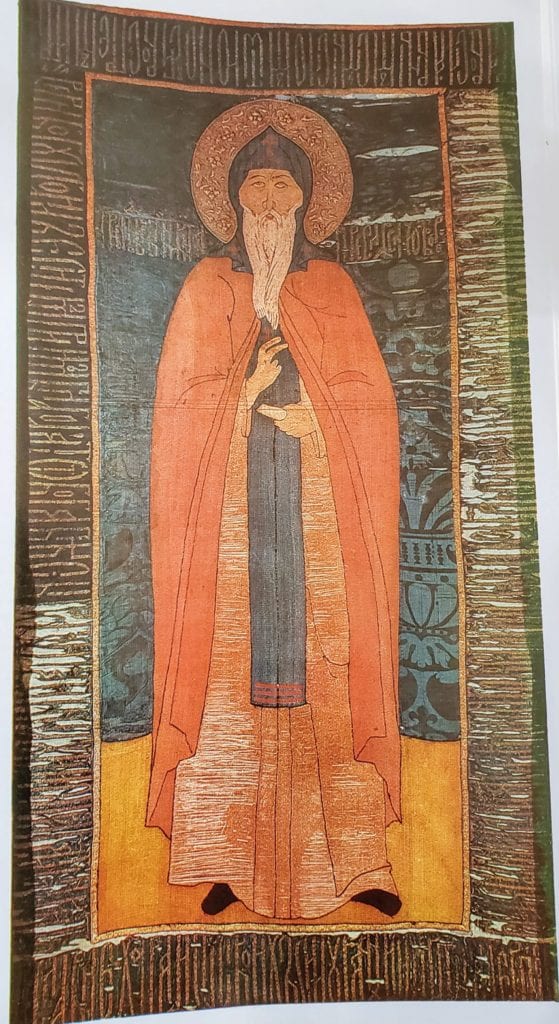
Illustration 43
The middle of the 16th century was a great heyday for the Muscovite princesses’ workshops. Ivan the Terrible’s first wife, Anastasia Romanovna, was herself a skilled needleworker.[115]Works from Anastasia Romanovna’s workshop are found today in many museums. Amongst these, it is worth noting a very pictorial veil depicting the Cross on Golgotha in the Zagorsk museum [404][jeb: see image here], the “Metropolitan Iona” veil in the Museums of the Moscow Kremlin [12204 op][jeb: see image here], a epitaphios with an original composition in Pskov [1256], the “St. Cyril of Belozersk” veil in the Russian Museum [293][jeb: see image here], and also a curtain for the Royal Gates (catapeteasma) depicting “The Presentation of the Princess” with saints on the border, given by Ivan the Terrible and Anastasia in 1556 to the Hilandar Monastery on Mt. Athos in Greece. In the Life of St. Nicetas Stylites of Pereslavl, it relates that she “by her own hand and her own magnificent labor embroidered onto an epitaphios a labor (?) of precious stones the venerated image of the great miracle-worker Nicetas, and overlaid the border with gold, and embroidered words in silver around the border, and decorated the name of the saint with precious pearls and precious stones and expensive beads, and also placed them upon the miracle-worker’s hands.”[116]«Zhitie Nikity Stolpnika.» Gos. Publichnaja biblioteka im. M.E. Saltykova-Schedrina [GPB]. No. 1612, 17th cent., p. 29). According to legend, for this podea of Nicetas Stylites embroidred by the princess, the troparion was composed by Ivan the Terrible himself.[117]I.N. Zhdanov. «Sochinenija tsarja Ivana Vasil’evicha.» Sobranie sochinenija. Vol. 1. Moscow, 1904, p. 101. The chronicles tie the veneration of this saint by the tsar’s family to the birth of Tsarevich Ivan after Anastasia prayed at the saint’s tomb in 1555. Ivan the Terrible became the ktetor of Nikitskij Monastery, and builds several structures there, as well as decorating the churches. The Pereslavl Museum contains severals works considered to be either donations by or even works by Anastasia Romanovna. Among these are a podea depicting Nicetus praying before the Savior. From this comes an exquisite funerary veil of Nicetus Stylites, embroidered on light blue damask [Illustration 43].
Apart from its forward facing position, the figure of Nicetas does not have the typical static nature of funerary veils. The saint’s left leg is slightly extended forward, emphasized by the wavy hem, and the folds of his hood frame his expressive face with its long grey beard. This is the face of a true ascetic. His lips are tightly closed, his stern eyes are turned upwards in prayer, and there are pained wrinkles above his brow. The significance of this image is emphasized by its smart halo, where the lightly twisting pattern of flowers created by couched gold threads imitates an expensive hammered icon-cover. The color scheme was selected with great taste. The bright, light blue ground fabric is echoed by the saint’s light blue hood and epitrachelion, giving the the work a festive tone. The image of Nicetas on this veil is iconographically similar to a mid-16th century icon which came from the tsar’s atelier.[118]V.I. Antonova, N.E. Mneva. Vol 2, illus. 44 Although the saint’s face on the icon has a slightly different, more peaceful and “studious” expression, it is possible to say that these works were created by artists from the same school.
The Tsaritsas’ workshops in the middle of the 16th centuries were rivaled by that of Princess Evfrosin’ja Staritskaja, wife of Grand Prince Vasilij III’s younger brother Andrej Ivanovich, who was accused by Elena Glinskaja’s government of treason and who died in custody. Princess Evfrosin’ja possessed an energetic character and was implicated in intrigues and conspiracies aimed at placing her son Vladimir on the Muscovite throne. In 1563, she was forced to enter the convent at Goritskij Monastery near Kirillov, and in 1569 was strangled “in a smoky hut” on the road to Moscow. It was at this time that Vladimir was also executed.
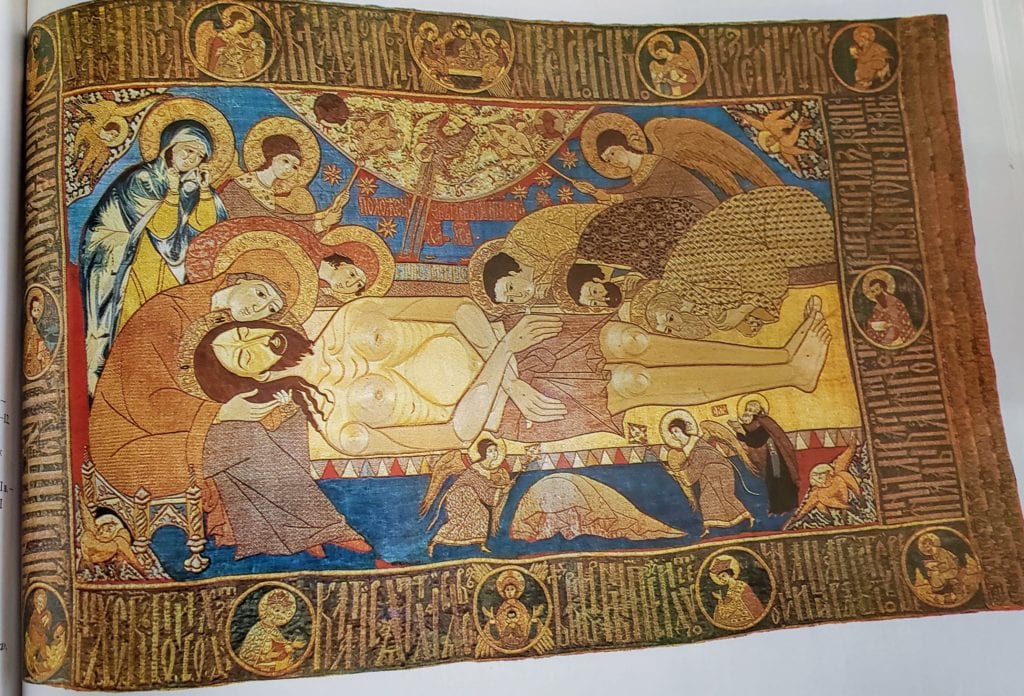
Prince Vladimir’s house was located in the Kremlin, not far from the Trinity Gate. This was also where Evfrosin’ja’s workshop was located, until it later migrated to the city of Goritsy.[119]jeb: Where the Goritskij Monastery is located. It appears that she had several master needleworkers, given that documents recall more than two dozen embroidered works which she donated to various monasteries and churches.[120]N.A. Majasova. «Masterskaja khudozhestvennogo shit’ja knjazej Staritskikh.» Soobshenija Zagorskogo muzeja-zapovednika. Issue 3. Zagorsk, 1960, pp. 41-64. The extant pieces by this workshop stand out for their great artistic merit.[121]Aside from the epitaphios mentioned here from the Trinity Monastery, these have survived: an epitaphios from 1561 (in the Cathedral of the Assumption in Smolensk), an epitaphios from 1565 (in the Russian Museum [285]), a podea with “The Appearance of the Holy Virgin to St. Sergius” (in the Zagorsk Museum [5423]), a podea with “The Assumption of the Holy Virgin” (in the State Historical Museum [86 rb]), and several other works. Among these is a sumptuous epitaphios in the Trinity-Sergiev Monastery with an inscription about its donation by Evfrosin’ja and Vladimir in 1561 [Illustrations 44, 45, 46]. The epitaphios is striking for its monumentality, its completeness, and its rhythm of composition.
The artist who drew this work was possessed of a keen eye. All of his figures are proportional, yet their characteristics are diverse. The large powerful body of Christ contrasts with the feminine figure of the Holy Mother and her delicate, thin hands and the fluid lines of her legs. In a single movement, the apostles and Mary of Clopas bow towards the bier. The graceful, small figures of angels stand near the abandoned wimple. Despite the goldwork, the typically somewhat coarse image and all of the poses are very lively, with the folds of clothing emphasizing the movement and form of the bodies. The [Savior’s] face with its almond-shaped eyes, swollen eyelids and its sufferingly-shifted eyebrows is full of pent-up grief. This grief appears more openly in the Magdalene, who pulls her hair from her sobbing face. Her figure is worked in a pale blue shawl with white and dark blue accents. Likewise, the clouds are depicted picturesquely in the form of dark and light blue, white and red zigzags.[122]This artistic device, resurrected after a hundred years from the Novgorod “picturesque style” by Evfrosin’ja’s workshop, was the basis for hypothesizing that the artist who drew this epitaphios was from Novgorod. (T.N. Aleksandrova-Dol’nik. «Shit’je moskovskoj masterskoj XVI v.» Voprosy restavratsii. 1926 (1), Moscow, p. 131.) But, this also could be the direct influence of Euphemius’s Deësis Row [Illustration 17], which was located in the Trinity-Sergiev Monastery. The beautiful, precise ligature-style of the inscription on the border, alternating with circles depicting the Trinity and saints, creates a wide ornamental frame. The embroidery on this epitaphios is extraordinarily skilled. There is an amazing variety of stitches and techniques. In the goldwork, the thick silk couching stitches masterfully draw out subtle patterns in the clothing. Here the art of ecclesiastical embroidery, using all of the achievements of the preceding epoch, achieves new merit. The ability to translate the artist’s drawing into embroidery achieves high artistry, with stitches so pliable and discreet that the use of silks of different shades sculpts volume with amazing courage. The form or movement of a given figure is often emphasized by one expressive stroke or a particular line of the folds of their clothing. This effort toward naturalistic reproduction in combination with iconographic convention and symbolism, characteristic for embroidery of the 16th century, found its most expressive embodiment in the works of Princess Evfrosin’ja’s workshop. Great psychological tension in the lines and poses of the figures, in the text of the inscription emphasizing Vladimir’s princely lineage, the insertion of the St. Sergius, who is prayed to by the donors, into the traditional scheme of this epitaphios — all reflect the turbulent era of Ivan the Terrible and its tense battle and tragic fate for the last of the local princes, doomed to death during the formation of a single Russian state.
The unusually artistic expressiveness of this work from Evfrosin’ja Staritskaja’s workshop seems to have produced a strong impression on its contemporaries. Numerous works have survived which emulate it both in composition, as well as in individual details, and in artistic techniques.
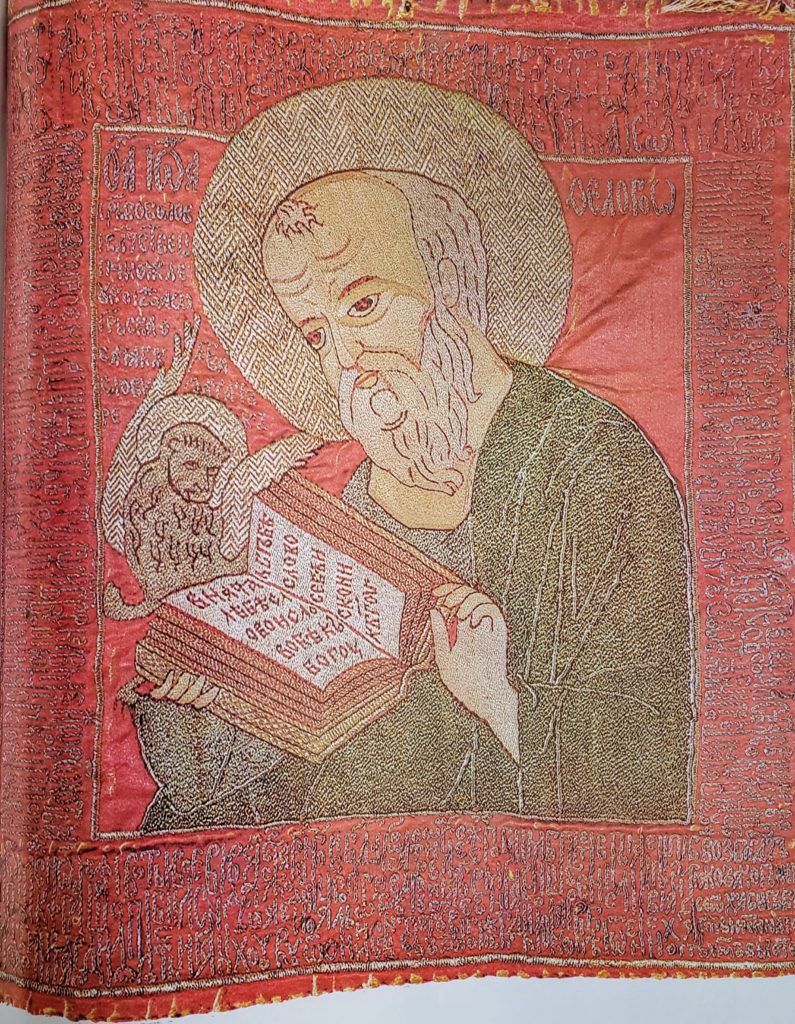
It is possible to date a podea with a rarely-seen composition depicting a half-length St. John the Theologian with an open Gospel [Illustration 47] to the Muscovite schools of embroidery of the second half of the 16th century. The figure of St. John is of accurate proportions. The face and hands are well drawn. The embroideress strives to convey the content through stitches along the direction of the work, modeling it with stripes of the same color as stitches going in other directions. The open Gospel with its first few words stands at the center of this work. The heads of St. John and of his symbol, the lion, are bowed toward the Gospel, and his hand points to it, leaving through pages. John’s face shows silent concentration. The perfection of technique, the precise beautiful drawing, and the expressiveness of the image attest to a successful combination of talent and skill between the artist and the needleworker. A bit of dissonance is introduced only by the inscription, which is of thick, “multi-level” and illegible ligature. Undoubtedly, it was “written” by a different artist, a “word writer.”
In the second half of the 16th century, the creation of a single Russian state is completed, forming a single all-Russian culture. But, just as in other forms of art, ecclesiastical embroidery is segregated into separate centers and workshops, differing in their own artistic and stylistic manners, and their own techniques.

Illustration 48
A veil depicting Novgorod bishop Nikita [Illustration 48] belongs to the mid-16th century Novgorod school of embroidery. He was one of the first Russian saints, veneration of whom arose in the early 12th century, shortly after his death (1108). Nikita was buried in St. Sophia Cathedral, in the chapel of Sts. Joachim and Anne. In 1558, his powers were revealed, and he was ranked among the all-Russian saints.
Nikita is depicted on the veil according to iconographic norms: “in the likeness of an old man, without a beard, with a wrinkled face,”[123]G.D. Filimonov. Ikonopisnyj podlinnik svodnoj redaktsii SVIII v. Moscow, 1876, p. 262. in a priest’s robes, but without a hat. Atop his head with its short, parted hair, can be seen his tonsure; his entire figure is compact, with large but graceful hands. His oval face, with its clearly drawn ears, nose, and large oblong eyes, is quite graphic. His wrinkles are drawn with thin strokes, and his hair is divided into strands. On his face, his thick double eyebrows and the clearly defined shadow below his bottom lip stand out. The expression of ascetic austerity in the bishop’s face contrasts with his smart, solemn clothing. The silk ground of his clothing is almost completely embroidered in gold and silver cross-shaped ornamentation, decorated with circles and squares of various colors. There is a garland of flowers embroidered at the lower hem. The original ground for the veil and its border, which may have once contained a donor inscription, have not survived. Based on the technical style, the ornament of the clothing, and other details, this veil is similar to another veil depicting Euphemius II of Novgorod, with an inscription that says it was donated in 1549 by a Father Superior Porfirij, whose name is found in the 1640s-1650s amongst the hegumens of Novgorod’s Vyjazhitskij Monastery.[124]P. Stroev. Spiski ierarkhov i nastojatelej mosastyrej Rossijskija tserkvi. St. Petersburg, 1877, p. 65. The veil depicting Euphemius II is stored in the Novgorod Museum [8089].[125]jeb: An image of this veil depicting Euphemius II can be seen here online. It is entirely likely that both veils were produced in one and the same workshop.
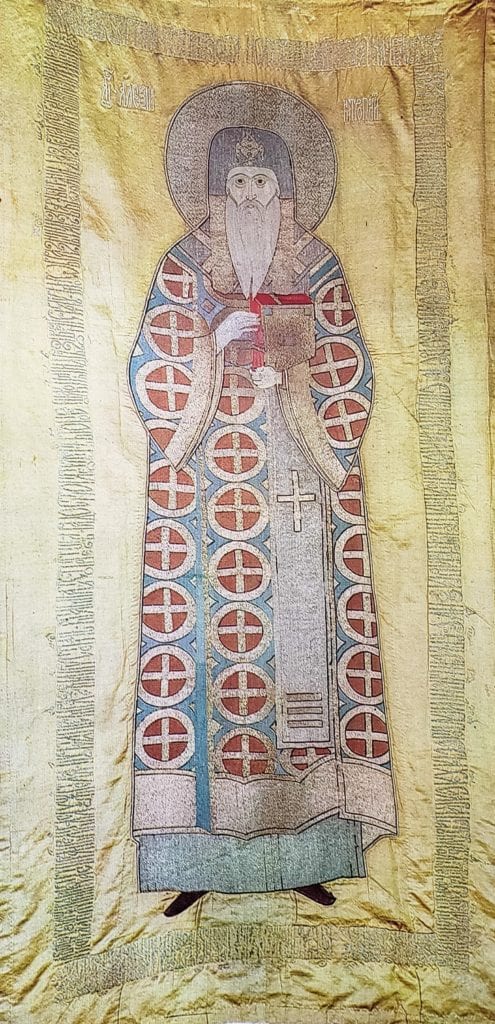
Illustration 49
An interesting example of Tverite art of the 16th century is a veil depicting Metropolitan Aleksej, with an inscription on the lining indicating it was docated to the Chudov Monastery by Simeon Bekbulatovich, known to history for his unusual fate.
In October of 1575, “Tsar Ivan Vasil’evich [“the Terrible”] appointed Simeon Bekbulatovich tsar of Moscow, and placed his royal crown upon his head, and called himself Ivan of Moscow.”[126]«Sokraschennyj vremennik.» Materialy po istorii SSSR. Vol. 2. Moscow, 1955, p. 148. The Tatar prince Simeon Bekbulatovich was crowned Tsar of All Russia for about a year, then was removed from the throne and made Grand Prince of Tver’. Until Ivan the Terrible’s death, Simeon held that location and had broad powers over internal affairs of Tver’. Around 1587, Simeon was stripped of his reign by Boris Godunov, who had grown to fear the Tatar, and was sent to the village of Kushalino, near Tver’, where he soon after went blind. He was tonsured as a monk by the False Dmitrij, lived in Kirillov, and during the reign of [Tsar Vasilij] Shujskij was exiled to Solovki. Simeon died in 1616 in Moscow, in Simonov Monastery.
Simeon was married to Anastasia, daughter of Ivan the Terrible’s closest boyar, Prince Ivan Feodorovich Mstislavskij.[127]In 1606, at the same time as her husband, she was forced to enter the convent and given the name Aleksandra. Under this year, we find her entry in the Donor Book of the Trinity-Sergiev Monastery (Zagorskij musej. Vkladnaja kniga. 1673, p. 110). She was also buried in Simonov Monastery, in 1607. The workshop from which this veil came was under her leadership.
The veil attracts attention through the picturesque nature of the metropolitan’s robes. His light blue sakkos is embroidered with gold circles and crosses against a brown field. The light blue color blends nicely with the gold embroidery and the golden-sand colored ground of the veil. The somewhat faded, pastel tones of the veil are reminiscent of one of the schools of Tverite icon painting in the 15th century, whose traditions were still in use in the 16th century. The figure of the metropolitan is stocky and almost squarish. His face is embroidered in flesh-colored silk with small amounts of shading. His dark eyes under round fine eyebrows look directly at the viewer. The face has been given an expression of concentration and attention. They do not have the severity of a bishop; instead, this is the face of the savior of Moscow and of a “kind doctor,” as it says in the inscription embroidered along the border. Contemporaries attributed Simeon Bekbulatovich’s blindness to the malice of Boris Godunov. It’s more likely that he suffered from some sort of eye-related malady. In that light, this appeal by a descendant of the Khans of the Golden Horde and true servant of the Moscow government to the Muscovite metropolitan who, according to legend, cured the blindness of Khatan Taidula. It is possible that this veil was produced in the village of Kushalino, where Simeon lived for a long time before his exile, and where he had a wealthy household with many servants.[128]N.V. Lileev. Simeon Bekbulatovich, khan kasimovskij, velikij knjaz’ vseja Rusi, vposledstvii velekij knjaz’ Tverskoj. 1567-1616 gg. Tver’, 1891.
In the second half of the 16th century, goldwork embroidery underwent a particular evolution. Silk began to be used only for hands, faces, for the embroidery of specific details, and as couching stitches for golden threads. These multicolored threads, sometimes laid down in thick, doubled or tripled couching stitches, created a wide variety of patterns, the variety of which depended on the skill of the needleworker.

One such item of goldwork embroidery is a gonfalon from the Nikolo-Besednyj Monastery. On one side, it is decorated with “John the Baptist, Angel of the Desert” [Illustration 50], and on the other, “The Appearance of the Holy Mother and St. Nicholas to the Sexton Jurash.”[129]Novgorod Museum [1988], described by A.N Svirina in: Drevnerusskoe shit’jo. pp. 122-124 (dated as a Novgorod work from the 17th century). The two sides of the banner were separated in modern times.[130]jeb: An image of this reverse side of the banner can be seen online here: https://novgorod-iss.kamiscloud.ru/entity/OBJECT/101069?fund=12&index=27 In 1560, Ivan the Terrible established the Tikhvin Assumption Monastery, associated with the growing interest in the “miracles” tied to the icon of Our Lady of Tikhvin, including the “Appearance to Jurash.” After a fire in the wooden Nikolo-Besednyj Monastery in 1562, which was built near Tikhvin on the spot where, according to legend, the Holy Virgin accompanied by St. Nicholas appeared to the sexton Georgij (Jurash), Ivan the Terrible had a new stone church built dedicated to St. Nicholas and his own patron John the Baptist. At this time, new icons, books and other ecclesiastical implements were received to replace those lost in the fire. It would appear that this banner with the image of John the Baptist and the Appearance to Jurash is of Muscovite origin. A certain refinement in the image of John the Baptist, the soft expression on his face with its fine features, the figurative slenderness of his hands and legs, and the compositional similarity to other works of Muscovite works all speak to Muscovite tradition. John the Baptist is depicted here against a landscape backdrop with trees and bushes, exactly as on an early 16th-century icon in the Tretyakovskaya Gallery; it has the same staging of the feet and the same widely spread wings. The only difference here are the arms, which are not pulled in close to the body, but instead are spread wide to either side. One hand holds a scroll and a chalice with a lamb, symbolizing sacrifice; the other is in an oratorical gesture, as if inviting the viewer to repentence: “any tree which does not create the fruit of good will be cut down.” An icon from the Stefanov-Makhrischskij Monastery painted in the 1560s shows John the Baptist holding in his left hand a scroll and a chalice containing his own severed head.[131]This icon is in the Andrej Rublev Museum [261]. See: M.E. Daen. «Novootkrytyj pamjatnik stankovoj zhivopisi epokhi Ivana Grosnogo.» Drevnerusskoe iskusstvo. Khudozhestvennaja kul’tura Moskvy i relezhaschikh k nej knjazhestv. XIV-SVI vv. Moscow, 1970, pp. 207-225. For the icon in the Tretyakovskaya Gallery, see: V.I. Antonova, N.E. Mneva. Vol 1, illus. 233.[132]jeb: This icon from the 1560s can be seen online here: https://www.icon-art.info/masterpiece.php?lng=ru&mst_id=467 Here too we see the same stance and proportions in John’s figure, and the same folds in his clothing. But, the depiction on the gonfalon does not have the same psychological tension with which the icon astounds. John’s face, embroidered in subtle flesh-colored silk without shading, has a peaceful expression. The details and contours of the face, hands and feet are outlined in red silk, emphasizing the precision and beauty of the design. The elevated use of goldwork without the use of modeling in the face, as well as the general proportions of the figures allow us to date this gonfalon to the last quarter of the 16th century.
One of the major foci of culture in Moscow in the late 16th century was the house of Dmitrij Ivanovich Godunov. Having performed various honorary posts at the court of Ivan the Terrible, and with the elevation of his nephew Boris Fjodorovich, Dmitrij Godunov occupied the role of a stable and near boyar. He seems to have been well educated, a lover of books and antiquities.[133]This is attested by the numerous psalters and other books with ownership inscriptions by Dmitrij Godunov, and amongst his donations one finds items such as the 15th century crystal chalice in the Zagorsk Museum.[134]jeb: The crystal chalice mentioned in the footnote can be seen on the right in this photograph: https://commons.wikimedia.org/wiki/File:Chalices_(Sergiev_Posad)_by_shakko_02.jpg Dmitrij Ivanovich’s fine artistic taste can be seen in his numerous donations to monasteries. His home housed several workshops, including solaria. Well-known embroidered works are associated with his second wife Matrena and his third wife Stefanida Andreevna.
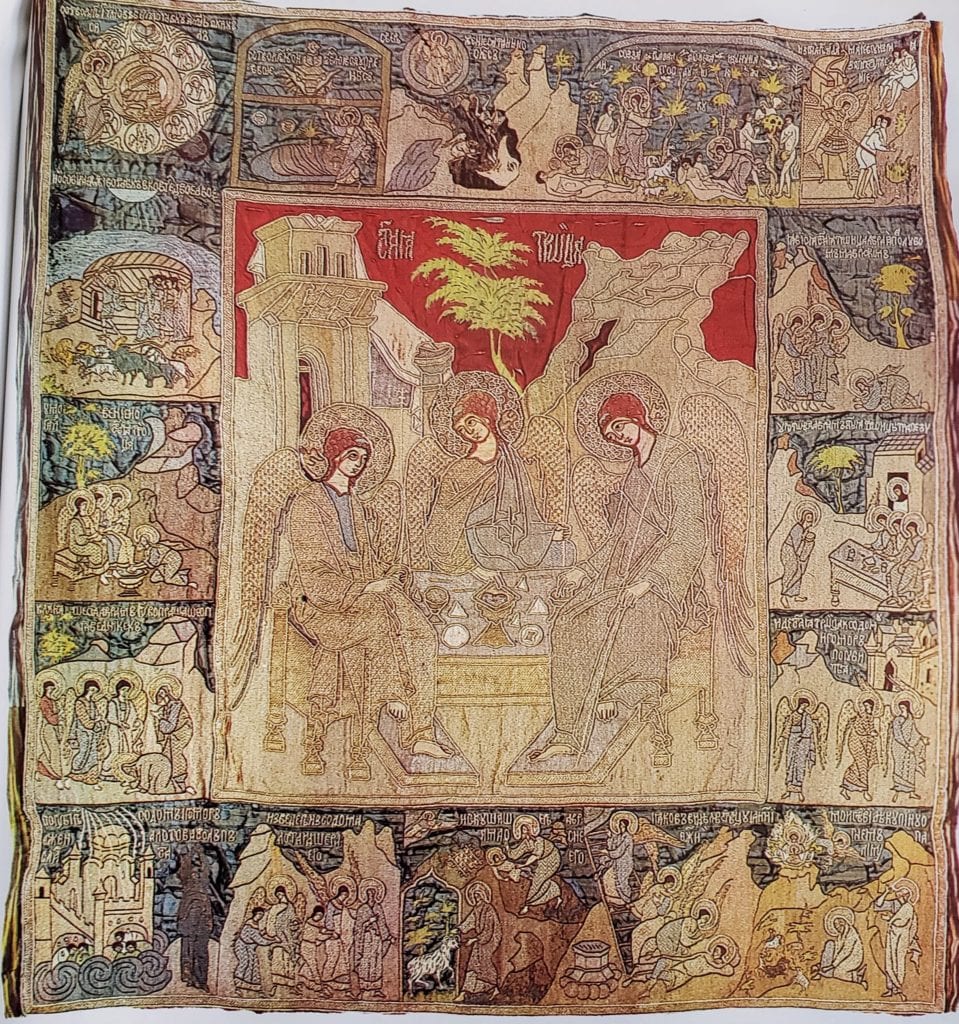
Lively and active even in old age, according to his contemporaries, Dmitrij Ivanovich personally reviewed the items in Kostroma’s Ipatiev Monastery, of which the Godunovs were ktetors, and ordered the alteration of the mantles from the dilapidated vestments.[135]Perepisnye knigi Kostromskogo Ipat’evskogo monastyrja 1595 goda. Moscow, 1890, pp. 16-19. His personal influence also was directed to the affairs of the solarium, as expressed through his selection of planning and selection of items. The most significant of the works to come out of this atelier are an epitaphios embroidered in silk with saints around the border from the 1580s[136]jeb: An image of this epitaphios can be seen online here: http://ubrus-ru.narod.ru/pl.jpg, and a podea with the image of “The Trinity, With Scenes from the Bible” [Illustrations 51, 52], donated by Dmitrij Ivanovich to Kostroma’s Ipatiev Monastery. The podea does not have a donor inscription, but is is recorded as a donation in 1593 as a precious decoration for a contemporaneous icon.[137] Archbishop Makarij. «Vklady Gdunovykh v Ipat’evskom monastyre.» Izvestija IAO. Vol 3. St. Petersburg, 1861, p. 233. The image on the podea is a variant of “The Trinity” that was in widespread use in the second half of the 16th century, also used on icons donated by Dmitrij Godunov.[138]See, for example: V.I. Antonova, N.E. Mneva. Katalog drevnerusskoj zhivopisi. Vol II, illus. 48. The border of the podea depicts the first days of the creation of the Earth and the “deeds” of the Trinity. The narrative unfolds quite narratively and expressively. The embroidery is done in small, accurate stitches. The monotone of the golden threads in the clothing is broken up by the bright, thick couching stitches and by the landscape, hills, trees, animals, details and the just-created Adam and Eve, worked in colorful silks. The figures are shown in lively, varied movement. There are many trees and animals, embroidered into several scenes. Here we see a true-to-life lamb, a fairy unicorn, a lion, and an elephant from Cosmas Indicopleustes’s book, which was popular at the time. Especially expressive is the scene of the Creation of Man [Illustration 52]. God breathes life into Adam, a small crouched man, creates a wife for him, and gives him possession of the Garden of Eden, which is populated with birds and animals. At the end of the garden near the Heavenly Gates is depicted the temptation of Adam and Eve by Satan in the form of a snake with a human head and tiny wings entwined around a tree. No less lively is the depiction of Noah’s ark. The surging waves can be seen behind arc. The door to the arc is open. Noah beats a rhythm calling to his soon-to-be passengers. First in the crowd of people streaming toward him is a graceful figure of a woman. In the foreground the animals are led by a lion. This podea of the “Trinity” is one of the great works of its day.
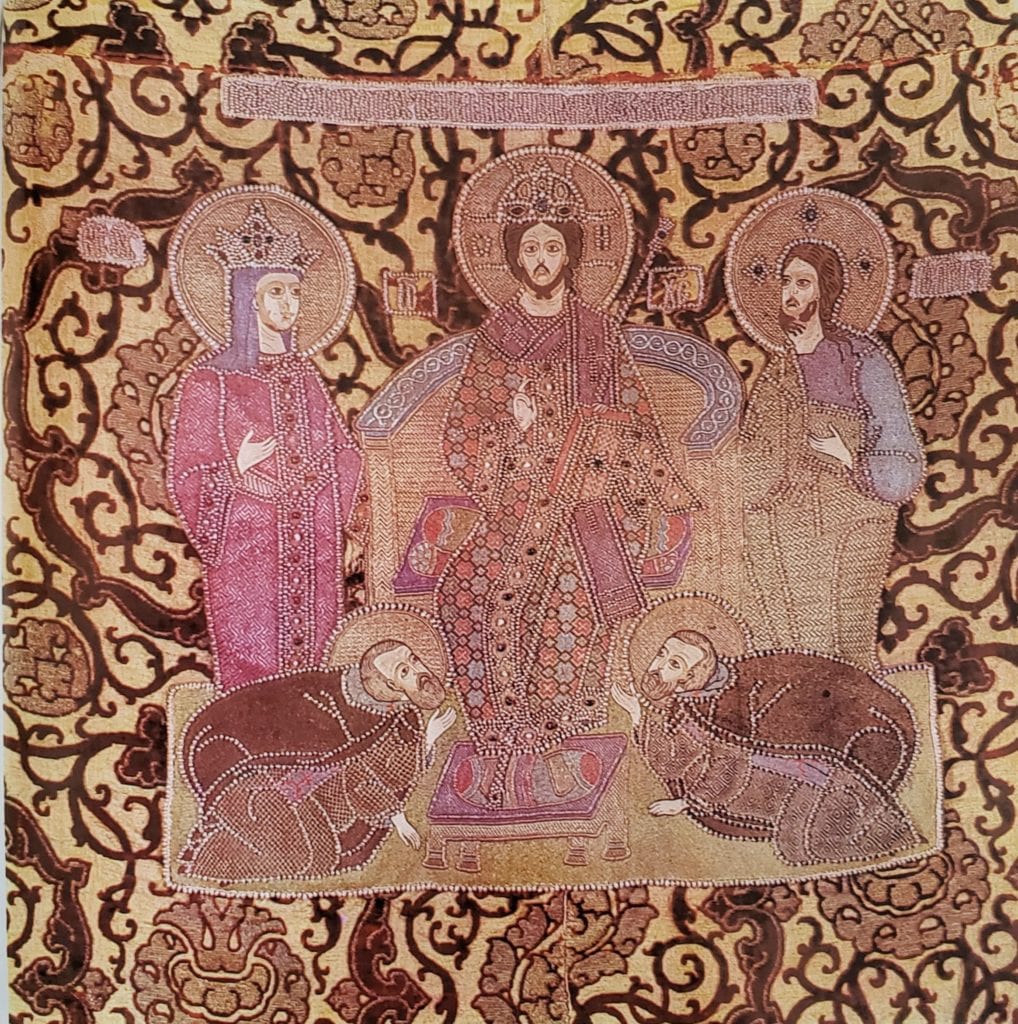
Illustration 53
Tsar Boris Fjodorovich Godunov also had an excellent workshop of embroidery. It was run by his wife, Maria Grigor’evna, the daughter of the notable Oprichnik Maljuta Skuratov. There are known works from this workshop dating to the 1580s-1590s. These embroideries are extremely precise, with a high level of technical mastery, and are distinguished by a certain dryness of design, heaviness of figure, and a muted color scheme. At the same time, the works which were produced after 1598, that is, after Boris ascended to the throne, have a noted pomposity. They have many pearls, precious stones, and gold and silver plaques. In the sumptuousness of their materials, their solemn inscriptions, and in their specific selection of saints, we see an effort by Godunov to assert the authority of his dynasty. This effort is most clearly seen on a throne cover embroidered on expensive Spanish velvet, with the solemn composition of “The Presentation of the Tsaritsa at His Right Hand” [Illustration 53]. Tradition attributes this work to Boris’s daughter, the beauty Xenia, who was poetically described by contemporaries as “revered among all women, abloom with great piety, and verily fair in all matters.”[139]«Povest’ knjazja Ivana Mikhajlovicha Katyreva-Rostovskogo.» Russkaja istoricheskaja biblioteka. Vol. 13. St. Petersburg, 1909, p. 621. The donation of this throne cover to the Trinity Monastery is tied to 1602, when Xenia was betrothed to the Danish prince John, who shortly later died in Moscow.[140]N.A. Majasova. «Literaturnyj obraz Ksenii Godunovoj i pripisyvaemye ej proizvedenija shit’ja.» TODRL. Vol. 22, Moscow-Leningrad, 1966, pp. 294-310. The embroidery on this item is masterfully done. Tiny stitches of thin spun silk of an almost greyish color and darker tones in shaded areas so skillfully sculpt the volume of the faces, that it ceases to look like embroidery and almost seems instead to have been painted with a brush. There is a striking combination of the fine facial details with the large, “burning” eyes. Particularly noticeable is the face of Christ. It is lean, beautiful and solemn, framed by His dark-brown hair and below by his forked beard. The face and pose of the “Heavenly Queen” are distinguished by a proud dignity. The thick silk couching stitches in bright colors, pearls and precious stones give the goldworked clothing a festive appearance. This is emphasized by the light openwork pattern of the golden velvet ground, on which the embroidery has been worked in high relief. The clear, somewhat graphic drawing and the refined interpretation of the faces indicate that the artist belonged to this group of Muscovite embroideresses at the end of the 16th century,[141]For example, these artists also painted a panel with the “deeds” of the Trinity, donated in 1600 by Boris Godunov to the Trinity-Sergiev Monastery (Zagorsk Museum [393]). One of the most vivid exponents of this school, Prokopij Chirin, painted an icon with the name day saints of the Boris Godunov family (V.I. Antonova, N.E. Mneva, Vol. 2, illus 118.)[142]jeb: The panel with the Deeds of the Trinity can be seen online here: http://gorod-zagorsk.ru/pic/mess050pic556.jpg a manner of art commonly referred to as the Stroganov school of painting.
Rich merchants, industrialists and “eminent people,” the Stroganovs made a significant contribution to the history of Russian culture. At their command, exquisite monuments of architecture, monumental and small painting, artistic embroidery, and silver and enamel work were created. In Solvychegodsk and the other estates of the Stroganovs, there were a variety of ateliers. For this work, they attracted the greatest “icon painters of the land,” particularly those who strove for a certain subtlety and completeness of design, elaboration of detail, and a particularly sophisticated beauty of image.[143]The Stroganov name has primarily survived to date on icons of a particular style, which led to that style being called the “Stroganov school” of art.
A number of embroidered works associated with the Stroganovs are stored in various museums, allowing us to talk about the established workshops, which had their own brightly pronounced style. Embroideries by the Stroganov needleworkers were highly valued by their contemporaries. For example, it is know that the wife of a Stroganov clerk named Aleksej Agapov created in 1681 an epitaphios for Rjazan’ Metropolitan Iosif, and received for her work a significant sum for that time – 80 rubles.[144]This epitaphios is stored in the Rjazan’ Regional Museum [3517]. More information about its creation can be found in the Accounts Book of the Bishop’s House under the year 1687. (K.N. Tikhonravov. «Svedenija o russkikh masterakh XVII i nachala XVIII v.» Izvestija IAO. Vol 3. St. Petersburg, 1861, p. 216)

Illustration 54
One remarkable example of Stroganov embroidery is the so-called “Sapiega standard” [Illustration 54]. This item received this name in connection to a 17th century legend, in which, during the Polish-Lithuanian Intervention in 1608, detachments led by Jan Sapiega “burned down all of Rostov and cut down the people,” but thanks to the “holiness” of the hermit Irinarkh, they spared Rostov’s Boris and Gleb Monastery, leaving it with a banner he had acquired somewhere as a sign of his protection.[145]This legend is told in «Zhitie Irinarkha zatvornika rostovskogo,» written in the 17th century. (A lecture by V.I. Antonova in 1946, «Okhrannoe znamja Sapegi», Archive of the State Tretyakovskaya Gallery.) Both sides of this standard are decorated with a double-sided embroidery of “The Appearance of The Archangel Michael to Joshua” before the fall of Jericho, with an accompanying Biblical text. The content of this item reflects as never before the hard year which the Russian people had lived through. The heavenly defender of the army of the righteous, the Archangel Michael, firmly grasps a sword which is held over his head. His pose and face are solemnly peaceful, inspiring confidence in victory. Joshua removes his shoes at the archangel’s command, full of readiness for battle. Both of these figures are unexpectedly dynamic, in full battle armor with fluttering capes and their faces turned to the heavens. It seems as if, having been blessed by this heavenly “priest,” he awaits further directions from the archangel to rush immediately into battle.
The artist of this work belonged to the “Stroganov school” of painting. His figures are graceful, the drawing is precise, all of the details of the clothing are depicted, and the rounded, mushroom-shaped folds of their cloaks are carefully designed. The needleworker who created this item was no less masterful. Dark blue, light bluish white, and yellow silk combine with silver and gold. Everything is embroidered rather finely and accurately, which is especially amazing if you consider the difficulty of two-sided embroidery. The face has no modeling in different tones; they are slightly graphically. As seen in the figures’ stances and in the depiction of the archangel’s clothes and wings, at this time, there was a push toward a certain spaciality.
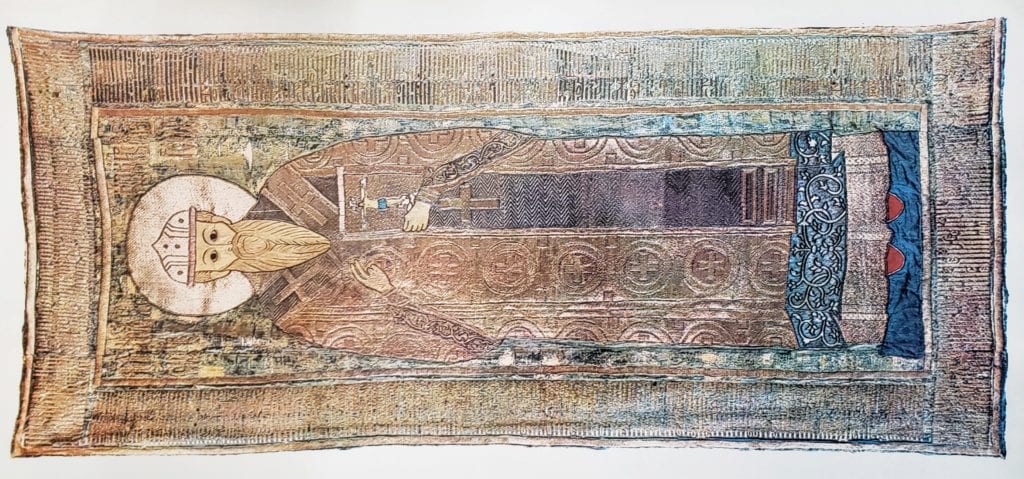
Illustration 55
In the Museums of the Moscow Kremlin can be found one of the best examples of Stroganov embroidery of the mid-17th century – a veil depicting Metropolitan Jonah [Illustration 55]. An inscription on the veil’s lining says that it was donated in 1657 “at the order of Grigorij Dmitriev, son of Stroganov.” Grigorij himself was only a year old at this time. But, his name is associated with a number of embroidered donations. A majority of these were created under the direction of his mother, Anna Ivanovna, who was herself a skilled needleworker.[146]Evidence of this can be found in the inscription on a podea depicting the Tsarevich Dmitrij. For more about Stroganov embroidery, see: E.V. Georgievskaja-Druzhinina. «Stroganovskoe shit’jo.» Russkoe isksstvo XVII v. Leningrad, 1929, pp. 109-133. The embroidery on this veil shows the inherent thoroughness common to this school. Thin, twisted greenish-grey silk in small, densely packed stitches form the volume of the face, emphasized by its deep wrinkles. The features and contours of the face and the strands of hair are outlined in dark green silk, shaded and transposed with bright green. This technique, which is not found in other works, speaks to the variety of artistic means used by the Stroganov needleworkers. In addition, the modeling of the face here is carried out with the tactful moderation which so favorably distinguishes works by the Stroganovs from the majority of other works from the 17th century. The features of the metropolitan’s face are finely, subtly wrought, with the characteristic raised eyebrows and large hazel eyes. In his robes, a restrained color scheme of silver and gold threads couched in red and green combines with ornamentally patterned trim along the hem and sleeves.
In embroidery of the 17th century, the tendencies seen in the second half of the 16th century continue to develop. The technique of conveying volume in the body and face through the use of shading via darker tones of silk becomes increasingly important. This shading, taken to an extreme, often takes the form of dark stripes, transforming the face into a mask. Embroidery in colored silks is increasingly replaced by goldwork. Often, very thin silk in colors of gold or silver are used to create inconspicuous couching stitches, making the images look like they are covered in a gold icon cover. The haloes and details of clothing are embroidered in relief ornamentation to resemble chased metal. “Plant shapes” are embroidered on the ground to imitate expensive gold fabric. Pearls and expensive stones are seen in greater numbers than on earlier works. All of this translates gives the embroidery a certain flatness and ornamentality. These characteristics are seen to different degrees in different workshops, depending to a great degree on the skill and talent of the artists and needleworkers.
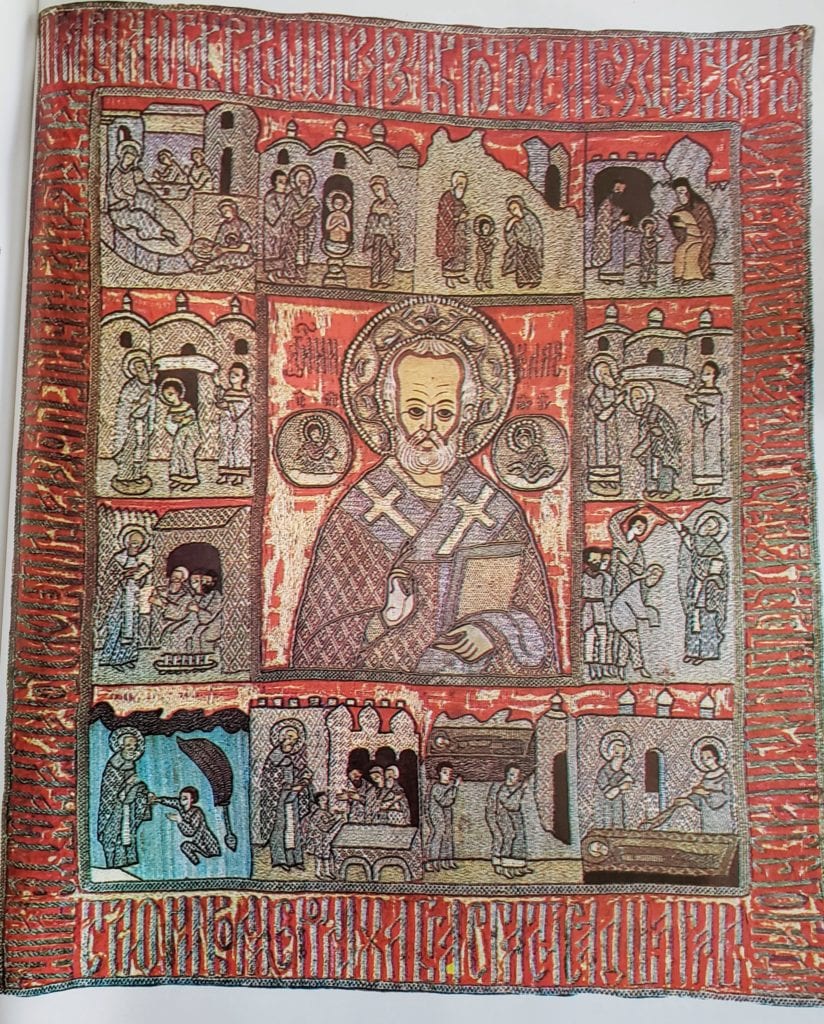
One characteristic work of Muscovite embroidery of the 17th century is a podea depicting a bust of St. Nicholas with scenes of his life [Illustration 56]. This podea was worked in one of the better workshops, possibly even the Tsaritsa’s solarium. Despite being framed by a dark stripe, the face has not lost its expressiveness. The stitches of thin, unwound silk are laid down tightly against one another, revealing the artist’s drawing. The halo is decoratively outlined in pearls with floral designs in high relief. There are various patterns of goldwork embroidery. Around the image there is a liturgical inscription, written in good, precise ligature-style. But, the architectural elements and hills have lost their former picturesque quality, and the figures are in heavy clothes which hide the form of the body, creating a certain static character and stiffness of movement.
Far and away more information about workshops and needleworkers has survived from the 17th century to modern day than from earlier centuries. “Well-known Works from the Solaria” [«Svetlichnye znamennye dela»], published by I.E. Zabelin,[147]I.E. Zabelin, pp. 723-729 and other works about the royal workshops mention, among other names, such well known icon painters as Ivan Paiseni and Simon Ushakov. Several artisans may have worked on large pieces. So, for example, the “attribution” on an epitaphios donated in 1547 by Tsar Aleksej Mikhajlovich to the Novospasskij Monastery, would have indicated the entire atelier of icon painters in the Armory Palace: Sidor Pospeev, Ivan Solovej, Ivan Muravej, Ivan Borisov, Kozma Chertenok, and Kirill Ivanov.[148]I.E. Zabelin, p. 727. The epitaphios is stored in the Museums of the Russian Kremlin [12608 op]. It would appear that no fewer needleworkers took part in the creation of work, which according to the inscription took over 2 years to embroider. Embroidery of epitaphia in other workshops took roughly the same amount of time.[149]The inscription on a Zagorsk epitaphios by I.I. Golitsyna attests that it was started in 1595, and finished in 1598. (The Zagorsk Museum, no. 2425.) In the 17th century, aside from the Tsaritsa’s and Stroganovs’ workshops, the workshops of Princess Dar’ya Ivanovna Dashkova (wife of Okolnichy Vasilij Semenovich Volynskij), Akilina Petrovna Buturlina, and others were also well-known.
Following the main course of evolution in Russian culture, ecclesiastical embroidery developed its artistic techniques and means of expression and took a place of pride amongst other forms of medieval Russian fine art.
Specific features of ecclesiastical embroidery, such as donor inscriptions with dates and names or the selection of subject tied to the fortunes of its donor, transforms these works into milestones for the study of other works of medieval Russian art, which typically lack dates and names.
At the same time, thanks to these details, works of embroidery become their own kind of historical sources, sometimes revealing important circumstances of life, various historical details, and their public and political interests.
Along with this, being a collective artform where needleworkers participate alongside a row of artisan icon painters and word writers, ecclesiastical embroidery attests to the great talent of Russian women and their meaning in the cultural and societal life of medieval Russia.
As such, this remarkable art reveals to use one more bright, idiosyncratic page of medieval Russian culture.
List of Illustrations
- The Archangel (Gonfalon, First half of the 14th century, Moscow)
- The Entombment (Epitaphios, Early 15th century, Moscow(?))
- The All-Merciful Savior, with the Forthcoming (Altar cloth(?), Late 14th century, Moscow(?).
- Archangel Michael (detail of the altar cloth “The All-Merciful Savior, with the Forthcoming,” illustration 3)
- Savior Not Made By Hands, with the Forthcoming (Aër, 1389, Moscow)
- John the Baptist, the Archangel Gabriel, Metropolitans Maksimos and Theognostus, Nicetus the Goth, Demetrius of Thessaloniki, and Prince Vladimir (Detail of the Aër “Savior Not Made By Hands, with the Forthcoming,” illustration 5)
- St. Sergius of Radonezh (Veil, 1420s, Moscow)
- St. Sergius of Radonezh (detail of the veil “St. Sergius of Radonezh,” illustration 7)
- St. Demetrius of Thessaloniki (embroidered icon, first quarter of the 15th century, Moscow)
- The Eucharist, with Scenes of the Lives of Joachim, Anna and the Mother of God (Aër, 1410-1413, Moscow)
- The Announcement to Anne of Joachim’s Return (detail of the Aër “The Eucharist, with Scenes of the Lives of Joachim, Anna and the Mother of God,” illustration 10)
- The Trinity, with Holidays (Veil, second half of the 15th century, Moscow)
- The Dormition of the Virgin (Podea, second half of the 15th century, Moscow)
- Our Lady of the Burning Bush with Saints (Podea, second half of the 15th century, Moscow)
- The Appearance of the Mother of God to St. Sergius (Podea, second half of the 15th century, Moscow)
- The Burial of St. Anne (Podea, last quarter of the 15th century, Moscow)
- Deësis Row (Embroidered iconostasis, mid-15th century, Novgorod)
- Archangel Michael (Detail of the Deësis Row, illustration 17)
- The Entombment (Podea, second half of the 15th century, Novgorod)
- Archangel Michael (Embroidered icon, late 15th-early 16th century, Novgorod(?))
- Peter the Apostle (Embroidered icon, late 15th-early 16th century, Novgorod(?))
- St. Catherine the Martyr with Scenes of Her Life (Podea, late 15th-early 16th century, Novgorod)
- The Beheading of St. Catherine (Detail of the podea “St. Catherine the Martyr with Scenes of Her Life,” illustration 22)
- The Eucharist, with Scenes of the Lives of Joachim, Anne and the Holy Mother (Aër, 1485, Rjazan’)
- The Conception of the Mother of God (Detail of the podea “The Eucharist, with Scenes of the Lives of Joachim, Anne and the Mother of God,” illustration 24)
- Our Lady of Smolensk (Podea, 1460s, Moscow)
- Liturgical Procession (Podea, 1498, Moscow)
- The Beheading of John the Baptist (Podea, 1490s, Moscow)
- Holidays and Saints (Podea, 1499, Moscow)
- The Archangel Gabriel and St. Basil of Parium (Detail of the podea “Holidays and Saints,” illustration 29)
- The Descent of the Holy Spirit Upon the Apostles (Detail of the podea “Holidays and Saints,” illustration 29)
- St. Nicholas (Podea, early 16th century, Moscow)
- The Dormition of the Virgin (Podea, early 16th century, Moscow(?))
- The Birth of the Holy Mother (Podea, 1510, Volokolamsk)
- The Evangelism to Joachim in the Desert (Detail of the podea “Birth of the Mother of God,” illustration 34)
- The First Steps of the Mother of God (Detail of the podea “Birth of the Mother of God,” illustration 34)
- The Crucifixion (Altar cloth, 1514, Moscow)
- The Appearance of the Mother of God to St. Sergius, with Holidays and Saints (Podea, 1525, Moscow)
- The Ascension (Detail of the podea “The Appearance of the Mother of God to St. Sergius, with Holidays and Saints,” illustration 38)
- Cyril of Belozersk, with Scenes of His Life (Podea, first quarter of the 16th century, Moscow)
- Selected Saints (Podea, first half of the 16th century, Moscow)
- St. Nicholas of Mozhajsk (Podea, first half of the 16th century, Moscow)
- St. Nicetas the Stylite of Pereslavl (Veil, 1555-1560, Moscow)
- The Entombment (Epitaphios, 1561, Moscow)
- The Mother of God and the Myrrh-Bearers (Detail of the epitaphios “The Entombment,” illustration 44)
- St. John Chrysostom (Detail of the epitaphios “The Entombment,” illustration 44)
- St. John the Theologian (Podea, second half of the 16th century, Moscow)
- St. Nikita, Bishop of Novgorod (Veil, mid-16th century, Novgorod)
- Metropolitan Aleksej (Veil, 1581(?), Tver’)
- John the Baptist, Angel of the Desert (Gonfalon, last quarter of the 16th century, Moscow)
- The Trinity, with Scenes from the Bible (Podea, 1593, Moscow)
- The Creation of Adam and Eve, and Their Temptation by Satan (Detail of the podea “The Trinity, with the Acts,” illustration 51)
- The Presentation of the Tsaritsa (Throne cover, 1602, Moscow)
- The Appearance of the Archangel Michael to Joshua (Banner, early 17th century, Sol’vychegodsk(?))
- Metropolitan Jonah (Veil, 1657, Sol’vychegodsk)
- St. Nicholas, with Scenes of His Life (Podea, second half of the 17th century, Moscow)
Illustration 1: The Archangel

Acquired in 1925 from the State Museum Fund.
State Museums of the Moscow Kremlin (16211op).
An angel is depicted in a loros, holding a mirror in his left hand and a staff in his right. The face and hands are embroidered in a greenish flesh-colored silk in split stitch. The locks of hair are outlined in gold. The clothes and wings are embroidered in gold using passing stitches. The feathers, folds of clothing, and ornament are stitched in dark-green silk, and in places in gold. The original ground fabric, a brown silk, has not survived and is visible only in places where the embroidery has been lost. The image has been cut out along the outline and transferred to a later lingonberry-colored satin.
- Ainalov, D. Geschichte der russischen Monumentalkunst zur Zeit des Grossfürstentums Moskau. Berlin and Leipzig, 1933, p. 117, illus. 65a.
- Svirin, A.N. Drevnerusskoe shit’jo. Moscow, 1963, pp. 27-28.
Illustration 2: The Entombment

From the Trinity-Sergiev Lavra.
Zagorsk State Historical-Artistic Museum-Reserve (2437).
This epitaphios depicts the scene of the Lamentation of Christ. The Holy Mother stands at the head of the coffin, and John the Baptist stands at the foot. Around the tomb stand angels with liturgical fans, and behind the tomb is a ciborium with a lamp. Between the stars overhead are embroidered weeping angels, and the Sun and Moon representing the Tsar and Tsarina. In the corners are the symbols of the Evangelists. In the lower central section and on the borders there are liturgical inscriptions. Faces and hands are stitched in flesh-colored silk and the hair in light brown silk, both in split stitch. The remainder is worked in couched gold and silver threads. The original ground, a dark blue damask, has not survived and is visible only in spots where the embroidery is worn away. A dark blue homespun now serves as the ground. This item has acquired the nickname of “the Light Blue Epitaphios”.
- Majasova, N.A. “Khudozhestvennoe shit’jo.” Troitse-Sergieva Lavra. Khudozhestvennye pamjatniki. Moscow, 1968, pp. 117-118, illus. 132.
- Nikolaeva, T.V. Sobranie drevnerusskogo iskusstva v Zagorskom muzee. Leningrad, (no date), illus. 52.
- Majasova, N.A. “Pamjatnik moskovskogo zolotnogo shit’ja XV veka.” Drevnerusskoe iskusstvo. Khudozhestvennaja kul’tura Moskvy i prilezhaschikh k nej knjazhestv. XIV-XVI vv. Moscow, 1970, pp. 491-493.
Illustration 3: The All-Merciful Savior, with the Forthcoming

Novgorod Historical-Artistic Museum-Reserve (5859)
Images of the Savior on His throne, the Mother of God, John the Baptist, and the archangels Michael and Gabriel standing before him, and the Evangelists in the corners are embroidered in multicolored silks and wrapped gold and silver thread with inconspicuous couching stitches. The figures and name inscriptions were removed from the original ground fabric (a red silk) and transferred to a red brocade in the 17th century. Another patch of fabric was added near the bottom in the 18th century.
- Lazarev, V.N. Iskusstvo Novgoroda. Moscow-Leningrad, 1947, p. 129.
- Svirin, A.N. Drevnerusskoe shit’jo. Moscow, 1963, p. 27.
Illustration 4: Archangel Michael

Illustration 5: Savior Not Made By Hands, with the Forthcoming
In the center, the Image of Edessa is embroidered in multicolored silk in split stitch on a golden-sand colored taffeta; facing him in prayer are: left – the Mother of God, the Archangel Michael, and Metropolitans Peter and Aleksej; right – John the Baptist, the Archangel Gabriel, and the Metropolitans Maksimos and Theognostus. Below are 8 half-length, forward facing figures: the Princes Sts. Gleb and Boris, St. Alexius of Rome, St. Nicholas, St. Gregory the Theologian, Nicetas the Goth, Demetrius of Thessaloniki, and Prince Vladimir. The border of light blue Italian damask is decorated with half-length figures of angels and archangels holding rods and mirrors; in the corners, framed in circles, the Evangelists are writing. The halos are in wrapped gold thread. The outlines of the figures and the folds of clothing are in silver thread. The ornament outlining the center section and on the edges of the Aër is decorated in gold on a dark-violet satin. The name inscriptions over the figures and a liturgical inscription on the upper and lower borders are in flesh-colored silk, which blends into the background. A similarly embroidered donor inscription in three lines is located in the lower left corner of the center section: “In the year 6897 [1389], this Aër was created at the command of Grand Princess Maria Semenova.” The embroidery has worn away in many locations. Beneath the missing stitches, the original artist’s cartoon can be seen, drawn in grey and rose-colored ink. There are damage and patches throughout the piece.
- Trutovskij, V. “Muzej Petra Ivanovicha Shukina v Moskve.” Khudozhestvennye sokrovischa Rossii. Vol. II, no. 6. St. Petersburg, 1902, pp. 113, 125, illus. 56.
- Ainalov, D. Geschichte der russischen Monumentalkunst zur Zeit des Grossfürstentums Moskau. Berlin and Leipzig, 1933, p. 119, illus. 67c.
- Istorija russkogo iskusstva. Vol III. Moscow, 1955, pp. 194-196, illus. on pp. 198-199.
- Svirin, A.N. Drevnerusskoe shit’jo. Moscow, 1963, p. 41-42.
- Majasova, N.A. “Pamjatnik moskovskogo zolotnogo shit’ja XV veka.” Drevnerusskoe iskusstvo. Khudozhestvennaja kul’tura Moskvy v prilezhaschikh k nej khjazhestv XIV-XVI vv. Moscow, 1970, p. 491.
Illustration 6: John the Baptist, the Archangel Gabriel, Metropolitans Maksimos and Theognostus, Nicetus the Goth, Demetrius of Thessaloniki, and Prince Vladimir

Illustration 7: St. Sergius of Radonezh
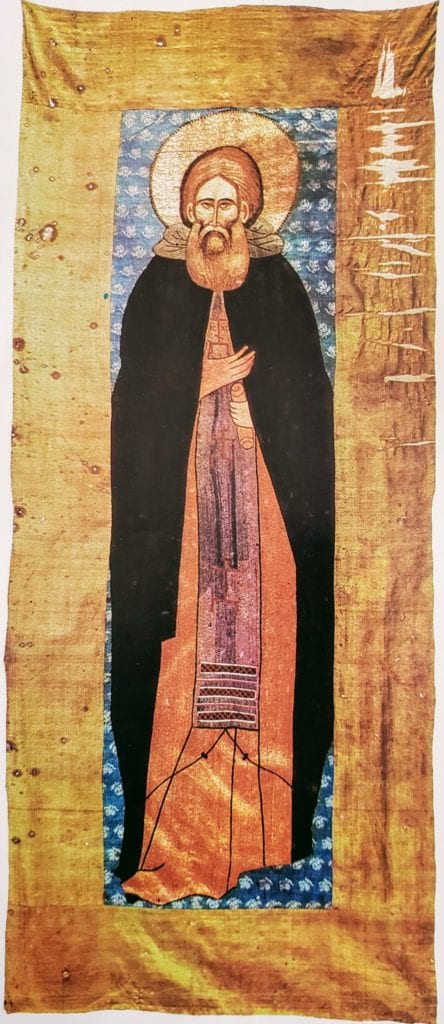
From the Trinity-Sergiev Lavra.
Zagorsk State Historical-Artistic Museum-Reserve (412).
St. Sergius’ face is embroidered in flesh-colored silk in large split stitches along the contours of the muscles, with highlights in grey and brown silk of various tones. The details of the face, nose, lips and hands are worked in red silk, as are the folds of his ears. His hair and beard are of grey, red and brown silk; the halo is in wrapped gold thread, and his clothes are of laid-and-couched silk thread. The image was removed from its original ground (a brown damask) and transferred to a light-blue silk fabric in the 18th century. The lower right corner of the figure has been lost. The border of light-green silk was added later.
- Scherbakov, N.A. and Svirin, A.N. K voprosu o tvorchestve Andreja Rubleva. Sergiev, 1928, pp. 15-16, illus. II.
- Ainalov, D. Geschichte der russischen Monumentalkunst zur Zeit des Grossfürstentums Moskau. Berlin and Leipzig, 1933, p. 119, illus. 72a, 72b.
- Istorija russkogo iskusstva. Vol III. Moscow, 1955, pp. 196-198, illus. on pp. 202.
- Svirin, A.N. Drevnerusskoe shit’jo. Moscow, 1963, p. 42-45.
- Alpatov, M.W. Tesori dell’ Arte Russa. Milano, 1966, p. 87.
- Majasova, N.A. “Khudozhestvennoe shit’jo.” Troitse-Sergieva Lavra. Khudozhestvennye pamjatniki. Moscow, 1968, pp. 118-119, illus. 133-135.
- Nikolaeva, T.V. Sobranie drevnerusskogo iskusstva v Zagorskom muzee. Leningrad, (no date), illus. 53, 54.
Illustration 8: St. Sergius of Radonezh

Illustration 9: St. Demetrius of Thessaloniki
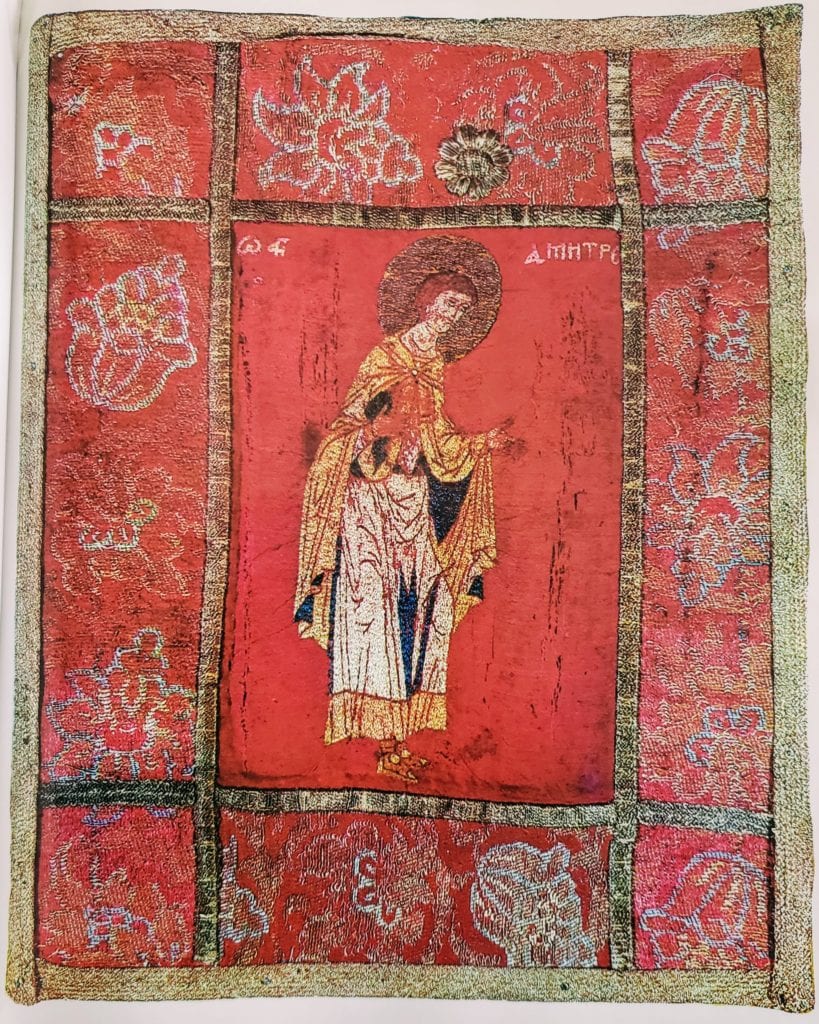
Acquired in 1927 from the Museum of Graceful Arts.
State Museums of the Moscow Kremlin (17330op)
Demetrius of Thessaloniki, standing in prayer, is embroidered in multicolored silk split stitches on red taffeta. His halo is worked in wrapped silver threads with inconspicuous couching stitches. The border in gold satin is 17th century, with braid added later. The relief bands and rosettes are worked in silver. The fabric is attached to a wooden board, which is covered in yellow taffeta.
Illustration 10: The Eucharist, with Scenes of the Lives of Joachim, Anna and the Mother of God
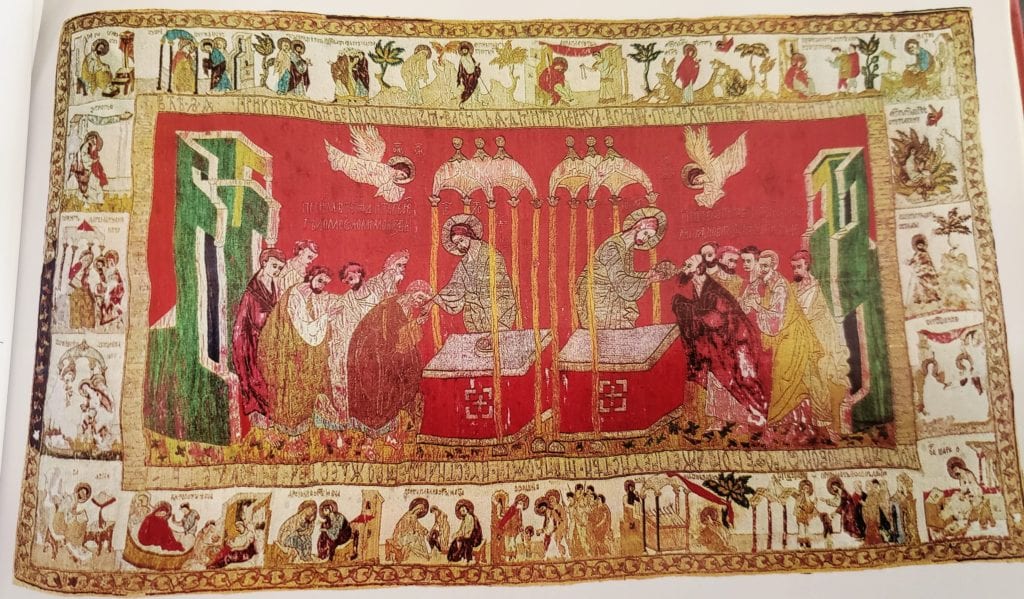
From the Cathedral of the Birth of the Holy Virgin, Suzdal’.
State Historical Museum (2rb).
The center depicts the scene of Christ’s communion with the Apostles, giving them wine and bread, with the Archangels Michael and Gabriel flying toward the altars. The border has the Evangelists (in the corners) and 18 scenes from the Lives of Sts. Joachim, Anne and the Holy Mother:
- The Presentation of Gifts
- Reproach for their Childlessness
- Joachim’s Exile to the Desert
- The Tears of Anne
- The Annunciation to Anne
- The Announcement to Anne of Joachim’s Return
- The Annunciation to Joachim
- Joachim’s Return
- The Conception
- Anne and Joachim’s Receipt of Gifts
- The Priest Blesses Them
- The Birth of the Mother of God
- The Caress
- The Arrival (The First Steps)
- The Introduction at the Temple
- The Prayer for the Rods
- The Presentation of Mary to Joseph
- The Annunciation
The figures are embroidered in multi-colored silk in stem and split stitches. Christ’s robes, the haloes, altars, contours of the figures, inscriptions and various other details are worked in wrapped silver and gold thread with inconspicuous couching stitches. A donor inscription runs around the central section: “In the year 69[00], during the reign of Vasilij Dmitrievich, Grand Prince of All Rus’, and of Archbishop Photius, Metropolitan of All Rus’, and of Bishop Mitrofan, this Aër was made by Konstantin’s Ogrofena, servant of God, even for the Most Pure Mother of God and her honorable birth, completed on the 2nd in the month of June, in memory of Father Nikifor.” During restoration in the 19th(?) century, the ground of the central section (a crimson brocade) was almost completely covered in crimson stitches. The ground for the border (a sand-colored brocade) was covered in white silk, and parts of the inscriptions in the border and other sections were embroidered anew.
- Tikhonravov, K.N. “Shitaja pelena XV v. v Suzdal’skom Rozhdestvenskom sobore.” Izvestija russkogo arkheologicheskogo obschestva. Vol. I. St. Petersburg, 1859, pp. 212-214.
- Schepkin, V.N. “Pamjatnik zolotnogo shit’ja nachala XV v.” Drevnosti. Trudy IMAO. Vol. 15, Issues 1-2, Moscow, 1894, pp. 35-68.
- Svirin, A.N. Drevnerusskoe shit’jo. Moscow, 1963, p. 48-49, illus. on p. 51.
Illustration 11: The Announcement to Anne of Joachim’s Return
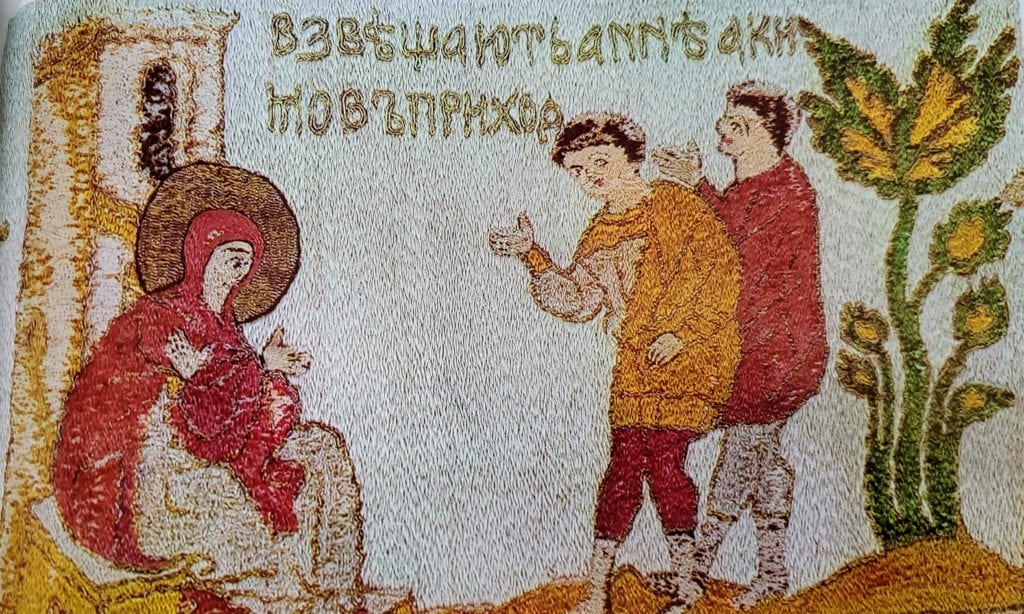
Illustration 12: The Trinity, with Holidays
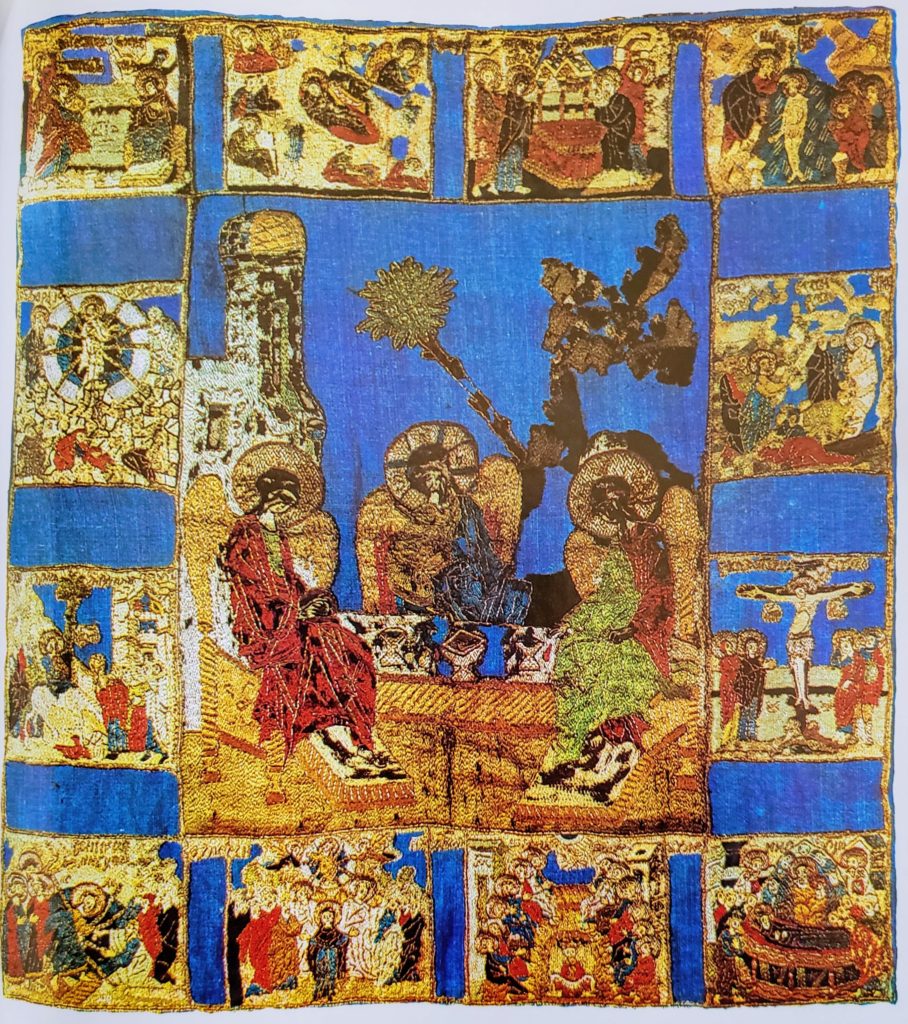
From the Trinity-Sergiev Lavra.
Zagorsk State Historical-Artistic Museum-Reserve (361).
The center of this podea depicts the Old Testament Trinity. Around the border, from the top and left to right:
- The Annunciation
- The Nativity
- Candlemas
- The Baptism
- The Transfiguration
- The Resurrection of Lazarus
- The Entry into Jerusalem
- The Crucifixion
- The Descent into Hell
- The Ascension
- The Descent of the Holy Spirit Upon the Apostles
- The Dormition of the Virgin
The figures are embroidered in multi-colored silk split stitches. The halos, outlines, folds of clothing, inscriptions and other details are embroidered in gold. The original ground – a brown damask in the center and sand-colored on the border – has not survived and is visible only in places where the embroidery has been lost. During restoration in 1951, the figures were transferred onto a dark blue homespun fabric.
- Istorija russkogo iskusstva. Vol III. Moscow, 1955, pp. 200, illus. on pp. 203.
- Antonova, V.I. “O pervonachal’nom meste «Troitsy» Andreja Rubleva.” Gosudarstvennaja Tret’jakovskaja galereja. Materialy i issledovanija. Iss. 1. Moscow, 1956, p. 29.
- Svirin, A.N. Drevnerusskoe shit’jo. Moscow, 1963, p. 45-46, illus. on p. 48.
- Majasova, N.A. “Khudozhestvennoe shit’jo.” Troitse-Sergieva Lavra. Khudozhestvennye pamjatniki. Moscow, 1968, pp. 120-121, illus. 137.
- Nikolaeva, T.V. Sobranie drevnerusskogo iskusstva v Zagorskom muzee. Leningrad, (no date), illus. 58.
Illustration 13: The Dormition of the Virgin
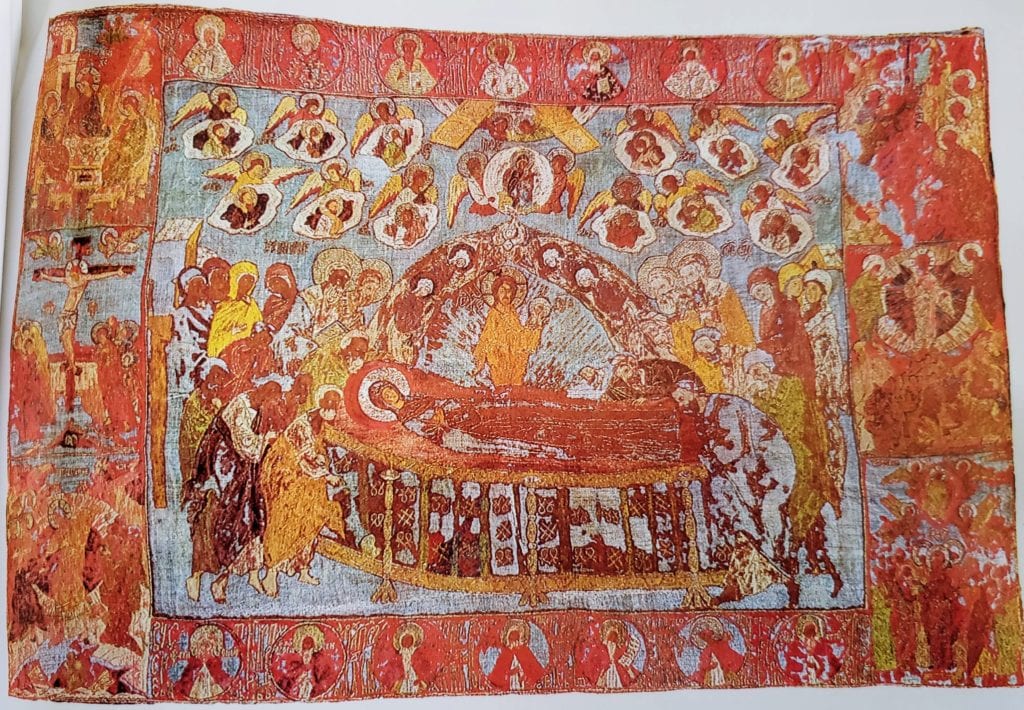
From the Uspenskij-Knjaginina Monastery in Vladimir.
State Tretyakovskaya Gallery (20981).
In the center is depicted the so-called “Cloudy Dormition”, with the apostles carried aloft on clouds. The left border depicts the Trinity, the Crucifixion and the Descent into Hell; the right depicts the Baptism, the Transfiguration and the Ascension. Above, in round frames, are the half-length portraits of Metropolitan Peter, St. Nicholas, St. Basil of Caesarea, St. John Chrysostom, St. Gregory the Theologian, St. John the Merciful(?), and Metropolitan Aleksej. On the bottom: Sts. Anthony and Theodosius of the Caves, St. Euphemius of Suzdal’, St. Savva Visherskij, St. Varlaam and Prince Ioasaf, and St. Dmitrij Prilutskij. Between the frames, there is a liturgical inscription. The figures are embroidered in multi-colored silk; the halos, outlines and other details are in wrapped gold thread. The original ground, a brown damask, has not survived. A light blue homespun now serves as the ground for the center, and on the border, a crimson silk. The flesh-colored silk used for the faces has, in places, darkened or been lost.
- Ushakov, N.N. Sputnik po drevnemu Vladimiru i gorodam Vladimirskoj gubernii. Vladimir, 1913, p. 113.
- Svirin, A.N. Drevnerusskoe shit’jo. Moscow, 1963, p. 62-64.
Illustration 14: Our Lady of the Burning Bush, with Saints
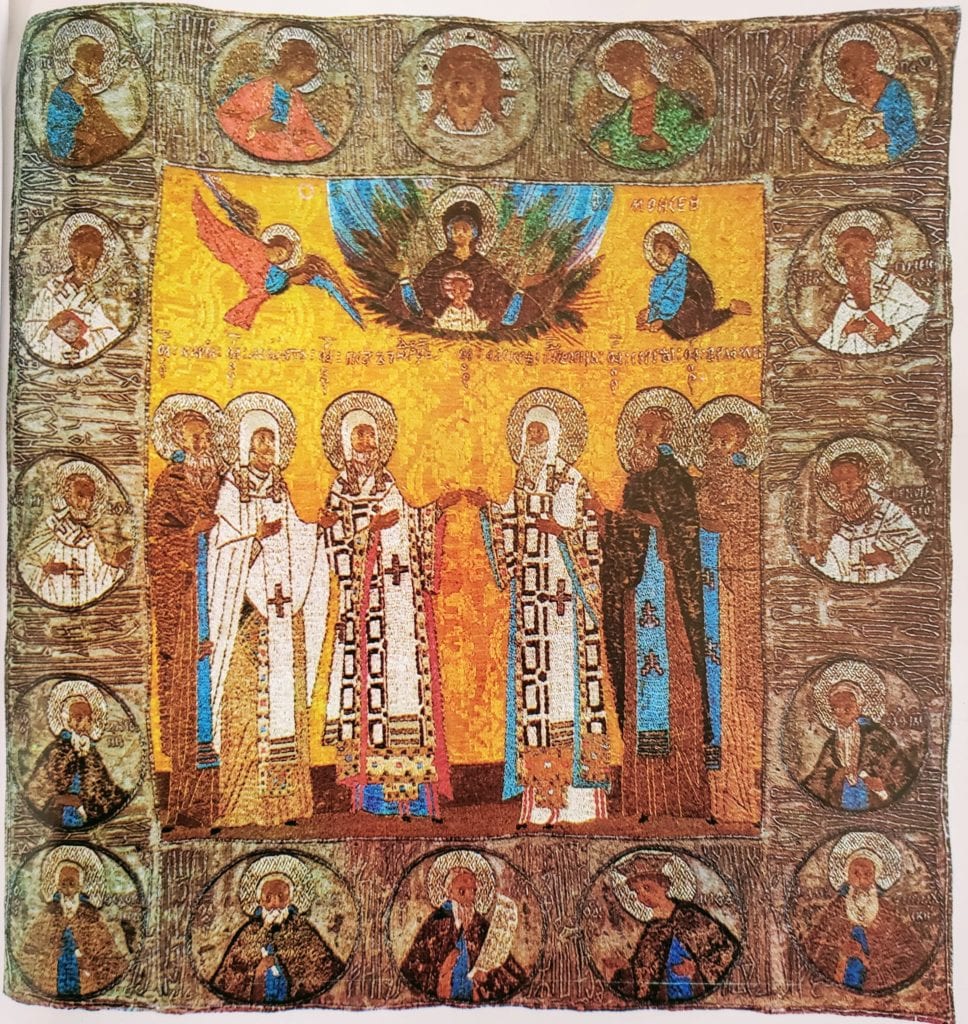
From the Kirillo-Belozersk Monastery.
State Russian Museum (31).
At the top of the center section, Our Lady of the Burning Bush is depicted as Our Lady of the Sign against a backdrop of the burning bush; to the left is an angel, and to the right is Moses. Below, two groups of saints stand in prayer: left – Metropolitan Pjotr, Leontij of Rostov, and Cyril of Belozersk; right – Metropolitan Aleksej, Sergius of Radonezh, and Varlaam of Khutyn. On the border, 16 round frames depict: top – the Savior Not Made by Hands, the Archangels Michael and Gabriel, and the Apostles Peter and Paul; bottom (left to right) – John Chrysostom, Basil of Caesarea, Nicholas, Gregory the Theologian, Anthony of the Caves, Euphemius of Suzdal’, Theodosius of the Caves, Savva Vischerskij, Varlaam and Prince Ioasaf, and Dmitrij Prilutskij. Between the frames, there is a liturgical inscription. The figures are embroidered in bright, multi-colored silk; the haloes and inscriptions are in wrapped gold thread. The ground in the center is a yellow damask; the border is a brown damask. The flesh-colored silk used for the faces has darkened and been lost in places.
- Schekotov, N.M. “Drevnerusskoe shit’jo.” Sofija. 1914(1), p. 13.
- Lebedeva, Ju.A. Katalog drevnerusskogo shit’ja sobranija Gosudarstvennogo Russkogo muzeja. (manuscript, 1957)
- Alpatov, M.W. Tesori dell’ Arte Russa. Milano, 1966, p. 129.
Illustration 15: The Appearance of the Mother of God to St. Sergius
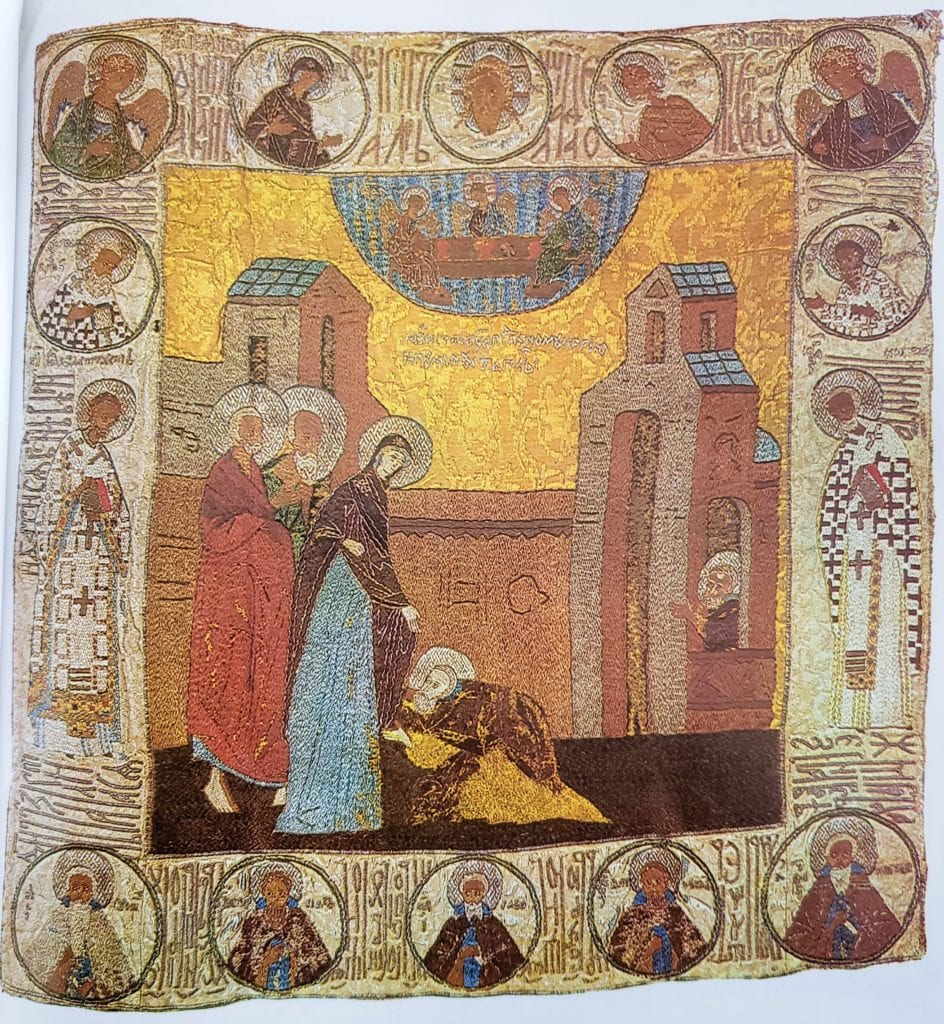
From the State Museum Fund.
State Museums of the Moscow Kremlin (12663op)
In the center, on a yellow damask, is embroidered the Appearance of the Mother of God to St. Sergius, with the Old Testament Trinity above in a segment. On the border of pale-yellow damask, various figures are shown in circular frames: top (left to right): the Archangel Michael, the Mother of God, the Image of Edessa, John the Baptist, the Archangel Gabriel; left – Gregory the Theologian, and a full-length figure of St. John Chrysostom; right – Basil of Caesarea, and a full-length St. Nicholas; bottom – Euphemius of Suzdal’, Kiril of Belozerk, Savva Visherskij, Varlaam of Khutyn, and Anthony of the Caves(?). Above the figures and on the background there are name inscriptions. Along the border, between the frames there is a liturgical inscription. All are embroidered in silk of various colors in split stitch. The halos, outlines, folds of clothing, inscriptions, and other details are worked in gold thread.
Illustration 16: The Burial of St. Anne
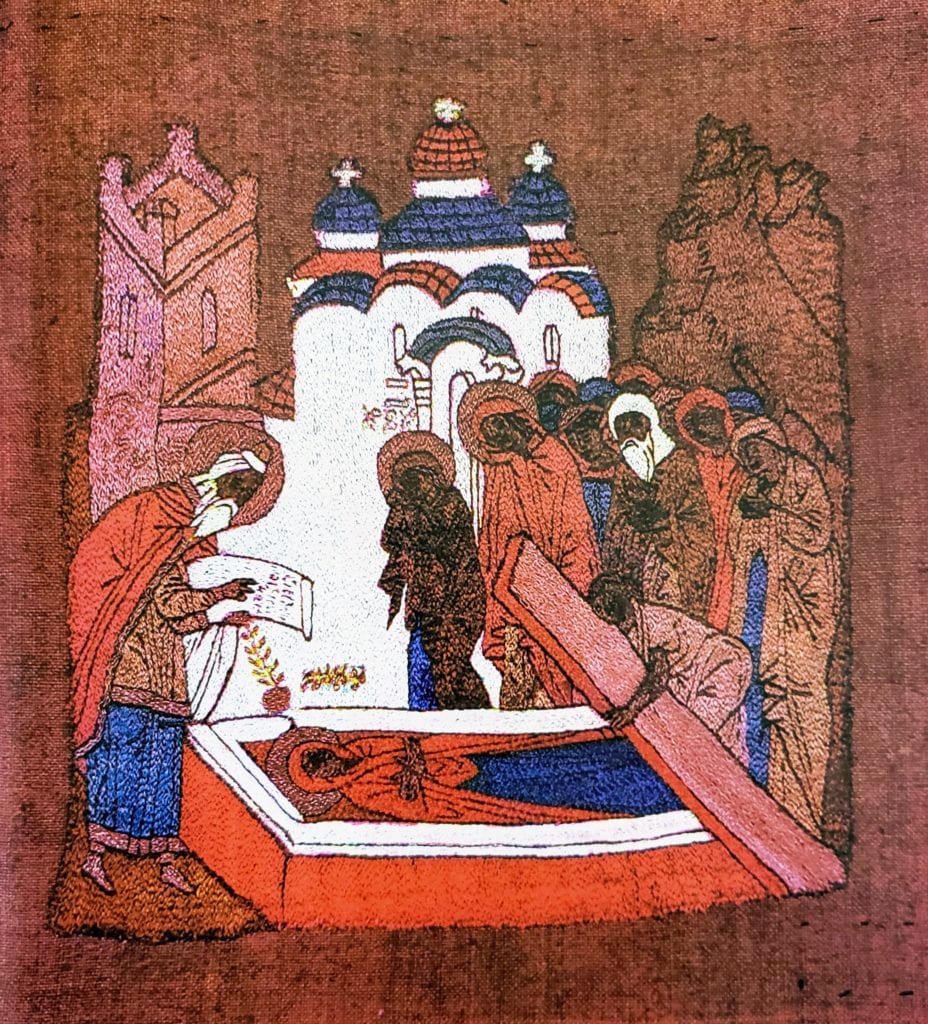
From the Trinity-Sergiev Lavra.
Zagorsk State Historic-Artistic Museum-Reserve (364).
This podea depicts the moment of the final prayer as the cover is placed on the tomb. Behind the tomb and in front of a cathedral, a weeping Holy Virgin stands before a crowd. All are embroidered in multi-colored silk in split stitch. The original ground fabric has not survived. The image has been transferred onto a brown homespun fabric. The flesh-colored silk for the hands and faces has darkened, and in places, disintegrated.
- Istorija russkogo iskusstva. Vol III. Moscow, 1955, pp. 204.
- Svirin, A.N. Drevnerusskoe shit’jo. Moscow, 1963, pp. 46, 49.
- Majasova, N.A. “Khudozhestvennoe shit’jo.” Troitse-Sergieva Lavra. Khudozhestvennye pamjatniki. Moscow, 1968, pp. 120, illus. 131.
- Nikolaeva, T.V. Sobranie drevnerusskogo iskusstva v Zagorskom muzee. Leningrad, (no date), illus. 63.
Illustration 17: Deësis Row

From the Trinity-Sergiev Lavra.
State Tretyakovskaya Gallery.
In the center, the Savior sits in prayer; on either side are: left – the Holy Mother, the Archangel Michael, and the Apostles Peter and John the Theologian; right – John the Baptist, the Archangel Gabriel, the Apostle Paul, and Euthymius the Great. The figures, the arches, and the flowers above them are worked in silk of various colors in split stitch on a crimson taffeta. The halos and various details are worked in wrapped gold thread with inconspicuous couching stitches. The lower part of the figures and the borders have not survived.
- Svirin, A.N. Pamjatnik zhivopisnogo stilja («chin») XV v. v Sergievskom Istoriko-khudozhestvennom muzee. Sergiev, 1926.
- Ainalov, D. Geschichte der russischen Monumentalkunst zur Zeit des Grossfürstentums Moskau. Berlin and Leipzig, 1933, p. 117, illus. 66a-b.
- Istorija russkogo iskusstva. Vol II. Moscow, 1954, pp. 273-275, 277.
- Svirin, A.N. Drevnerusskoe shit’jo. Moscow, 1963, pp. 30-33.
- Alpatov, M.W. Tesori dell’ Arte Russa. Milano, 1966, p. 93.
- Majasova, N.A. “Khudozhestvennoe shit’jo.” Troitse-Sergieva Lavra. Khudozhestvennye pamjatniki. Moscow, 1968, pp. 118, illus. 128, 129.
Illustration 18: Archangel Michael
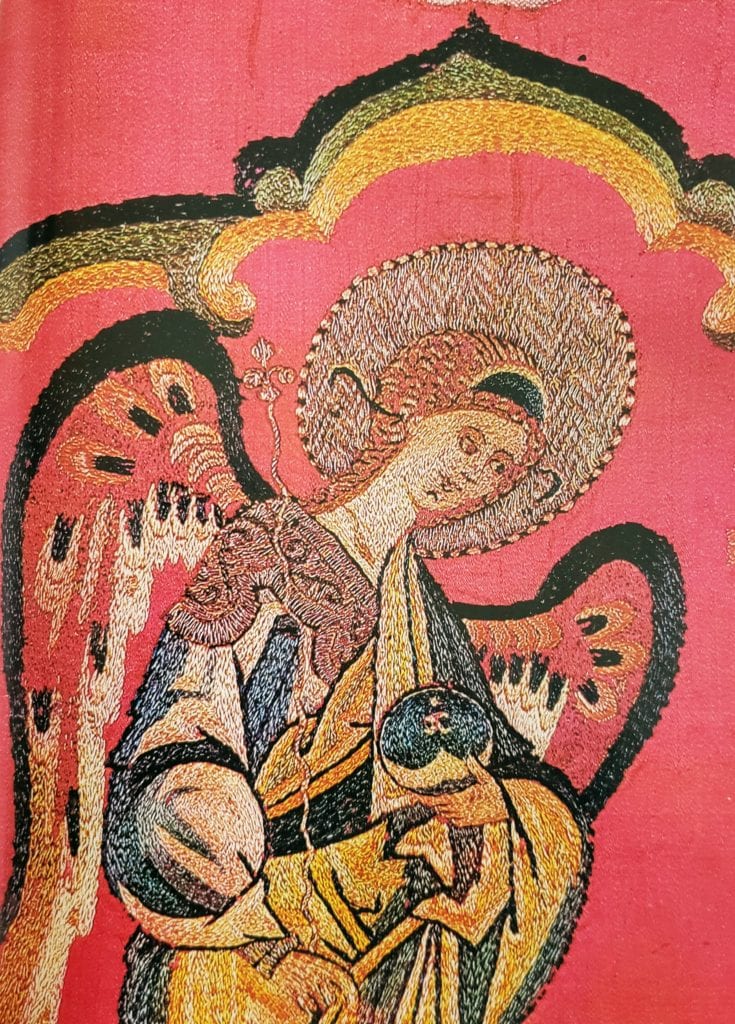
Illustration 19: The Entombment of Christ
Christ, lying in the tomb in the form of a wrapped-up mummy, is mourned by the Holy Mother, Mary Magdalene (with her hands raised upwards), two myrrh-bearers, John the Theologian, Joseph of Arimathea, and Nicodemus (with a ladder). On the side border are two archangels, with six seraphim above and below. The figures, embroidered in brightly colored silk in stem stitch, have been removed from their original ground (a crimson silk in the center, and a green silk on the border) and transferred to a new white linen.
Illustration 20: Archangel Michael
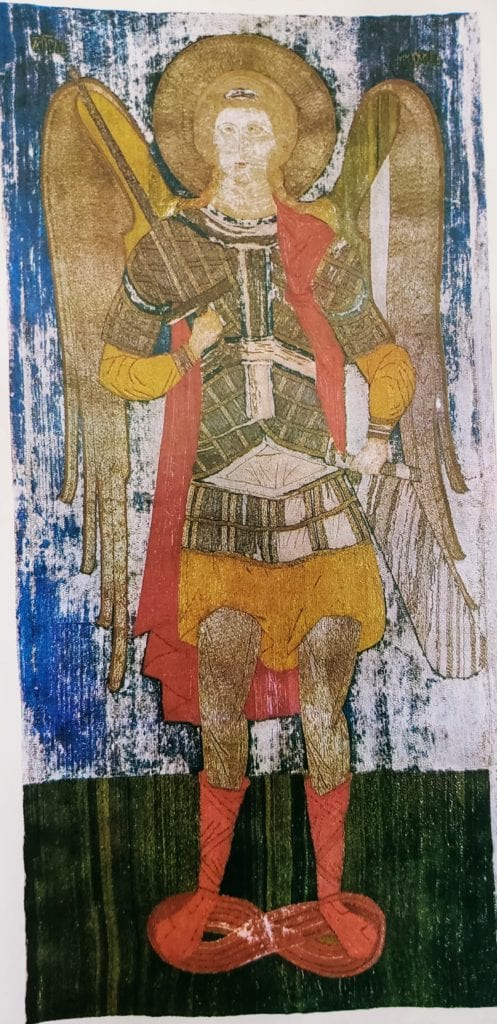
From the Alexander-Svirsky Monastery.
State Russian Museum (196).
This depiction of the archangel, standing and holding a sword and an unfurled scroll, is embroidered on white linen in various colors of silk in split stitch, and wrapped gold thread held down by inconspicuous couching stitches. The outlines of the figure are worked in gold thread. The ground is almost completely covered in dark blue silk. The embroidery on the face and in many spots is heavily worn away.
- Istorija russkogo iskusstva. Vol III. Moscow, 1955, p. 193.
- Lebedeva, Ju.A. Katalog drevnerusskogo shit’ja sobranija Gosudarstvennogo Russkogo muzeja. (manuscript, 1957)
Illustration 21: Peter the Apostle
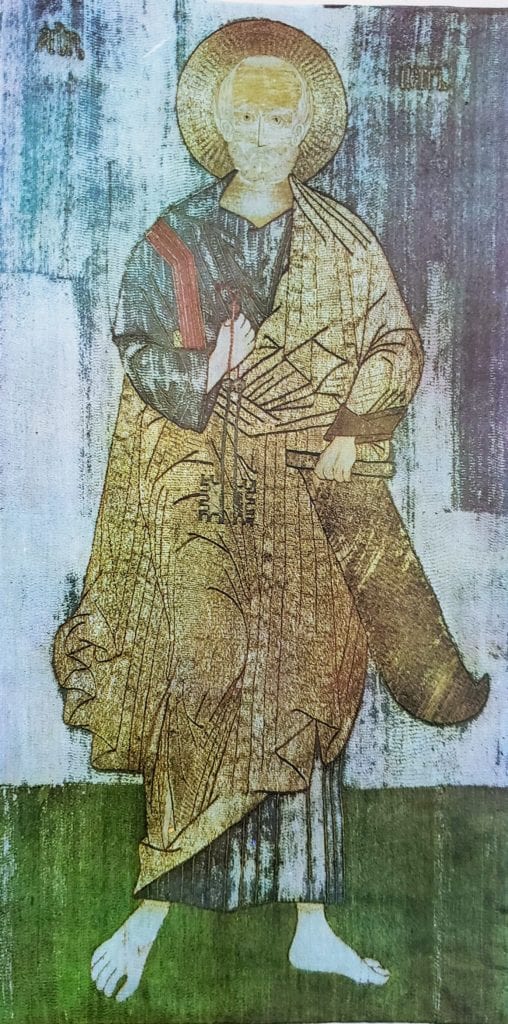
From the Alexander-Svirsky Monastery.
State Russian Museum (264).
This depiction of Peter, standing and holding a key and an unfurled scroll, is embroidered on white linen in various colors of silk in split stitch, and wrapped gold thread held down by inconspicuous couching stitches. The outlines of the figure are worked in gold thread. The ground is almost completely covered in dark blue silk. The embroidery on the face and in many spots is heavily worn away.
- Istorija russkogo iskusstva. Vol III. Moscow, 1955, p. 198.
- Lebedeva, Ju.A. Katalog drevnerusskogo shit’ja sobranija Gosudarstvennogo Russkogo muzeja. (manuscript, 1957)
Illustration 22: St. Catherine the Martyr with Scenes of Her Life

From the Khutyn Monastery.
Novgorod Historic-Artistic Museum-Reserve (2098).
In the center is depicted the martyr Catherine, holding an unfurled scroll. To the right, her young executioner removes his sword from its sheath. To the left, several people kneel in prayer with their backs turned toward her. In a segment of sky above them is Jesus Christ, holding a scroll. The border depicts 12 scenes from Catherine’s life. From the top, left to right:
- The Denunciation of the Pagans
- The Denunciation of the Tsar
- The Appearance of the Archangel to Catherine
- Arguing Faith with the Philosophers
- Their Conversion to Christianity
- The Beating of Catherine
- The Tsaritsa and Warlord’s Conversion to Christianity
- The Appearance of Christ and the Angels to Catherine
- Catherine Before the Tsar
- Catherine is Taken to the Wheel
- Catherine’s Rescue by the Angel
- The Beheading of Catherine
The podea is embroidered in silk of various colors; the halos, inscriptions and details of clothing are worked in wrapped gold and silver thread. The ground of brown fabric has been covered in brown silk stitches. The fabric and embroidery have worn away in many locations.
Illustration 23: The Beheading of St. Catherine

Illustration 24: The Eucharist, with Scenes of the Lives of Joachim, Anne and the Mother of God

From the Cathedral of the Dormition of the Virgin in Pereyaslavl-Ryazan’.
Ryazan’ Regional Museum of Local Lore (3495).
The content and order of images in this are the same as on the 1410-1413 Aër by Ogrofena Konstantinova from Suzdal’ (illus. 10), except for the third scene from the left on the bottom border, where instead of “the Caress,” this item depicts “Bathing the Infant.” The images are embroidered in split stitch using silk of various colors. Christ’s robes, the halos, altars, inscriptions, outlines, folds of clothing, and other details are worked in wrapped gold and silver threads. The background of crimson (center) and light-blue (border) taffeta has survived only in fragments, and a new light-blue homespun ground is now visible. A donor inscription runs around the center: “In the year 6993, in the 3rd indiction, this Aër was created in the Cathedral of the Dormition of the Holy Mother of God in the city of Pereyaslavl-Ryazan’, by the order of the noble and faithful and Christ-loving Grand Prince Anna, during the reign of her noble and faithful and Christ-loving Grand Prince of Ryazan’ Ivan Vasil’evich and of Archbishop Simeon of Ryazan’ and Murom, completed in the year 94 on the 30th of the month of September, in memory of St. Gregory the Illuminator of Armenia.”
- Mentsov, N. “Vozdukh XV veka.” Zhurnal Ministerstva narodnogo prosveschenija. 1838 (Oct.), pp. 236-238.
- Schepkin, V.N. “Pamjatnik zolotnogo shit’ja nachala XV v.” Drevnosti. Trudy IMAO. Vol. 15, Issues 1-2, Moscow, 1894, pp. 35-68.
Illustration 25: The Conception of the Mother of God
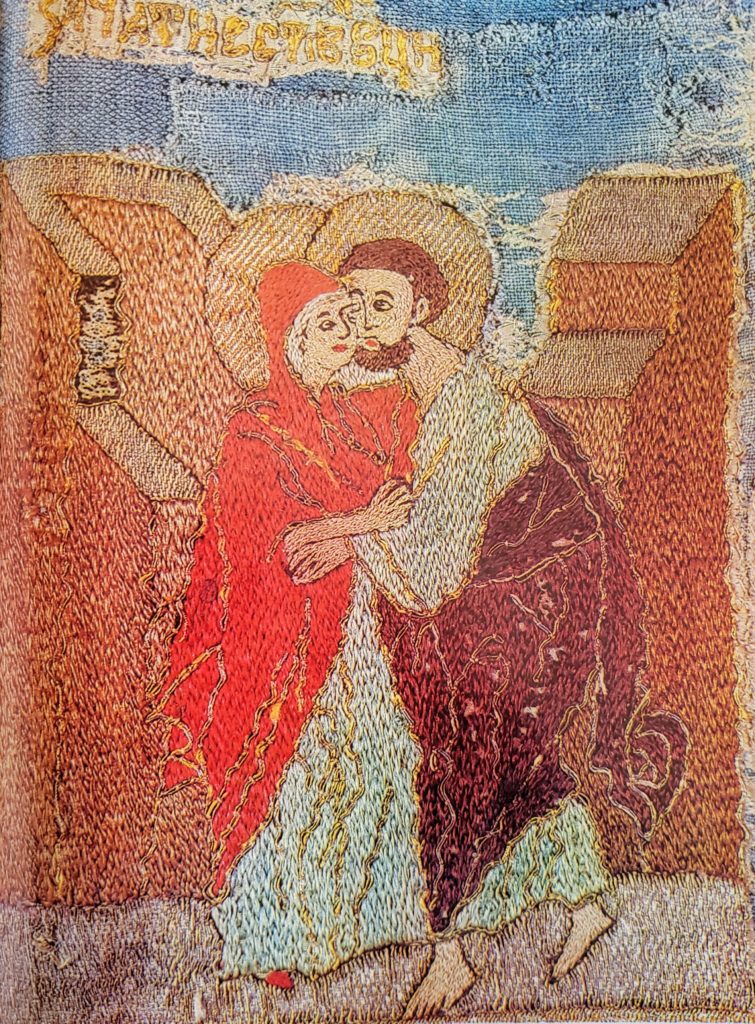
Illustration 26: Our Lady of Smolensk
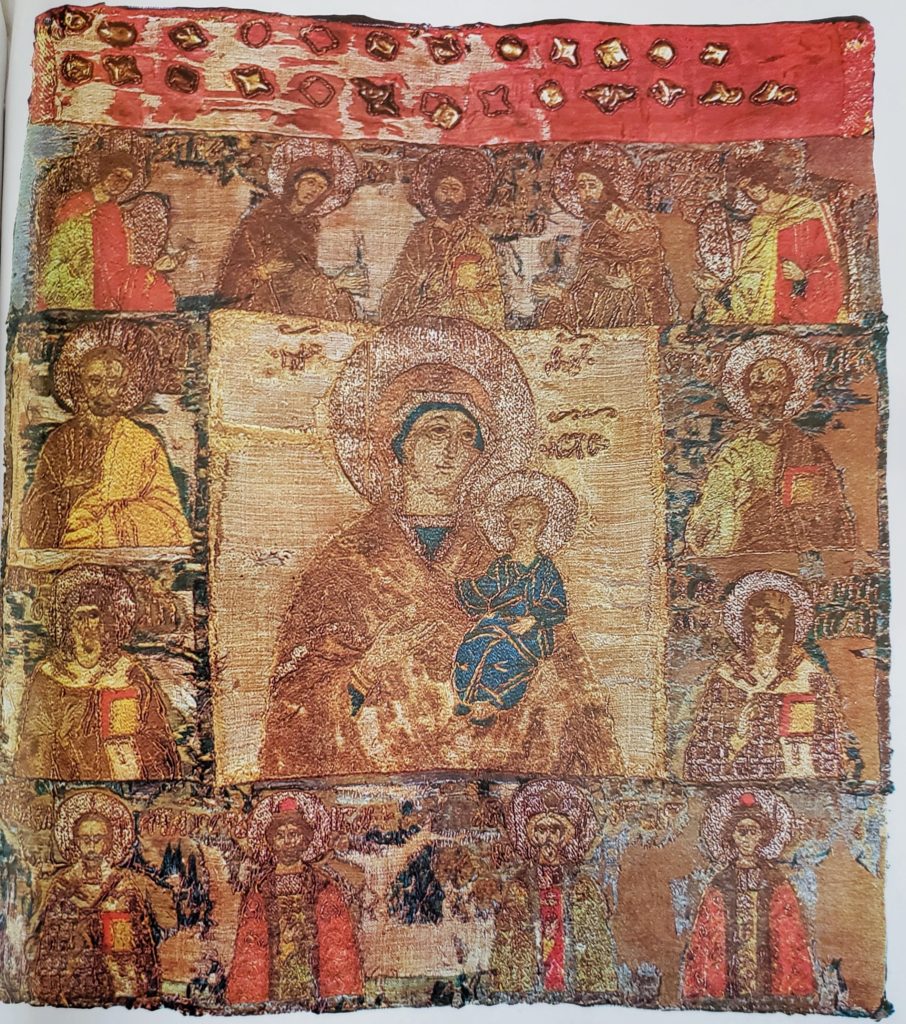
From the Moscow Novospasskij Monastery(?).
State Museums of the Moscow Kremlin (12662op)
A number of half-length figures are embroidered on the border around the image of the Mother of God. Top – the Archangel Michael, the Holy Mother, the Savior, John the Baptist, and the Archangel Gabriel; left – the Apostle Peter and Metropolitan Peter; right – the Apostle Paul and Metropolitan Aleksej; bottom – John Chrysostom, and Princes Boris, Vladimir and Gleb. The figures are embroidered in multi-colored silk in stem stitch. Halos, the outlines of the figures, folds of clothing, and inscriptions are in wrapped gold thread. The embroidery and the ground fabric (in the center, a sand-colored damask, on the borders, dark-blue) are worn away in many places. A band of scarlet taffeta with appliques of gilt copper has been affixed to the top.
Illustration 27: Liturgical Procession

From the collection of P.I. Shukin.
State Historical Museum (5rb).
The central section depicts a church procession on Palm Sunday. In the center, a deacon carries an icon of “The Virgin Hodegetria” in the Smolensk style. A crowd approaches it from both sides. On either side of the icon there are two monks holding a cross and a water bowl, and behind them, some holding censers. In the back row, worshippers carry two large shade umbrellas and long willow branches. In the middle row, on the left, Grand Prince Ivan III with a halo and crown is depicted; with him is Ivan’s grandson Dmitrij (with a halo and with his arms crossed over his chest) and Ivan’s son Vasilij (with a crown but no halo). Across from him, on the right, are a number of bishops, with Metropolitan Simon in front. In the front row on both sides are a number of priests, monks, and singers in pointed hats. Behind them on the left stands Grand Princess Sofia with a “tamboline” on her shoulder, her two unmarried daughters Feodora and Evdokija, and between them, the Grand Prince’s daughter in law, Elena Stefanovna. The figures and the ornamentation on the borders is embroidered in multi-colored silks in alternating couching stitches [“dvojnoj slozhnij shov”] and wrapped gold thread. The faces are done in stem stitch in flesh-colored silk. The ground fabric, a sand-colored taffeta, is almost completely covered in gold thread.
- Trudy VIII Arkheologicheskogo s”ezda v Moskve v 1890 g. Vol. IV. Moscow, 1897, illustration XXII.
- Schepkina, M.V. “Izobrazhenie russkikh istoricheskikh lits v shit’je XV veka.” Trudy GIM, issue XII. Moscow, 1954.
- Svirin, A.N. Drevnerusskoe shit’jo. Moscow, 1963, pp. 52-57.
Illustration 28: The Beheading of John the Baptist
This image and the ornament on the border is worked in alternating couching stitches in silk of various colors and wrapped gold thread. The faces are worked in stem stitch with flesh-colored silk, and the hair in brown. The ground, a sand-colored taffeta, is almost completely covered in gold.
- Schekotov, N.M. “Drevnerusskoe shit’jo.” Sofija. 1914(1), p. 26.
- Schepkina, M.V. “Izobrazhenie russkikh istoricheskikh lits v shit’je XV veka.” Trudy GIM, issue XII. Moscow, 1954, pp. 15-20.
Illustration 29: Holidays and Saints

From the Trinity-Sergiev Lavra.
Zagorsk State Historic-Artistic Museum-Reserve (413).
The center of this podea is a later yellow silk with the Cross of Golgotha in gold braid; on the border are embroidered various holidays and saints. Top center – the Trinity; top left – John Chrysostom and the Holy Mother; top right – John the Baptist and the Apostle Timothy. Left border – the Annunciation and the Ascension. Right border – the Heavenly Father and Son, and the Descent of the Holy Spirit Upon the Apostles. Bottom center – the Appearance of the Holy Mother to St. Sergius; bottom left – Metropolitans Peter and Aleksej; bottom right – the Archangel Gabriel and Basil of Parium. In the corners are cherubim and seraphim. The figures are embroidered in silk split stitches of various colors and tones. Above the main embroidery for the architecture, landscape and clothing, small dots of various colors have been added. The halos, cherubim and inscriptions are embroidered in wrapped gold thread. In the lower field, there is a donor inscription in two columns: “In the year 7007, this podea was created during the reign of the faithful Ivan Vasil’evich, Grand Prince of All Rus’, and his son Grand Prince Vasilij Ivanovich, and Archbishop Metropolitan Simon, conceived and ordered by the Byzantine Grand Princess of Moscow Sofia, wife of the Grand Prince of Moscow, who donated this podea in prayer to the Life-Giving Trinity and to Sergej the Miracle-Worker.” The original ground fabric, a blue damask, has survived only in fragments. A newer canvas is visible.
- Georgievskij, V.T. “Drevnerusskoe shit’jo v riznitse Troitse-Sergievoj lavry.” Svetil’nik. 1914(11-12), pp. 11, 13-14.
- Schepkina, M.V. “Izobrazhenie russkikh istoricheskikh lits v shit’je XV veka.” Trudy GIM, issue XII. Moscow, 1954, pp. 8-12.
- Svirin, A.N. Drevnerusskoe shit’jo. Moscow, 1963, pp. 57-61.
- Majasova, N.A. “Khudozhestvennoe shit’jo.” Troitse-Sergieva Lavra. Khudozhestvennye pamjatniki. Moscow, 1968, pp. 122-123, illus. 138-141.
- Nikolaeva, T.V. Sobranie drevnerusskogo iskusstva v Zagorskom muzee. Leningrad, (no date), illus. 59, 60.
Illustration 30: The Archangel Gabriel and St. Basil of Parium
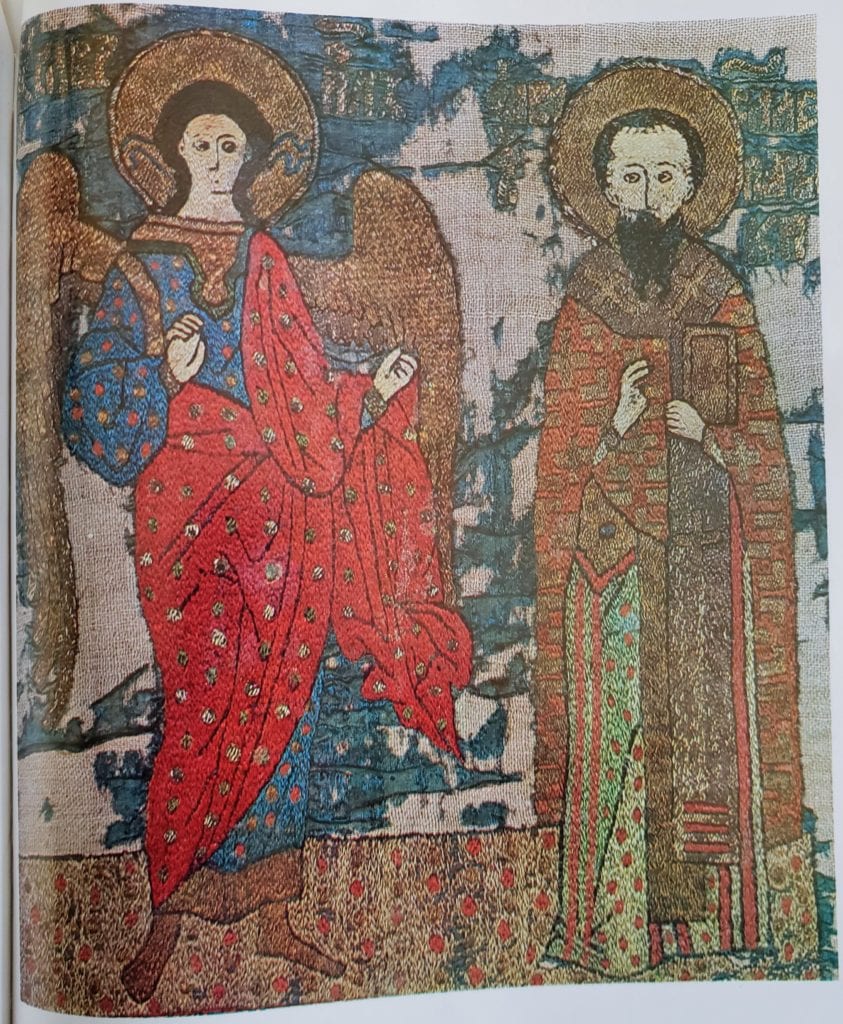
Illustration 31: The Descent of the Holy Spirit Upon the Apostles
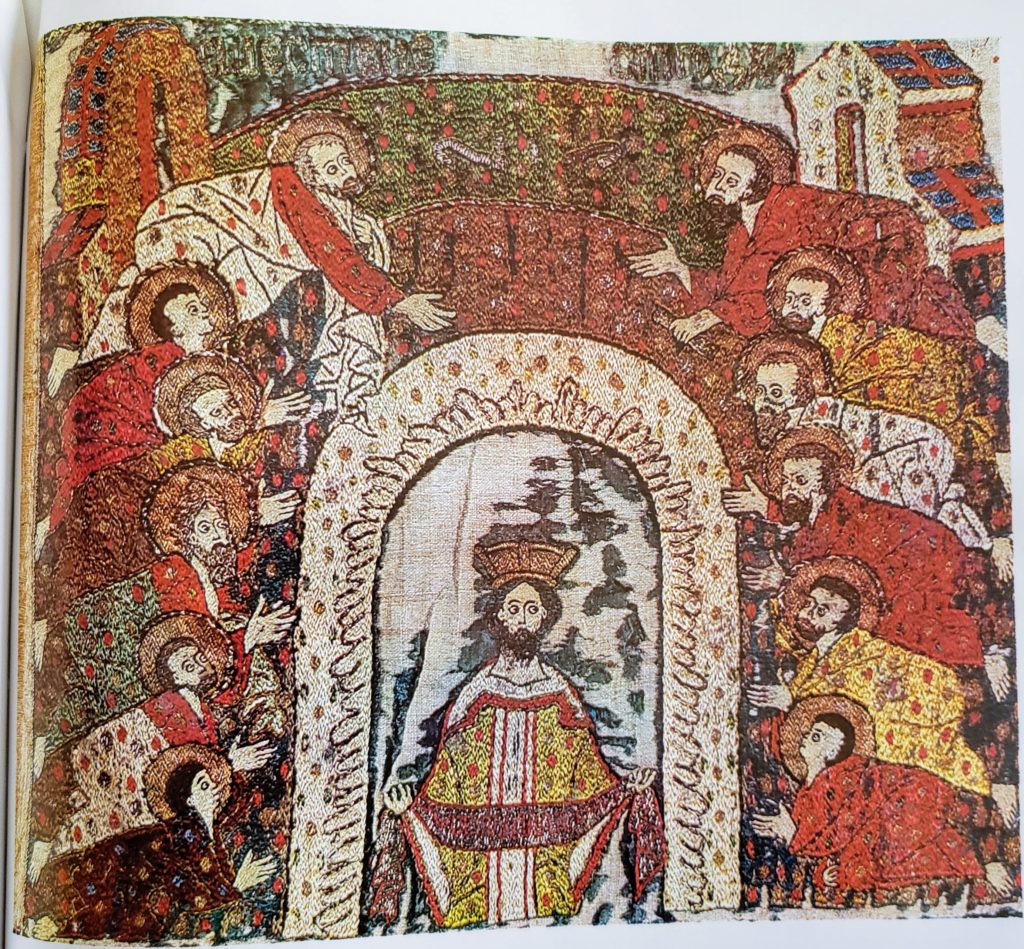
Illustration 32: St. Nicholas

From the Trinity-Sergiev Lavra.
Zagorsk State Historic-Artistic Museum-Reserve (668).
St. Nicholas is depicted on this podea, embroidered in silk of various colors on a cranberry-colored taffeta, holding the Gospel and raising one hand in benediction. On either side of his head in two round frames are the half-length figures of Christ, who holds out a Gospel toward Nicholas, and the Holy Mother, who holds an omophorion. The haloes, crosses and other details are embroidered in gold. A liturgical inscription runs around the border.
- Istorija russkogo iskusstva. Vol III. Moscow, 1955, p. 532, illus. on page 529.
- Majasova, N.A. “Khudozhestvennoe shit’jo.” Troitse-Sergieva Lavra. Khudozhestvennye pamjatniki. Moscow, 1968, p. 124, illus. 146, 147.
- Nikolaeva, T.V. Sobranie drevnerusskogo iskusstva v Zagorskom muzee. Leningrad, (no date), illus. 64.
Illustration 33: The Dormition of the Virgin

From the Cathedral of the Dormition, Ryazan’.
Ryazan’ Regional Museum of Local Lore (3496).
This podea depicts the so-called “Cloudy Dormition,” with the Holy Mother ascending to Heaven on a throne. Above, two angels are ready to receive her at the open gates of Heaven. Amongst the apostles are four saints: Dionysius the Areopagite, John Chrysostom, Jacob the brother of Christ, and Hierotheos the Thesmothete(?). In front of the bier, an angel cuts off the hands of Avfonia, who attempts to overturn the bed. The figures are embroidered in silks of multiple colors in split stitch. The faces are embroidered in various shades of tan silk. Christ’s robes, the haloes, and various other details are in wrapped gold. The Holy Mother’s clothing and her “soul” are in wrapped silver thread. The ground of light blue homespun is almost completely covered in crimson silk.
Illustration 34: The Birth of the Holy Mother

From Volokolamsk’s Cathedral of the Resurrection.
State Tretyakovskaya Gallery (20930).
The center depicts “The Nativity of the Virgin”, with Anne sitting in bed and ladies walking toward her bearing vessels. Behind her, Joachim stands in a ciborium. In the lower right, there are scenes of bathing and rocking the infant. The border depicts 16 scenes from the lives of Anne, Joachim and Mary; from the top, left to right:
- The Presentation of Gifts
- The Rejection of the Gifts
- Joachim’s Exile to the Desert
- The Annunciation to Anne
- The Conception
- Joachim is Blessed by the Priests
- The Caress of Mary
- The First Steps
- The Presentation at the Temple
- The Prayer for the Rods
- The Presentation of Mary to Joseph
- The Annunciation at the Well
- Testing the Water
- The “Mortal” Annunciation
- The Holy Mother’s Prayer in the Desert
- The Israeli Wives Before the Holy Mother’s Bed
A donor inscription runs around the center section: “In the year 7019, on the 24th of the month of October, this podea was created at the Church of the Three-Day Resurrection of Christ, in praise of the most pure Holy Virgin in the blessed city, during the reign of Vasilij Ivanovich, Grand Prince of all Rus’, and of the blessed Simon Metropolitan of all Rus’, as ordered by our faithful, God-loving prince Feodor Borisovich and his faithful princess Anna, and the Grand Prince’s grandson Vasilij Vasilievich, and his grandson Vasilij Dmitrievich and brother of Ivan, and by the holy grace of the lord Prince of All Rus’ to the holy martyr St. Aref.” The ground of the podea is light blue taffeta sewn in the center section in gold, and on the border in silver. The figures are embroidered in silk of various colors, in alternating couching stitches, with various details in gold and silver. The faces are in flesh-colored silk in large split stitches, running in a single direction.
- Katalog khudozhestvennykh proizvedenij, nakhodjaschikhsja v ekspozitsii Tret’jakovskoj galerei. Moscow, 1947, p. 28.
- Svirin, A.N. Drevnerusskoe shit’jo. Moscow, 1963, pp. 65-67.
- Nikolaeva, T.V. “O nekotorykh volodolamskikh drevnostjakh.” Khudozhestvennaja kul’tura Moskvy i rilezhaschikh k nej knjazhestv XIV-XVI vv. Moscow, 1970, pp. 370-376.
Illustration 35: The Evangelism to Joachim in the Desert

Illustration 36: The First Steps of the Mother of God
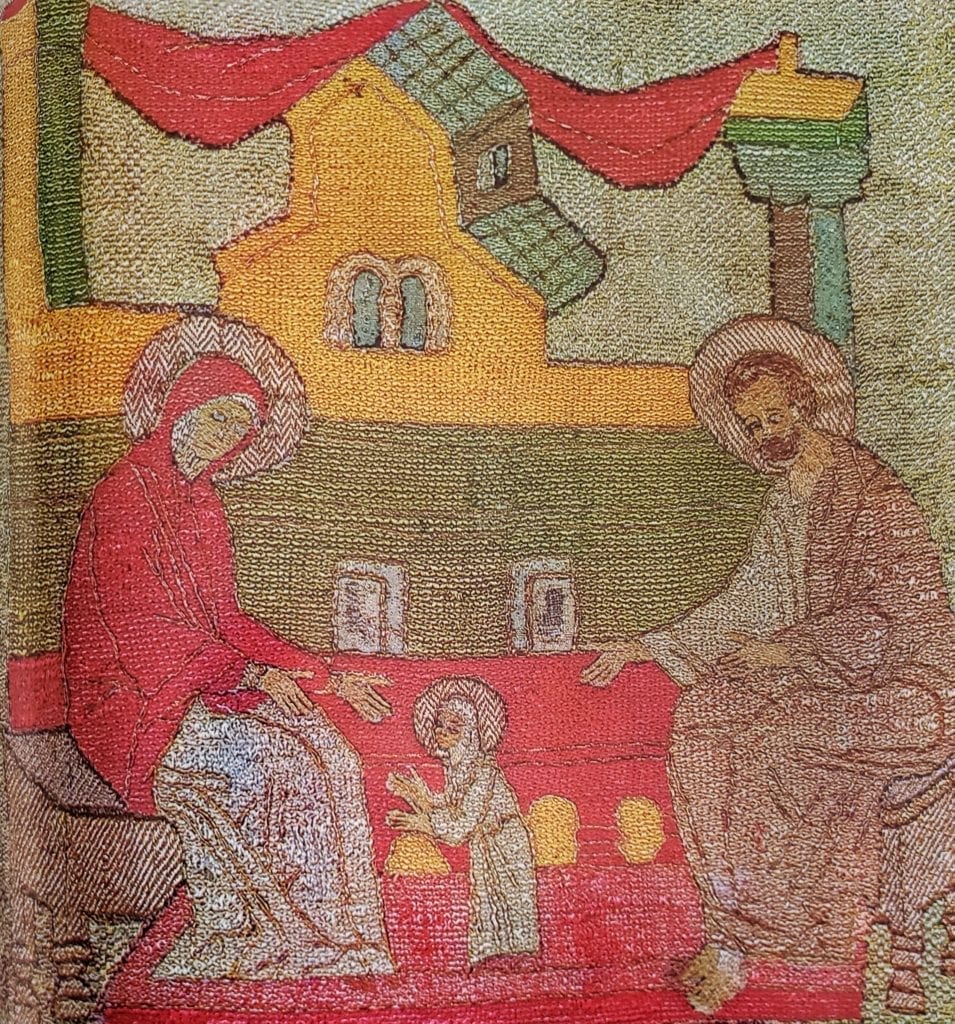
Illustration 37: The Crucifixion

From the Trinity-Sergiev Lavra.
Zagorsk State Historic-Artistic Museum-Reserve (414).
Christ is shown crucified on Mt. Golgotha, surrounded by: left – the Mother of God and one of the myrrh-bearers; right – John the Baptist and the centurion Longinus. The image is embroidered on (faded) rose-colored satin in various colors of silk. Halos, inscriptions, folds of clothing, and other details are in wrapped gold thread. In the lower corners, an inscription is sewn in two circles: “Painted by the master artisan of Prince Andrej Myvedon (or Mydevon), Annka Grigoriev Kuveka.” On the border of dark blue satin, between two ornamental bands, is the following donor inscription: “In the year 7022, during the rule of Grand Prince Vasilij Ivanovich, Lord and Tsar of all Rus’, as ordered by Metropolitan Varlaam, Ivan’s wife Zakharicha Ivanova Nastasija donated this veil to the house of the Life-Giving Trinity and of St. Sergius the Miracle-Worker, for her husband’s soul, and for her own, and for her children, and Our Lord Jesus Christ, teach me to serve at Your holy altar, and thanks to god, let them remember the souls of Ivan’s Zakharicha and her children and Nastasija the sinner.”
- Olsuf’ev, Ju.A. Kto vkladchiki vozdukha no. 1479 i pokrova no. 1541 v Muzee byvsh. Troitse-Sergievoj lavry. Sergiev, 1924.
- Majasova, N.A. “Khudozhestvennoe shit’jo.” Troitse-Sergieva Lavra. Khudozhestvennye pamjatniki. Moscow, 1968, pp. 123-124, illus. 142.
Illustration 38: The Appearance of the Mother of God to St. Sergius, with Holidays and Saints

From the Trinity-Sergiev Lavra.
Zagorsk State Historical-Artistic Museum-Reserve (409).
The center depicts the Appearance of the Mother of God and the Apostles John and Peter to St. Sergius of Radonezh and his apprentice Mikhej (a later incorrect inscription says “Nikon”). The border depicts various saints and holidays: top – the Annunciation, St. John Chrysostom, Our Lady of God with Metropolitan Peter praying to her, the Old Testament Trinity, John the Baptist, the Archangel Gabriel, and the Nativity of Christ; left – the Baptism, and the Heavenly Father and Son; right – the Ascension, and the Descent of the Holy Spirit Upon the Apostles; bottom – the Nativity and Conception of the Mother of God, Metropolitans Peter and Aleksej praying to the Savior surrounded by the Seven Maccabean Brothers, their teacher Eleozar and mother Solomonia, Basil of Parium, and Leontij of Rostov, and finally (bottom right) the Conception and Birth of John the Baptist. At the bottom of the middle section, on either side of Mt. Golgotha, an inscription is embroidered in pearls: “Lord Have Mercy upon the faithful Grand Prince Vasilij Ivanovich, Lord of all Rus’, and upon his faithful Grand Princess Solomonia and upon their cities, and give unto them fruit of the belly, this podea created in the year 7033 in the 19th year of his reign.” All figures are embroidered in various colors of silk, with halos and various other figures in gold. The original ground fabric (a cherry damask in the center, dark blue on the border) is visible only in places where the embroidery has worn away. A new dark-red velvet now serves as the ground. The pearl work is later.
- Georgievskij, V.T. “Drevnerusskoe shit’jo v riznitse Troitse-Sergievoj lavry.” Svetil’nik. 1914(11-12), pp. 11-12, illus. V.
- Istorija russkogo iskusstva. Vol III. Moscow, 1955, p. 677.
- Svirin, A.N. Drevnerusskoe shit’jo. Moscow, 1963, pp. 68-69.
- Majasova, N.A. “Khudozhestvennoe shit’jo.” Troitse-Sergieva Lavra. Khudozhestvennye pamjatniki. Moscow, 1968, pp. 125-126, illus. 150-151.
- Nikolaeva, T.V. Sobranie drevnerusskogo iskusstva v Zagorskom muzee. Leningrad, (no date), illus. 68.
Illustration 39: The Ascension
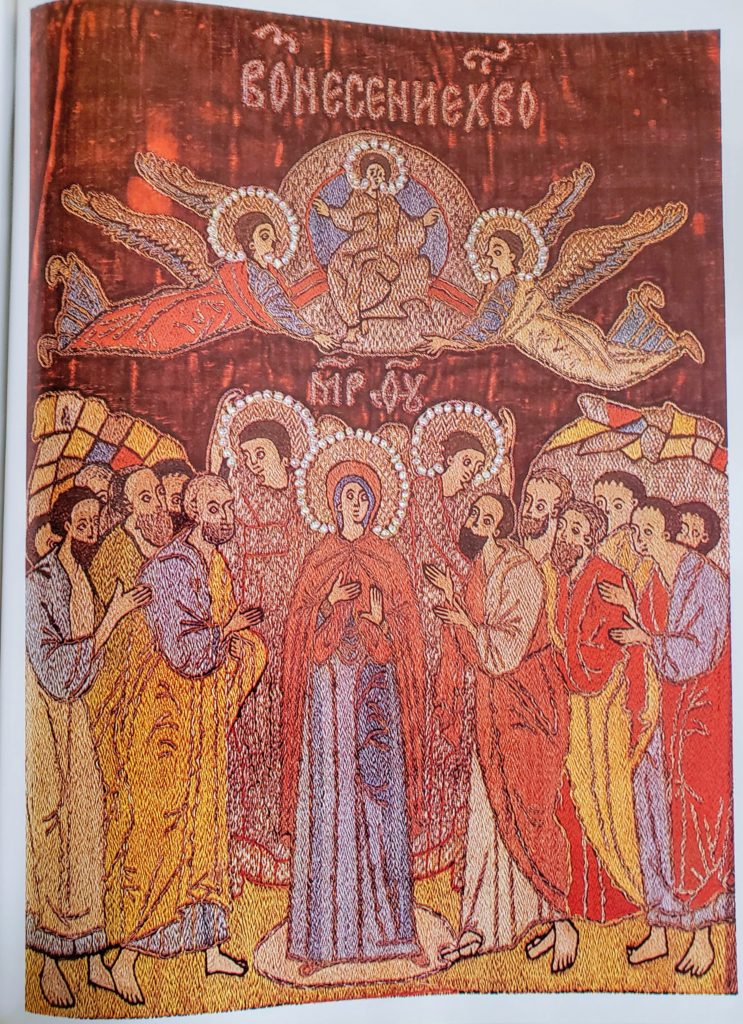
Illustration 40: Cyril of Belozersk, with Scenes of His Life

From the Kirillo-Belozerskij Monastery.
State Russian Museum (276).
The center depicts St. Cyril of Belozersk standing with a scroll, embroidered on a sand-colored damask. The violet damask border has 23 scenes of his life. From the top left, to right:
- The Birth of Cyril
- The Tonsuring
- Cyril’s Conversation with Sergius of Radonezh
- Supplying the Humens
- Cyril’s Vision of the Holy Mother
- Consecrating the Location of the Monastery
- The Conviction of Andrej, who tried to set fire to the cell
- Cyril Blesses the Church and Masters
- Cyril Extinguishes a Fire by Prayer
- Cyril Arrives in Obedience to the Elder
- Receiving Gifts from the Ambassadors of Prince Mikhail Belevskij
- Cyril Appears to the Prince in a Dream
- Driving a Demon from the Sick
- The Priest’s Complaint About the Lack of Wine
- Filling the Vessels with Wine
- Filling the Meal with Brush
- Rescuing the Fishermen from the Flood
- The Resurrection of the Deceased Monk
- Healing Boyar Roman
- Healing the Blind
- Cyril’s Speech to the Brothers About the Construction of the Monastery
- The Death of Cyril
- Cyril’s Appearance to the Elder.
The podea is embroidered in split stitch in multi-color silk, with the halos and other details in wrapped gold thread; the inscription is in silver.
- Schekotov, N.M. “Drevnerusskoe shit’jo.” Sofija. 1914(1), p. 19.
- Lebedeva, Ju.A. Katalog drevnerusskogo shit’ja sobranija Gosudarstvennogo Russkogo muzeja. (manuscript, 1957)
Illustration 41: Selected Saints

From the Kirillo-Belozersky Monastery.
State Historical Museum (4rb).
The center section of green brocade is embroidered with St. Nicholas and Metropolitans Peter and Aleksej. The border of “tausine” (light grey) taffeta depicts three rows of saints: Metropolitan Theognost and Basil of Parium, Gregory the Theologian, Basil of Caesarea and John Chrysostom, and Metropolitans Iona and Filipp. On the sides: Leontij of Rostov and Cyril (of Alexandria?), and Dmitrij Prilutskij and Nicetas Stylites. Bottom: Sergius and Nikon of Radonezh, Euphemius of Suzdal’, Cyril of Belozersk, Varlaam of Khutyn, Savva Visherskij, and Pafnutij of Borovsk. The figures are embroidered in silk, haloes and inscriptions in gold. Around the border of the podea, there is a band of red brocade with a liturgical inscription. The fabric of the border survives only in fragments.
- Schekotov, N.M. “Drevnerusskoe shit’jo.” Sofija. 1914(1), p. 26, illus. on p. 20.
Illustration 42: St. Nicholas of Mozhajsk

From the Resurrection Monastery of the Moscow Kremlin.
State Museums of the Moscow Kremlin (12311op)
This image of St. Nicholas, holding a sword in his right hand and a “city” in his left, is embroidered in thick silk in a couched stitch. His halo and details of his clothing are embroidered in wrapped gold thread. His face and hands are worked in split stitch of flesh colored silk, with tiny stitches following the form of the design; his hair and beard are in several shades of grey silk. The contours of the figure are decorated with a later silver perl. The image and name inscriptions have been removed from their original ground, a crimson brocade, and transferred to a taffeta of the same color. The border has a liturgical inscription, embroidered in flesh-colored silk on the original ground fabric. In the lower left corner, there is a patch of yellow brocade with embroidered decoration.
Illustration 43: St. Nicetas the Stylite of Pereslavl

From the Nicetas Monastery in Pereslavl’-Zalessky.
Vladimir-Suzdal’ Historic-Artistic and Architectural Museum-Reserve (2155)
St. Nicetas of Pereslavl is depicted with a scroll in his hand, in couched silk on a light-blue damask. The face and hands are in stem stitch. The halo, with its floral relief design, is embroidered in gold thread. Around the border, there are liturgical inscriptions in silver thread.
- Georgievskij, V.T. Kratkoe opisanie tserkovno-istoricheskogo drevlekhranilischa Bratstva velikogo knjazja Aleksandra Nevskogo vo Vladimirskoj gubernii Vjazniki. 1895, p. 36.
- VI Vystavka proizvedenij izobrazitel’nogo iskusstva restavrirovannykh GTsKhRM im. akad. I.E. Grabarja. Katalog. Moscow, 1969, p. 132.
Illustration 44: The Entombment

From the Trinity-Sergiev Lavra.
Zagorsk State Historic-Artistic Museum-Reserve (408).
The center section is embroidered with a multi-figure composition of the Lamentation of Christ. At the head of the tomb are the Holy Mother and two myrrh-bearers; at the foot are the Apostles John and Nicodemus, and Joseph of Arimathea. Two angels stand in the rear and in front of the tomb, holding liturgical fans. In the lower right corner there is a tiny figure of St. Sergius of Radonezh. Above, in a segment of the sky, the masks of the sun and moon are shown, along with the Holy Spirit in the form of a dove. The four corners of the center section have the symbols of the Evangelists. On the border, between the letters of a liturgical inscription, there are round frames depicting: corners – the Evangelists; top – the Trinity, and the Archangels Michael and Gabriel; left – John Chrysostom; right – Basil of Caesarea; bottom – Our Lady of the Sign, and the prophets David and Solomon. A blue homespun serves as the ground fabric, against which can be seen fragments of the original ground, a red damask. The ground of the border is a light-blue damask. The faces and bodies are embroidered in thin twisted flesh-colored silk, sewn following the pattern of the design in stem stitch, with shading in a warmer tone of silk. The clouds, the clothing of Mary Magdalene and St. Sergius, and various other details are worked in bright colored silk. The remaining figures are worked in wrapped silver and gold threads which are couched down with thick, colored silk threads, creating various patterns. The halos are embroidered in relief in gold thread. A band of red damask has been attached to the right side with an inscription about the donation of this epitaphios to the Trinity Monastery: “In the year 7069 by grace of the Holy Spirit and the holy and life-giving Trinity and the most pure Mother of God and our merciful venerable Father Sergius, during the reign of our Tsar Ivan Vasilievich Grand Prince of All Rus’ and our predestined Metropolitan Makarij, this veil was created for the house of the holy life-giving Trinity by order of the faithful lord Prince Vladimir Andreevich, grandson of Grand Prince Ivan Vasilievich and great-grandson of Grand Prince Vasilij Vasilievich the Dark, and the order of his faithful mother, Eufrosina, Princess to Prince Andrej Ivanovich, this veil was given in purity and worship to all Orthodox Christians and in memory of the previous generation in eternal memory of our souls, Forever and ever, Amen.”
- Georgievskij, V.T. “Drevnerusskoe shit’jo v riznitse Troitse-Sergievoj lavry.” Svetil’nik. 1914(11-12).
- Aleksandrova-Dol’nik, T.N. “Shit’jo moskovskoj masterskoj XVI v.” Voprosy restavratsii. Vol 1, Moscow, 1926.
- Majasova, N.A. Masterskaja khudozhestvennogo shit’ja knjazej Staritskikh.” Soobschenija Zagorskogo muzeja-zapovednika. Issue 3. Zagorsk, 1960, pp. 51-53.
- Svirin, A.N. Drevnerusskoe shit’jo. Moscow, 1963, pp. 75-82.
- Majasova, N.A. “Khudozhestvennoe shit’jo.” Troitse-Sergieva Lavra. Khudozhestvennye pamjatniki. Moscow, 1968, pp. 127-129, illus. 154, 155.
- Nikolaeva, T.V. Sobranie drevnerusskogo iskusstva v Zagorskom muzee. Leningrad, (no date), illus. 74.
Illustration 45: The Mother of God and the Myrrh-Bearers

Illustration 46: St. John Chrysostom
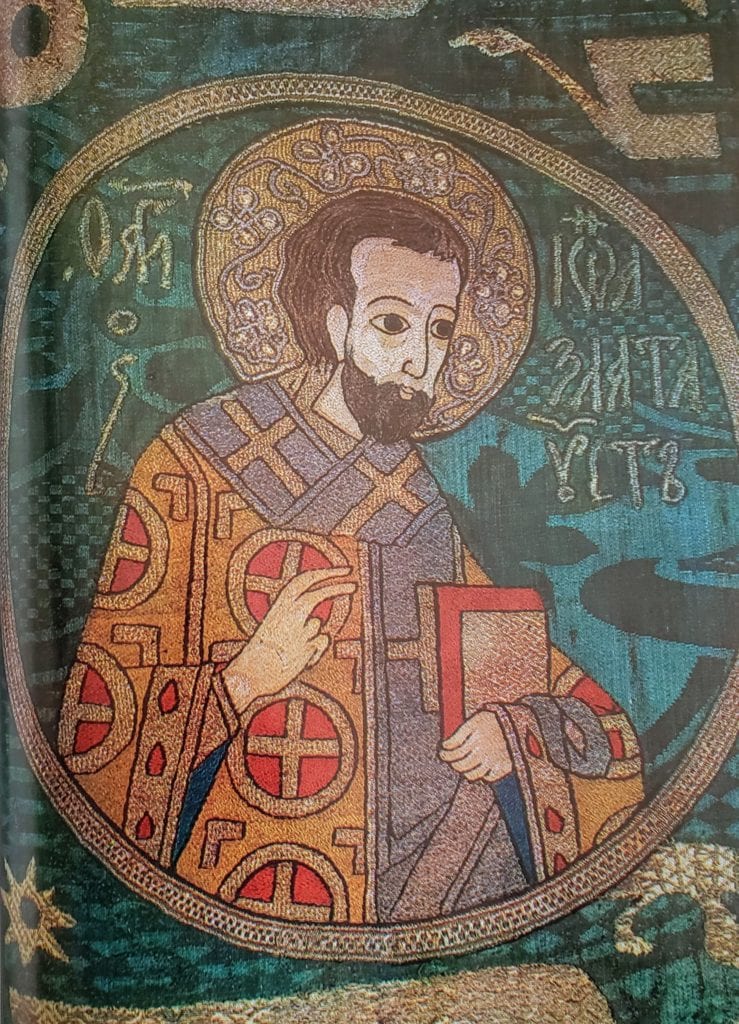
Illustration 47: St. John the Theologian

From the Chudov Monastery in the Moscow Kremlin.
State Museums of the Moscow Kremlin (12468op).
John the Theologian is depicted leaving through a gospel with the opening words of his text. Nearby is his symbol, the winged lion. On the border and on the left side of the center section, there is a liturgical inscription. The hands and face are embroidered in a greyish silk in split and stem stitches. The outline of the face and eyes and his wrinkles are embroidered in the same color of silk, but in the opposite direction. John’s clothing and the lion are embroidered in passing gold with colored silk couching threads. The halos, wings of the lion, folds of the clothing, and inscriptions are in wrapped gold with inconspicuous[150]jeb: The author means here that the couching stitches are of the same color as the gold. couching stitches. The ground is a red satin.
Illustration 48: St. Nikita, Bishop of Novgorod

From the Novgorod St. Sophia Cathedral.
Novgorod Historic-Architectural Museum-Reserve (3662)
This image of Nikita, bishop of Novgorod, was embroidered onto a dark blue silk, which is visible in spots where the embroidery has worn away. During restoration, the embroidery was transferred onto a dark blue homespun. The item is embroidered in various colors of silk and wrapped gold and silver thread with inconspicuous couching.
- Novgorodskij istoriko-arkhitekturnyj muzej-zapovednik. Katalog. Leningrad, 1963, p. 18.
Illustration 49: Metropolitan Aleksej

From the Chudov Monastery in the Moscow Kremlin.
State Museums of the Moscow Kremlin (12426op).
This image of Metropolitan Aleksej was embroidered onto a sand-colored satin. The hands and face are worked in large split stitches, partially following the form of the item. The clothing are worked in twisted silk split stitch, with details in wound gold and silver thread. The outlines of the figure and the inscription are outlined in pearls. Around the edges, there is a liturgical inscription in silver. On the lining of yellow taffeta, there is an inscription in black ink: “In the year 7089 (?) on the first of May this veil was dedicated to Aleksej the Miracle Worker … by Grand Prince Simeon Bekbulatovich of Tver’.”
Illustration 50: John the Baptist, Angel of the Desert

From the Nikolo-Besednyj Monastery near Tikhvin.
Novgorod Historic-Architectural Museum-Reserve (6146).
This image of John the Baptist in the form of an angel, holding an unfurled scroll and a diskos with a eucharistic lamb, is embroidered on a red silk in wrapped gold and silver threads with multi-colored couching stitches. The face, arms and hands are sewn in flesh-colored silk without shading; features and contours are outlined in red silk. The landscape is decorated with trees, one of which has an axe. There is a liturgical inscription on the border, in silver thread on a green silk. The ground fabric has faded and ripped.
Illustration 51: The Trinity, with Scenes from the Bible

From the Hypatian Monastery in Kostroma.
State Museums of the Moscow Kremlin (19085op)
On the center area of crimson damask is embroidered the Old Testament Trinity, around which there is a border of dark blue damask with 16 frames. From the top, left to right:
- The Creation of the Angelic Ranks
- The Creation of the Heavens, Earth and Waters
- Satan’s Expulsion from Heaven
- The Creation of Adam and Eve, and their Temptation by Satan
- Adam and Eve are Banished from Paradise
- Noah Collects The Animals into the Ark
- The Appearance of the Trinity to Abraham
- Washing the Feet of the Angels
- Abraham Throws a Feast for the Angels
- Abraham Asks About the Righteous
- The Angels Travel to Sodom and Gomorrah
- The Destruction of Sodom and Gomorrah, and Lot’s Wife
- Lot and His Daughters are Led Away from Sodom
- The Temptation of Abraham
- Jacob’s Vision of the Ladder
- Moses’ Vision of the Burning Bush
The figures are embroidered in wrapped gold and silver threads with thick couching threads of various colors, creating various patterns. Various details (landscape, trees, animals, et. al.) are in colored silk; in some places, gold gimp thread was used. The faces were densely embroidered in stem stitch with shading in greenish-brown silk. The Angels in the center section, haloes, inscriptions and framework are outlined in pearls.
- Svirin, A.N. Drevnerusskoe shit’jo. Moscow, 1963, pp. 109-111.
Illustration 52: The Creation of Adam and Eve, and Their Temptation by Satan
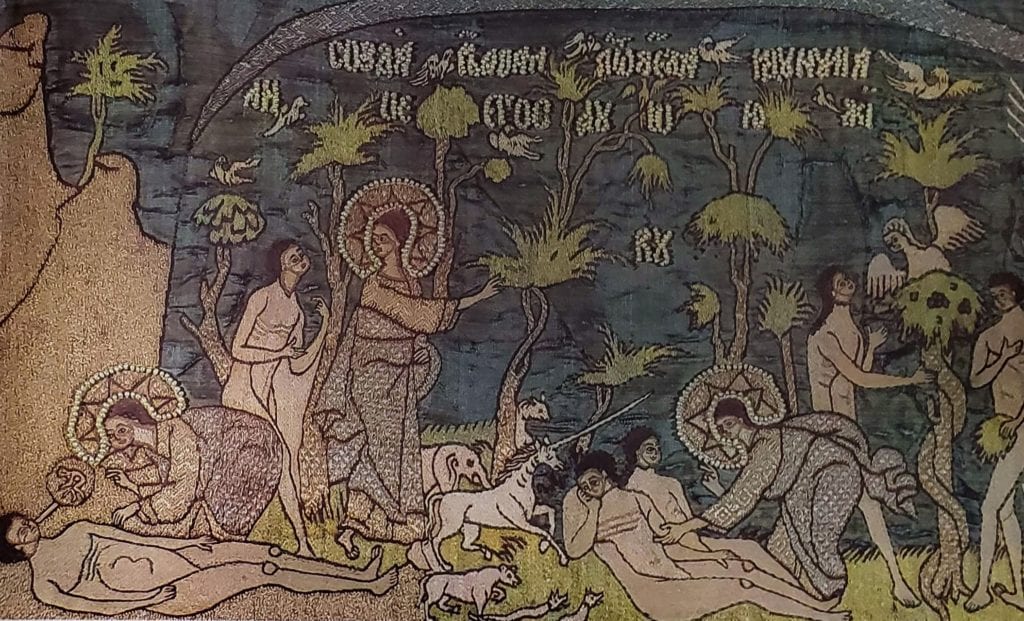
Illustration 53: The Presentation of the Tsaritsa

From the Trinity-Sergiev Lavra.
Zagorsk State Historic-Artistic Museum-Reserve (178).
Christ is depicted in the center on a throne, wearing the vestments of an archbishop. On either side stand the Holy Mother in princely robes, and John the Baptist; at their feet are Sts. Sergius and Nikon of Radonezh. The figures are worked in wrapped gold and silver thread with couching threads of thick multi-colored silk, creating various patterns. The hands and faces are embroidered with thin, twisted grey silk, with shading in a warmer tone. The outlines, folds of clothing, inscriptions, and other various details are outlined in pearls. The crowns and robes of Christ and the Holy Mother, as well as John’s halo, are decorated with precious stones. The ground is a Spanish burnt velvet.
- Svirin, A.N. Drevnerusskoe shit’jo. Moscow, 1963, pp. 108-110, illus. on p. 106.
- Majasova, N.A. “Literaturnyj obraz Kcenii Godunovoj i pripicyvaemye ej proizvedenija shit’ja.” Trudy Otdela drevnerusskoj literatury Instituta russkoj literatury Akademii nauk SSSR. Vol. XXII. Moscow/Leningrad, 1966, pp. 294-310, illus. on p. 305.
- Majasova, N.A. “Khudozhestvennoe shit’jo.” Troitse-Sergieva Lavra. Khudozhestvennye pamjatniki. Moscow, 1968, pp. 133, illus. 163-165.
- Nikolaeva, T.V. Sobranie drevnerusskogo iskusstva v Zagorskom muzee. Leningrad, (no date), illus. 81.
Illustration 54: The Appearance of the Archangel Michael to Joshua

From the Ss. Boris and Gleb Monastery near Rostov Velikij.
State Tretyakovskaya Gallery (20982)
The Archangel Michael is depicted to the left, holding a sword and mirror. On the right, Joshua removes his shoes; above him, in a semi-circle, is the Lord of Hosts with his hands raised in benediction. A text from the Bible is embroidered above, along the edge of the banner. This two-sided embroidery is worked in colored silk, gold and silver. The silk stitches are in split stitch and laid and couched in twisted threads of various thickness. The gold threads are worked in checkerboard and herringbone patterns, leaving sections of the ground fabric unembroidered. The original ground fabric, a red silk, has survived only in fragments. During restoration, the figures were transferred onto a red homespun. This item has received the nickname “Sapiega’s Standard.”
- Edinz, B. Rostov Velikij. Uglich. Moscow, 1913, p. 55.
- Antonova, V.I. Okhrannoe znamja Sapegi Doklad v GTG. 1946 g. (arkhiv GTG).
- Katalog khudozhestvennykh proizvedenij, nakhodjaschikhsja v ekspozitsii Tret’jakovskoj galerei. Moscow, 1947, p. 39.
- Istorija russkogo iskusstva. Vol III. Moscow, 1955, pp. 685-688, illus. on p. 685.
- Svirin, A.N. Drevnerusskoe shit’jo. Moscow, 1963, p. 92, illus. 89, 91.
Illustration 55: Metropolitan Jonah

From the Cathedral of the Assumption in the Moscow Kremlin.
State Museums of the Moscow Kremlin (12502op).
This depiction of Moscow Metropolitan Jonah is embroidered onto a light-blue damask. The face is worked in thin wound threads of grey silk in stem stitch following the direction of the design. His clothing is in wrapped gold and silver threads with thin silk couching stitches of various colors. A piece of tausine[151]jeb: A shade of blue mixed with cherry red, similar to the blue color on peacock feathers. This color was quite popular in medieval Russia. taffeta has been added below the saint’s feet. There is a liturgical inscription around the border. On the later silk lining, there is a piece of red brocade with the following inscription in gold: “This veil to the great saint of Christ Jonah, Metropolitan of Moscow and of all Rus’ the Miracle-Worker, was completed by order of Grigorij son of Dimitrij Stroganov, on the 30th day of March in the year 7165, in memory of our holy father Jonah the Miracle-Worker, Metropolitan of Moscow.”
Illustration 56: St. Nicholas, with Scenes of His Life

From the collection of A.S. Uvarov.
State Historical Museum (108-rb).
On the center of this podea is a half-length image of St. Nicholas, with Christ holding the Gospel and the Holy Mother holding an omophorion in frames on either side. The border has scenes from his life (running horizontally, from top to bottom):
- The Birth of St. Nicholas
- The Baptism
- Nicholas Heals a Woman on the Way to Lessons
- He is Admitted to Lessons
- Being Made a Deacon
- Being Made a Priest
- Visiting the Three Men in Prison
- Delivering the Convicts from Execution
- Rescuing Dmitrij from the Depths of the Sea
- The Return of the Son of Agrikov
- Carrying the Coffin with Nicholas
- Nicholas’ Funeral
Around the figures, there is a liturgical inscription. The podea is embroidered on crimson satin, primarily in gold and silver wrapped threads couched down with silk of various colors. The faces are of an unwound thin silk thread. The haloes in the center section are outlined in pearls. The ground fabric and explanatory inscriptions have many missing segments. The lower border has a fringe of yellow thread.
- Katalog sobranija drevnostej grafa Alekseja Sergeevicha Uvarova. Moscow, 1907. No. 24, pp. 168-169.
Footnotes
| ↟1 | The name “litsevoe” [literally “facial”] is assigned to this form of embroidery as a figurative art, due to its depiction of man, his face, and his surroundings, as opposed to ornamental embroidery. |
|---|---|
| ↟2 | jeb: Given that this term is almost exclusively used to discuss liturgical embroidery, I have interpreted this term as “ecclesiastical”. |
| ↟3 | Polnoe sobranie russkikh letopisej [PSRL]. Vol 2, St Petersburg, 1843, p. 127 |
| ↟4 | This restoration was organized in the early 1920s by the State Central Art Restoration Workshops [GTsKhRM] and their branch at the Trinity-Sergiev Lavra; in 1927, these works were displayed for the first time at the 3rd Restoration Exposition. The principal artisan-restorers of fabric and embroidery were: N.P. Shabel’skaja, T.N. Aleksandrova-Dol’nik, Ju.S. Karpova, K.N. Sishova, M.N. Rozhdestvenskaja, E.S. Vidonova, and A.D. Beljakova (Merkulova). Today, the restorers of the GTsKhRM and artisans at the nation’s most significant museums carry on this work through the use of new methods. |
| ↟5 | Makarenko, N. Iskusstvo Drevnej Rusi. U Soli Vychegodskoj. Petrograd, 1918, p. 91. |
| ↟6 | These are so named as these were the brightest and cleanest rooms in the house, retained specifically for these workshops. |
| ↟7 | Shlikhting, Al’bert. Skazanie. Leningrad, 1934, p. 33. |
| ↟8 | Zabelin, I.E. Domashnij byt russkogo naroda v XVI i XVII st. Tom II: Domashnij byt russkikh tarits v XVI i XVII st. Moscow, 1901, p. 399. |
| ↟9 | “Moskovskie letopisi Konrada Busova i Petra Petreja.” Skazanija inostrannikh pisatelej o Rossii. St. Petersburg, 1851, p. 308. |
| ↟10 | “Opis’ imuschestva obiteli Ksilurgu 6651 (1147) g.” Akty russkogo na svjatom Afone monastyrja sv. velikomuchenika i telitelja Pantelejmona.” Kiev, 1873(6), pp. 52-53. |
| ↟11 | Stasov, V.V. “Zametki o drevnej russkoj katapetazme.” Izvestija Imperatorskogo russkogo arkheologicheskogo obschestva (IAO). Vol. IV, St. Petersburg, 1863, pp. 534-541. |
| ↟12 | Prodolzhenie Drevnej Rosijskoj Vivliofiki. Part IV, St. Petersburg, 1790, No. 178, p. 3. |
| ↟13 | Domostroj Sil’vestrovskogo izvoda. St. Petersburg, 1902, cf. 64, 16, 20, 30, et.al. |
| ↟14 | ”Povest’ ob Ulijanii Osorinoj.” Russkaja povest’ XVII v. Moscow, 1954, pp. 40-41. |
| ↟15 | Izvestie anglichanina, byvshego pri starskom dvore v 1557-1558 gg.” Chtenija v Obschestve istorii i drevnostej Rossijskikh pri Moskovskom universitete (ChOIDR), Book 3, Moscow, 1884, p. 25. |
| ↟16 | jeb: yellow with a reddish tinge, orange |
| ↟17 | Starting in the 14th century, pure gold threads are rarely encountered. Instead, it was replayed by gilded silver. Such threads are typically called “gilt”. |
| ↟18 | About this technique, cf: Shabel’skaja, N.P. “Materialy i tekhnicheskie priemy v drevnerusskom shit’je.” Voprosy restavratsii. 1926(1), pp. 113-125; Kalinina, E.V. “Tekhnika drevnerusskogo shit’ja i nekotorye sposoby vypolnenija khudozhestvennykh zadach.” Russkoe iskusstvo XVII v. Leningrad, 1929, pp. 133-165. |
| ↟19 | jeb: gold or gilt silver was beaten into a foil, cut into thin strips, and then wrapped around a silk core. cf. modern so-called “Japan thread” |
| ↟20 | jeb: A city in Crimea on the Black Sea, today called Feodosia. |
| ↟21 | Jakunina, L.I. Russkoe shit’jo zhemchugom. Moscow, 1955, pp. 144-148. |
| ↟22 | Due to the nature and size of this publication, liturgical inscriptions are not presented in this work, and name inscriptions are given only where necessary to qualify a depiction. |
| ↟23 | Russkij biograficheskij slovar’. Vol. 2, St. Petersburg, 1900, p. 158. |
| ↟24 | Zabelin, p. 545 |
| ↟25 | Svirin, A.N. Drevnerusskoe shit’jo. Moscow, 1963, pp. 25-27. |
| ↟26 | IV vystavka «Restavratsija i konservatsija proizvedenij iskusstva.» Katalog. Moscow, 1963, p. 51. |
| ↟27 | Svirin, pp. 24-25, illus. on p. 27 |
| ↟28 | Today (since the 18th century?), the ground for both images is a lingonberry-colored satin. The two halves have been separated. |
| ↟29 | See Rostovo-suzdal’skaja shkola zhivopisi.” Katalog. Moscow, 1967. |
| ↟30 | D. Ainalov calls this item a “banner” and attributes it to the Novgorod school of the 14th century. (Ainalov, D. Geschichte der russischen Monumentalkunst zur Zeit der Grossfürstentums Moskau, Berlin, und Leipzig. 1933, p. 117) His attribution is seconded by V.N. Lazarev and A.N. Svirin. |
| ↟31 | This attribution was made in 1949 by request of the staff of the Zagorsk museum. |
| ↟32 | For example, in an epitaphios from the time of Andronicus II Palaeologus (Byzantine emperor 1282-1328) from the Church of St. Kliment in Okhrid. See: Miljukov, P.N. «Khristianskie drevnosti zapadnoj Makedonii.» Izvestija Russkogo Arkheologicheskogo instituta v Konstantinopole, Vol 1, Issue 1. Sofia. pp 93-94, illus. 30. |
| ↟33 | Now located in the Novgorod Museum [2130]. See: Svirin, A.N., p. 39 |
| ↟34 | One of these epitaphia was received from the Kirillo-Belozersk Monastery, now in the Russian Museum [281]; the other from the Arkhangelsk Medieval Repository, also now in the Russian Museum [280]. |
| ↟35 | V.N. Lazarev. Iskusstvo Novgoroda. Moscow-Leningrad, 1947, p. 130; A.N. Svirin, pp. 34-36. The author of this work also has determined these to be Novgorodian. See: N.A. Majasova. «Khudozhestvennoe shit’jo.» Troitse-Sergieva Lavra. Khudozhestvennye pamjatniki. Moscow, 1968, pp. 117-118. |
| ↟36 | cf. N.A. Majasova. «Pamjatniki moskovskogo zolotnogo shit’ja XV veka.» Drevnerusskoe iskusstvo. Khudozhestvennaja kul’tura Mosckvy i prilezhaschikh k nej knjazhestv XIV-XVI vv. Moscow, 1970, pp. 488-493. |
| ↟37 | This item has been incorrectly called “The Supreme One on His Throne” (cf. V.N. Lazarev, p. 129; A.N. Svirin, p. 27). These same authors also attribute it to 14th century Novgorodian art. |
| ↟38 | Cf. a throne cover, similar in composition, donated by the Godunovs to the Trinity-Sergiev monastery (illus. 53). |
| ↟39 | A.N. Svirin finds an analogy to the archangels in this work in mosaics of the latter half of the 13th century in the Church of San Gregorio in Messina (cf. A.N. Svirin, p. 27). |
| ↟40 | A Byzantine cameo from the 11th century with a bust depiction of Christ with the Evangelists is preserved in the Hermitage, with a Greek inscription: “IC XC OELENMON”; on the reverse, also in Greek: “Christ Our Lord, he who trusts in you shall not be deceived” (cf. A.V. Bank, Vizantijskoe iskusstvo v sobranijakh Sovetskogo Sojuza. Moscow-Leningrad, 1966, no. 167-168). |
| ↟41 | V.N. Lazarev, p. 75. Churches were also dedicated in Rus’ to the All-Merciful Savior. For example, a chapel is dedicated to him in the Transfiguration Cathedral in the Moscow Kremlin. The chronicles mention it in relation to the burial there in 1396 of Stefan of Perm. PSRL, vol. XI. Moscow, 1965, p. 164. |
| ↟42 | For example, a 12th century tiara from Kiev (cf. Istorija kul’tury Drevnej Rusi, Vol. 2. Moscow-Leningrad, 1951, p. 418), or the 12th century cuffs of Varlaam of Khutyn (cf. A.N. Svirin, p. 25). |
| ↟43 | jeb: Also known as the Image of Edessa, or Mandylion. |
| ↟44 | It is worth drawing our attention to the proportions of the figures of those standing before Christ, the elongated form of several of their heads, and on other details. |
| ↟45 | Marija was married in 1346; Simeon died in 1353 during a plague epidemic. |
| ↟46 | The researcher of medieval Russian flags, L. Jakovlev, notes that the first example of this depiction of the Savior’s face on banners, and even the first use of the word znamen’ (rather than the more ancient word stjag) for “flag,” is found in a description of the preparations for the Battle of Kulikovo in “The Doings and Tales of the Massacre of Dmitrij Donskoj”: “… And the Grand Prince, arrayed with his Polish soldiers … went out to the high place, and saw the image of Christ depicted on the Christian banners, shining like the sun.” (Drevnosti possijskogo gosudarstva. Addendum to the third edition. Moscow, 1865, p. 17) |
| ↟47 | Aside from these depictions, we also see embroidered here: the creator of the liturgy Gregory the Theologian, and, in an Orans pose with his hands raised in prayer, St. Alexius of Rome, whose Life was associated with the cult of the Savior Not Made By Hands. Contrary to the statement by the first researcher of this Aër, V. Trutovskij, about the image of the Savior being a supposedly later work (Khudozhestvennye sokrovischa Rossii. Vol 2. St. Petersburg, 1902, p. 125), detailed surveys have shown that the Savior was embroidered contemporaneously to the rest of the veil. |
| ↟48 | The 30 years separating the Sergius’s death (1392) and the creation of this veil do not preclude this possibility. |
| ↟49 | I.E. Grabar’. «Andrej Rubljov.» Voprosy restavratsii. Iss. 1. Moscow, 1926, p 71, illustration on p. 35; V.N. Lazarev. Andrej Rubljov i ego shkola. Moscow, 1966, p. 103; et. al. |
| ↟50 | S.S. Chudrakov. «Andrej Rubljov i Daniil Chjornyj.» Sovetskaja arkheologija. 1966 (1), p. 100. |
| ↟51 | In the literature, we frequently find the idea that the lead icon painter may have been the nephew of Sergius, Fedor, the archimandrite of the Simonov monastery; or they suggest it was Archbishop Rostovskij, who according to legend painted a likeness of Sergius while the latter was still alive. No works by Fedor have survived against which we could compare this veil, and we have only descriptions from the 17th century («Skazanie o sv. ikonopistsakh» from the so-called «Klintsovskij podlinnik» – cf. F.I. Buslaev, Literatura russkikh ikonopisnykh podlinnikov, Vol II. St. Petersburg, 1910, p. 396). As a result, the aforementioned theory seems, in our opinion, much more likely. |
| ↟52 | There is evidence that Prince Jurij’s wife embroidered the chasubles for Nikon of Radonezh and Savva of Storozhi (Archbishop Leonid. Zhizneopisanie pr. Savvy Storozhevskogo. Moscow, 1877, p. 12) |
| ↟53 | The iconostasis is stored in the Russian Museum [314-322] (cf. E. Kutilova, «Vnov’ restavrirovannyj pamjatnik XVI v.» Soobschenija Gos. Russkogo muzeja. Iss. 1. Leningrad, 1941, p. 17; Ju.N. Dmitriev. «K istorii odnogo pamjatnika.» Soobschenija Gos. Russkogo muzeja. Iss. 4. Leningrad-Moscow, 1956, p. 5) |
| ↟54 | A.I. Uspenskij. Zapisnye knigi i bumagi starinnykh dvortsovykh prikazov. Moscow, 1960, pp. 2, 15, 74-76. |
| ↟55 | cf. V.N. Lazarev. Andrej Rublev i ego shkola, illus. 178. |
| ↟56 | cf. V.N. Schepkin. «Pamjatnik zolotnogo shit’ja nachala XV v.» Drevnosti. Trudy IMAO. Vol. XV, issues 1-2. Moscow, 1894, pp. 35-68. The south-Slavic origin of the original work, according to V.N. Schepkin, can be seen in the inscription, and the name of the church from the last frame of the Life, which says “Annunciation” [«Blagoveschenie»]. |
| ↟57 | The name Konstantin was held by the son of Dmitrij Donskoj, who died childless in the Simonov monastery around 1440. But, his wife, who died in 1419, was named Anastasija. Whether or not he was subsequently married to another or who that second wife might have been is unknown. The names of the wives of other historical persons with this name are also unknown; for example, those of Prince Konstantin Vladimirovich of Rostov (died 1415) or Konstantin Dobrynskij. V.N. Schepkin’s supposition that Ogrofena was simply an artisan, and that the artist’s name is mentioned in the place of the donor, if they were not one and the same person, is not supported. |
| ↟58 | I.Ja. Profir’ev. Apokrificheskie skazanija o novozavetnykh litsakh i sobytiakh. St. Petersburg, 1890, pp. 136-148. |
| ↟59 | V.I. Lazarev. Andrej Rublev i ego schkola. illus. 152, 153, 154. |
| ↟60 | ibid., illus. 60, 90. |
| ↟61 | ibid., illus. 116. |
| ↟62 | This appellation is based on its size, similar to that of another embroidered “Trinity” from the Godunov workshop which is called a sudarium [sudar’] in the inventory of the Trinity-Sergiev Monastery from 1641 (pp. 96 and 96 obv.), but which in subsequent inventories was called a “veil [pokrovets] with the head of Sergej” (cf. archive of the Zagorsk Museum) |
| ↟63 | In the 18th century, the images were cut out along their edges and transferred onto a crimson velvet. During restoration in 1951, it was replaced with a rough blue crash. |
| ↟64 | This author does not agree with the opinion of V.I. Antonova, who dated this work to the very beginning of the 15th century and believes that the artist who drew this icon was Andrej Rublev himself, who created here the first draft of his “Trinity” («O pervohachal’nom meste “Troitsy” Andreja Rubleva.» Gos. Tret’jakovskaja galereja. Materialy i issledovanija. Issue 1. Moscow, 1956, pp. 26-30.) See the icons depicting this variant of the “Trinity” in the Andrej Rublev Museum: one from Borodava near Kirillov from 1486 [item 54], one from Volokalamsk from the 1480s [item 21], and one from Uglich [item 106] one from Aleksandrov from the early 16th century, et.al. |
| ↟65 | This impression is broken by the gaps in the original ground fabric, a brown damask which was replaced with a light blue rough fabric during restoration. |
| ↟66 | jeb: According to the tale, Ioasaf or Jehosaphat was a Prince of India whom Varlaam convinced to become a Christian. This story was quite popular in medieval Russia, and can be found on many icons. |
| ↟67 | N.A. Majasova. «Masterskaja khudozhestvennogo shit’ja knjazej Staritskikh.» Soobschenija Zagorskogo muzeja-zapovednika. Iss. 3. Zagorsk, 1960, p. 54. |
| ↟68 | Novgorodskie letopisi. St. Petersburg, 1879, p. 139. |
| ↟69 | The Kremlin Museums, no. 18652 op. The name of the “Puchezh” Epitaphios comes from the town of Puchezh, in the Novgorod region, where it was discovered in 1930. It has been published many times (cf. Der Moskauer Kreml die Rüstkammer. B.A. Rybakov und Mitarbeiter. Prague, 1962, illus. 86, 87). |
| ↟70 | jeb: See my translation of an article about this work, along with photographs: The Puchezh Epitaphios of 1441 and Novgorodian Embroidery in the Time of Archbishop Euphemius II |
| ↟71 | This item is now in the Novgorod museum [2132] (cf. A. Svirin. “Une broderie du XV siécle de Style pittoresque.” L’art byzantine chez les slaves. Paris, 1932, table X.2; A.N Svirin. Drevnerusskoe shit’jo, p. 38). |
| ↟72 | The “Row” was located in the Trinity-Sergiev Lavra and is listed in the earliest surviving inventory, from 1651. The fact that Euphemius II was well known as an opponent of Moscow, it would seem, should have precluded it from being donated to a monastery in the Moscow region. It is possible, however, that it was a reciprocal gift for the epitaphios of Grand Prince Vasilij II the Blind, the inscription of which specifically mentions its addressee – Archbishop Euphemius. It is also possible that the “Row” came to the monastery among other works of art captured from Novgorod by Ivan the Terrible. The “Row” has not survived in its entirety. The lower part of the figures is cut off, the border which, most likely, contained the donor inscription is missing. |
| ↟73 | jeb: The Deësis Row is a part of the iconostasis in an Orthodox Christian church. It is typically located immediately over the Royal Door through the iconostasis, with Christ sitting immediately over the door, flanked by the Virgin Mary and John the Baptist, often along with other saints or angels depicted in full-length. In this case, the Deësis Row was presumably part of a larger embroidered iconostasis. |
| ↟74 | In their honor, Euphemius II built and decorated two churches: in 1439, the Church of St. John the Theologian in Vjazitskij Monastery, and in 1445, a chapel to Euthymius the Great in the entry hall of his palace. |
| ↟75 | Two epitaphia in this “pictorial” style are stored in the Novgorod Museum [2131, 2097]. One one of them, amongst the images on the border, are embroidered the Novgorodian saints Nicetas the Goth and Jonah, who it would seem were the name day saints of the donor-martyrs Kondratij and Tat’jana. One more less skillfully-worked epitaphios is stored in the Russian Museum [195]. |
| ↟76 | D. Ainalov. Geschichte der russischen monumentalkunst zur Zeit des Grossfürstentums Moskau. Berlin and Leipzig, 193, p. 117. |
| ↟77 | The same sprigs with fringed leaves as on the last columns in the “Row” are also found on the mid-15th century Novgorodian icon “Daniil in the Lion’s Den” (Novgorodskij istoriko-arkhitekturnyj muzej-zapovednik. Leningrad, 1963, pp. 10, 30). Here too, the leaves have the same gradation of color from dark blue to light blue and white. The similarity between the “Row” and this icon can also be seen in how the clothing and various details of the figure of Daniel have been worked. It is possible that here we have two works from artists from the same school. |
| ↟78 | V.I. Antoneva, N.E. Mneva. Katalog drevnerusskoj zivopisi. Vol. 1. Moscow, 1963, Nos. 102 (illus. 73), 106 (illus. 76). |
| ↟79 | ibid., No. 101 (illus. 79). |
| ↟80 | Istorija russkogo iskusstva. Vol 3. Moscow, 1955, p. 500. |
| ↟81 | For example, the dying Grand Prince Vasilij III appealed to her. (PSRL, Vol. VI, 1853, p. 273) |
| ↟82 | Novgorodskie letopisi. St. Petersburg, 1879, p. 304. |
| ↟83 | jeb: By this time, Novgorod’s population had grown larger than it could support, and it became dependent on Vladimir to feed its people. The princes of Moscow used this dependence to gain control over its lands, and eventually Ivan III annexed the city to the Grand Duchy of Moscow in 1478, disbanding the Veche and seizing the Hanseatic League goods stored there. |
| ↟84 | In this subject, it is more common for the people to be placed facing toward Catherine, praying to her (V.I. Antonova, N.E. Mneva. Katalog drevnerusskoj zhivopisi. Vol. 2, No. 443.). A depiction of the people similar to that in our podea, with them praying together the Catherine, is seen in a Novgorod icon from the mid-16th century (ibid., No. 361). |
| ↟85 | This is attested by a conversation he had in 1496 with his younger brother, Feodor. (Sobranie gosudarstvennykh gramot i dogovorov [SGGD], Part 1. Moscow, 1813, No. 127, p. 32) |
| ↟86 | The cult of St. Vladimir arose in Novgorod shortly after 1240, and seems to have spread to Tver’ earlier than it finally reached Moscow. |
| ↟87 | Credit for the dating of this podea and the determination of the persons depicted upon it belongs to M.V. Schepkina. («Izobrazhenie russkikh istoricheskikh lits v shit’je XV v.» Trudy GIM, Issue 12, Moscow, 1954). |
| ↟88 | An image of the Hodegetria icon by Dionysius can be seen in: V.I. Antonova, N.E. Mneva, Vol. 1, No. 274, Illus. 214. |
| ↟89 | jeb: A picture of this icon can be seen online at https://painting-planet.com/the-virgin-hodegetria-by-dionysius/. |
| ↟90 | Stefan of Novgorod, having been in Constantinople in 1348-1349, thus describes an icon of the Hodegetria revered there: “And one man stands in the secret place with his shoulders raised and he spreads his hands as if crucified, and he raises his eyes… and then another will replace him, and they sing a holy song with the deacon.” (M.N. Speranskij. Iz starinnoj novgorodskoj literatury XIV v. Leningrad, 1934, p. 54; the full description is given in M.V. Schepkina, p. 14). |
| ↟91 | M.V. Schepkina includes in her work the oral tradition of the restorers, E. Brjagina and E. Chirikova, about the origin of a podea from Moscow’s Cathedral of the Dormition which is quite possible given that, aside from the image upon it which is tied to that cathedral, in medieval times (1327), a chapel was built there to Dmitrij Solunskij, name day saint of Elena Voloshanka’s son (this saint and his goodness are also depicted in the Kremlin’s Cathedral of the Archangel.) |
| ↟92 | Elena died in 1505, Dmitrij in 1509. |
| ↟93 | V.V. Filatov believes this legend was started between 1490 and 1505, existed for some time as an oral palace tale, and was subsequently (by 1542) recorded by Metropolitan Ioasaf, the former leader of the Trinity-Sergiev Monastery. (V.V. Filatov. «Ikona s izobrazniem sjuzhetov iz istorii Russkogo gosudarstva.» Trudy Otdela drevnerusskoj literatury Instituta russkoj literatury Akademii nauk SSSR [TODRL]. Vol 22. Moscow/Leningrad, 1966, pp. 280-281) |
| ↟94 | PSRL, Vol 12. Moscow, 1965, p. 191. |
| ↟95 | ”The Descent of the Holy Spirit upon the Apostles” is celebrated the day after the “The Trinity.” In honor of the Day of the Spirit, a church was built at the Trinity-Sergiev Monastery in 1476-1477. |
| ↟96 | In medieval Rus’, a child was often given two names, one after a saint based on the day of his birth, and a second choosingly, typically after one of the saints for any one of the eight days after the date of birth, but this could be extended. (N.N. Kharuzin. «K voprosu ob upotreblenii nekalendarnykh imen v dopedrovskoj Rusi.» Sbornik Istoriko-filologicheskogo obshestva pri Institute kn. Bezborodko v Nezhine. Vol 2, Issue 2. Nezhin, 1899.) |
| ↟97 | Vasilij was born the day after Annunciation, the 26th of March, in the Cathedral of the Archangel Gabriel. Vasilij’s veneration of the holiday of the Ascension is attested by his construction of churches dedicated to that holiday in the Ascension Monastery and in the village of Kolomensk. |
| ↟98 | For example, the icon “The Heavenly Father and Selected Saints” from the second half of the 14th century in the Tretyakovsky Gallery (V.I. Antonova, N.E. Mneva. Vol. 1, No. 25, p. 94, Illus. 46). This source also mentions the 12th century icon of the Annunciation from Antoniev Monastery in Novgorod (ibid., example 1 on page 94). |
| ↟99 | L.S. Retkovskaja notes that “at this time, there was active implementation of this composition in all forms of art, in connection with the struggle, as in the 14th century, against newly raised heresies.” (L.S. Retkovskaja. Vselennaja v iskusstve Drevnej Rusi. Moscow, 1961, p. 13) See also: V.N. Lazarev. «Ob odnoj novgorodskoj ikone i eresi antitrinitariev.» Kul’tura Drevne Rusi. Moscow, 1966, which justifies the rise of this subject in Novgorod art of the late 14th century in connection with the Strigol’niki heresy. In Byzantium, this composition of “The Heavenly Father” was known starting in the 11th century. |
| ↟100 | A.N Svirin, pp. 59-61. It is worth noting, however, that on two examples of Italian embroidery from the 16th century stored in the Hermitage, decorated with scenes from the Old Testament and the 12 months of the year, this technique has a different artistic significance. Here the background is almost completely covered, on one in red and the other green silk. The images remained unembroidered, and them, white linen is embroidered with dots of the ground fabric color. (A.S. Verkhovskaja. Zapadnoevropejskaja vyshivka XII-XIX vekov v Ermitazhe. Leningrad, 1961, illus. 31-34.) |
| ↟101 | Similar multicolored dots also decorate several other works, undoubtedly from the same workshop. These are two veils [360, 370] and a cuff [371] from the Zagorsk Museum, a veil with the “Crucifixion” in Vladimir, and fragments of embroidery with images of saints in the Russian Museum [26]. |
| ↟102 | V.I. Antonova, N.E. Mneva. No. 228, illus 186. See also the icons attributed to Dionysius in the Cathedral of the Assumption in the Moscow Kremlin, and in the Andrej Rublev Museum (from the town of Dmitrovo). |
| ↟103 | There is a hypothesis that she came from the line of Princes Shujskij and that she was buried with the monastic name of Aleksandra in Suzdal’s Pokrovskij Monastery. (T.V. Nikolaeva. «O nekotorykh volokolamskikh drevnostjakh.» Drevnerusskoe iskusstvo. Khudozhestvennaja kul’tura Moskvy i reilezhaschikh k nej knjazhestv. XVI-XV v. Moscow, 1970, p. 374.) |
| ↟104 | PSRL, Vol. 20, St. Petersburg, 1910, p. 381. |
| ↟105 | Fjodor Borisovich died childless in 1513, due to which his land was annexed by Moscow. |
| ↟106 | Iosif Volotskij complained to the grand prince that Prince Fjodor “will notice an icon or a book of masterful illumination, and will ask to take it” (Poslanija Iosifa Volotskogo. Moscow-Leningrad, 1959, p. 211); in the “Life of Iosif,” it also recounts that in order to win over the prince, he “sent him icons by Rublev and paintings by Dionisius. (Bish. Savva Krutitskij. Zhitie prep. Iosifa Volokolamskogo. Moscow, 1880, p. 40). |
| ↟107 | Both podeai were likewise donated in 1510 to the Cathedral of the Resurrection in Volokolamsk. In 1927, there were presented at a restoration expo (III restavratsionnaja vystavka TsGRM, Moscow, 1927, p. 29, No. 51 and 52), but then all trace of them was lost. In 1959, the podea of the “Praise to the Holy Mother” was discovered by us in the Moscow Regional Museum in Istra, from whence it was transferred to the Zagorsk Museum. The Regional Museum in Istra also has the second podea, “Christ with the Apostles” or “The Apostles Bound by a Union of Love.” This author has a photograph from the photo library of the State Historical Museum, on which it is possible to read fragments of the inscription. See also: T.V. Nikolaeva. O nekotorykh volokolamskikh drevnostjakh. |
| ↟108 | It is worth noting here as well other characteristics which recall the art of the South Slavs. The architectural forms in the center section of the podea with the “Resurrection” are similar to a fresco in Ferapontov Monastery, and also are very similar to a painting from 1407-1413 from a church in the Serbian monastery in Kalenic (Svetozar Radojgic. Kalenic. Belgrad, 1964, illustrations 4 and 22). The prince’s appelation of “master” [gospodar’] also saw usage in Russia before Ivan III and Vasilij III, and also has south Slavic (Moldovlachian) origins. |
| ↟109 | We should note that this is the earliest and only documentary evidence pre-17th century of an head artist of a Russian embroidered item. Written sources also mention the name of Posnik Dmitriev, son of Rostovets, who in 1584 designed a veil for the tomb of Ivan the Terrible; this veil does not have any “ecclesiastical” embroidery. “Worldly” graves were decorated with veils decorated with the Cross of Golgotha. They were also decorated with crosses made of beads, typically with pearls. (I.E. Zabelin, p. 723). About Posnik Dmitrieva, see: V.I. Antonova. «Moskovskij ikonnik Posnik Dermin.» Kul’tura i iskusstvo Drevnej Rusi. Sbornik v chest’ M.K. Kargera. Leningrad, 1967, pp. 144-152. |
| ↟110 | The Historical Museum houses a podea with a depiction of Nikita of Novgorod and Metropolitan Petr [2659 rb]; in the Museums of the Moscow Kremlin, there is a podea depicting “Archbishop Ioann of Novgorod;” in Novgorod, there are two halves of flags, with one depicting St. George the Victorious [1973], and on the other Nicholas, St. John the Theologian, and Euphemius of Novgorod. [1990] |
| ↟111 | The Aër itself has not survived. Its inscription is given here: Archbishop Leonid. Nadpisi Troitse-Sergievoj lavry. St. Petersburg, 1881, p. 32, No. 82. |
| ↟112 | This veil is stored in the Russian Museum [306]. |
| ↟113 | jeb: An image of this podea can be seen online at https://kirillbelozersky.ru/icons/licevoi-pokrov-prepodobnyi-kirill-belozerskii-1514-g |
| ↟114 | V.I. Antonova. «Moskovskaja ikona nachala XIV. v. iz Kieva i “Povest’ o Hikole Zarajskom”.» TODRL. Vol. 8. Moscow-Leningrad, 1957, pp. 375-392. The depiction of St. Nicholas of Mozhajsk is known starting in the 14th century. The appearance of this iconography is tied to the ancient tradition that he appeared as a vision in this form during an invasion of Mozhajsk by enemies. |
| ↟115 | Works from Anastasia Romanovna’s workshop are found today in many museums. Amongst these, it is worth noting a very pictorial veil depicting the Cross on Golgotha in the Zagorsk museum [404][jeb: see image here], the “Metropolitan Iona” veil in the Museums of the Moscow Kremlin [12204 op][jeb: see image here], a epitaphios with an original composition in Pskov [1256], the “St. Cyril of Belozersk” veil in the Russian Museum [293][jeb: see image here], and also a curtain for the Royal Gates (catapeteasma) depicting “The Presentation of the Princess” with saints on the border, given by Ivan the Terrible and Anastasia in 1556 to the Hilandar Monastery on Mt. Athos in Greece. |
| ↟116 | «Zhitie Nikity Stolpnika.» Gos. Publichnaja biblioteka im. M.E. Saltykova-Schedrina [GPB]. No. 1612, 17th cent., p. 29). |
| ↟117 | I.N. Zhdanov. «Sochinenija tsarja Ivana Vasil’evicha.» Sobranie sochinenija. Vol. 1. Moscow, 1904, p. 101. |
| ↟118 | V.I. Antonova, N.E. Mneva. Vol 2, illus. 44 |
| ↟119 | jeb: Where the Goritskij Monastery is located. |
| ↟120 | N.A. Majasova. «Masterskaja khudozhestvennogo shit’ja knjazej Staritskikh.» Soobshenija Zagorskogo muzeja-zapovednika. Issue 3. Zagorsk, 1960, pp. 41-64. |
| ↟121 | Aside from the epitaphios mentioned here from the Trinity Monastery, these have survived: an epitaphios from 1561 (in the Cathedral of the Assumption in Smolensk), an epitaphios from 1565 (in the Russian Museum [285]), a podea with “The Appearance of the Holy Virgin to St. Sergius” (in the Zagorsk Museum [5423]), a podea with “The Assumption of the Holy Virgin” (in the State Historical Museum [86 rb]), and several other works. |
| ↟122 | This artistic device, resurrected after a hundred years from the Novgorod “picturesque style” by Evfrosin’ja’s workshop, was the basis for hypothesizing that the artist who drew this epitaphios was from Novgorod. (T.N. Aleksandrova-Dol’nik. «Shit’je moskovskoj masterskoj XVI v.» Voprosy restavratsii. 1926 (1), Moscow, p. 131.) But, this also could be the direct influence of Euphemius’s Deësis Row [Illustration 17], which was located in the Trinity-Sergiev Monastery. |
| ↟123 | G.D. Filimonov. Ikonopisnyj podlinnik svodnoj redaktsii SVIII v. Moscow, 1876, p. 262. |
| ↟124 | P. Stroev. Spiski ierarkhov i nastojatelej mosastyrej Rossijskija tserkvi. St. Petersburg, 1877, p. 65. The veil depicting Euphemius II is stored in the Novgorod Museum [8089]. |
| ↟125 | jeb: An image of this veil depicting Euphemius II can be seen here online. |
| ↟126 | «Sokraschennyj vremennik.» Materialy po istorii SSSR. Vol. 2. Moscow, 1955, p. 148. |
| ↟127 | In 1606, at the same time as her husband, she was forced to enter the convent and given the name Aleksandra. Under this year, we find her entry in the Donor Book of the Trinity-Sergiev Monastery (Zagorskij musej. Vkladnaja kniga. 1673, p. 110). She was also buried in Simonov Monastery, in 1607. |
| ↟128 | N.V. Lileev. Simeon Bekbulatovich, khan kasimovskij, velikij knjaz’ vseja Rusi, vposledstvii velekij knjaz’ Tverskoj. 1567-1616 gg. Tver’, 1891. |
| ↟129 | Novgorod Museum [1988], described by A.N Svirina in: Drevnerusskoe shit’jo. pp. 122-124 (dated as a Novgorod work from the 17th century). The two sides of the banner were separated in modern times. |
| ↟130 | jeb: An image of this reverse side of the banner can be seen online here: https://novgorod-iss.kamiscloud.ru/entity/OBJECT/101069?fund=12&index=27 |
| ↟131 | This icon is in the Andrej Rublev Museum [261]. See: M.E. Daen. «Novootkrytyj pamjatnik stankovoj zhivopisi epokhi Ivana Grosnogo.» Drevnerusskoe iskusstvo. Khudozhestvennaja kul’tura Moskvy i relezhaschikh k nej knjazhestv. XIV-SVI vv. Moscow, 1970, pp. 207-225. For the icon in the Tretyakovskaya Gallery, see: V.I. Antonova, N.E. Mneva. Vol 1, illus. 233. |
| ↟132 | jeb: This icon from the 1560s can be seen online here: https://www.icon-art.info/masterpiece.php?lng=ru&mst_id=467 |
| ↟133 | This is attested by the numerous psalters and other books with ownership inscriptions by Dmitrij Godunov, and amongst his donations one finds items such as the 15th century crystal chalice in the Zagorsk Museum. |
| ↟134 | jeb: The crystal chalice mentioned in the footnote can be seen on the right in this photograph: https://commons.wikimedia.org/wiki/File:Chalices_(Sergiev_Posad)_by_shakko_02.jpg |
| ↟135 | Perepisnye knigi Kostromskogo Ipat’evskogo monastyrja 1595 goda. Moscow, 1890, pp. 16-19. |
| ↟136 | jeb: An image of this epitaphios can be seen online here: http://ubrus-ru.narod.ru/pl.jpg |
| ↟137 | Archbishop Makarij. «Vklady Gdunovykh v Ipat’evskom monastyre.» Izvestija IAO. Vol 3. St. Petersburg, 1861, p. 233. |
| ↟138 | See, for example: V.I. Antonova, N.E. Mneva. Katalog drevnerusskoj zhivopisi. Vol II, illus. 48. |
| ↟139 | «Povest’ knjazja Ivana Mikhajlovicha Katyreva-Rostovskogo.» Russkaja istoricheskaja biblioteka. Vol. 13. St. Petersburg, 1909, p. 621. |
| ↟140 | N.A. Majasova. «Literaturnyj obraz Ksenii Godunovoj i pripisyvaemye ej proizvedenija shit’ja.» TODRL. Vol. 22, Moscow-Leningrad, 1966, pp. 294-310. |
| ↟141 | For example, these artists also painted a panel with the “deeds” of the Trinity, donated in 1600 by Boris Godunov to the Trinity-Sergiev Monastery (Zagorsk Museum [393]). One of the most vivid exponents of this school, Prokopij Chirin, painted an icon with the name day saints of the Boris Godunov family (V.I. Antonova, N.E. Mneva, Vol. 2, illus 118.) |
| ↟142 | jeb: The panel with the Deeds of the Trinity can be seen online here: http://gorod-zagorsk.ru/pic/mess050pic556.jpg |
| ↟143 | The Stroganov name has primarily survived to date on icons of a particular style, which led to that style being called the “Stroganov school” of art. |
| ↟144 | This epitaphios is stored in the Rjazan’ Regional Museum [3517]. More information about its creation can be found in the Accounts Book of the Bishop’s House under the year 1687. (K.N. Tikhonravov. «Svedenija o russkikh masterakh XVII i nachala XVIII v.» Izvestija IAO. Vol 3. St. Petersburg, 1861, p. 216) |
| ↟145 | This legend is told in «Zhitie Irinarkha zatvornika rostovskogo,» written in the 17th century. (A lecture by V.I. Antonova in 1946, «Okhrannoe znamja Sapegi», Archive of the State Tretyakovskaya Gallery.) |
| ↟146 | Evidence of this can be found in the inscription on a podea depicting the Tsarevich Dmitrij. For more about Stroganov embroidery, see: E.V. Georgievskaja-Druzhinina. «Stroganovskoe shit’jo.» Russkoe isksstvo XVII v. Leningrad, 1929, pp. 109-133. |
| ↟147 | I.E. Zabelin, pp. 723-729 |
| ↟148 | I.E. Zabelin, p. 727. The epitaphios is stored in the Museums of the Russian Kremlin [12608 op]. |
| ↟149 | The inscription on a Zagorsk epitaphios by I.I. Golitsyna attests that it was started in 1595, and finished in 1598. (The Zagorsk Museum, no. 2425.) |
| ↟150 | jeb: The author means here that the couching stitches are of the same color as the gold. |
| ↟151 | jeb: A shade of blue mixed with cherry red, similar to the blue color on peacock feathers. This color was quite popular in medieval Russia. |


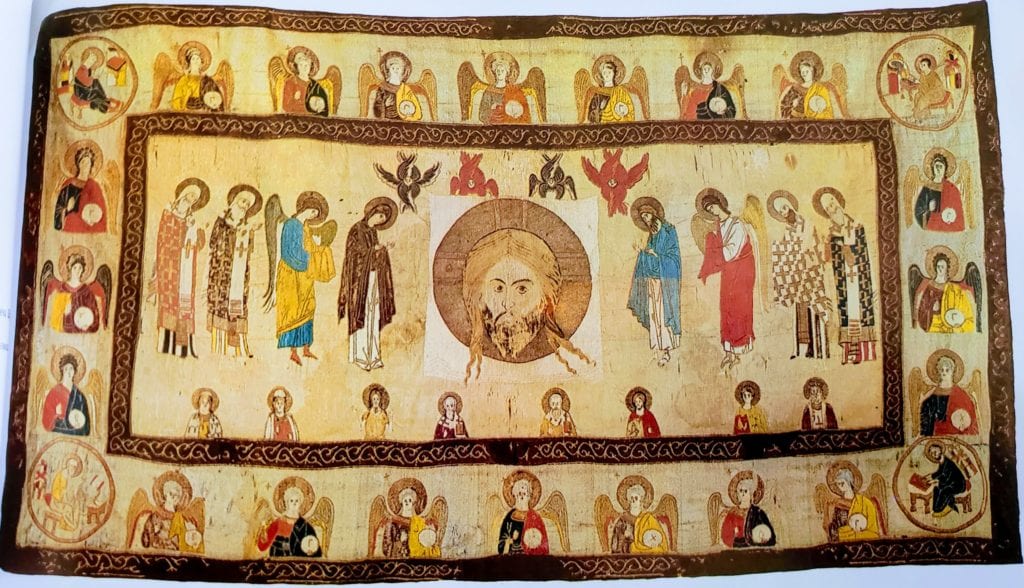
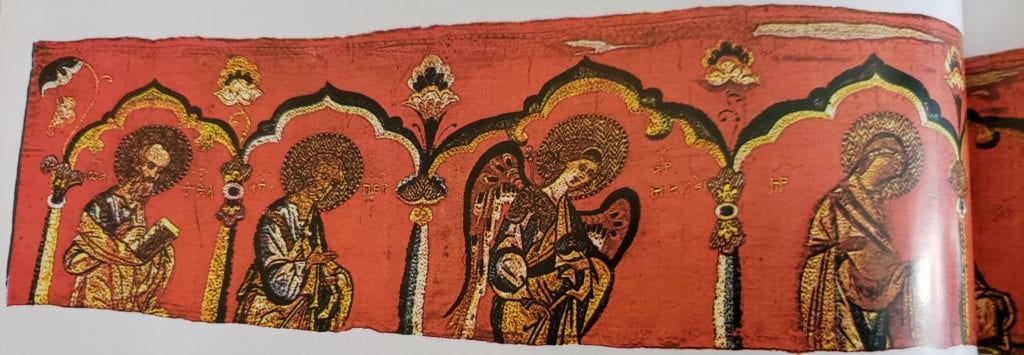
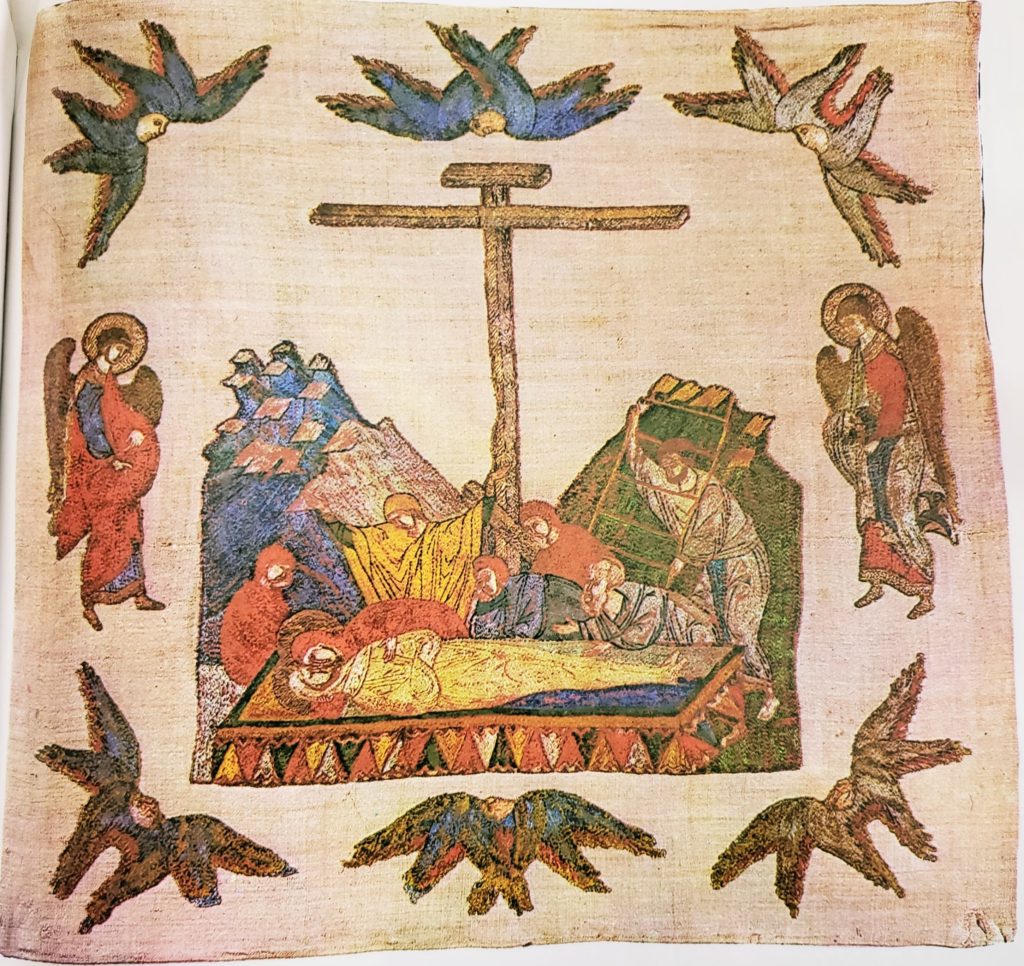
2 Replies to “Medieval Russian Embroidery (Majasova, 1971)”